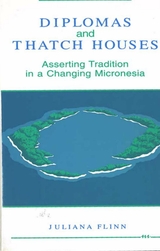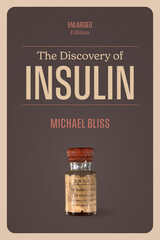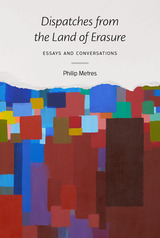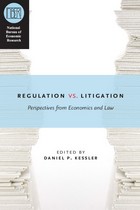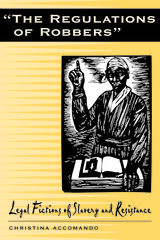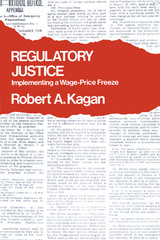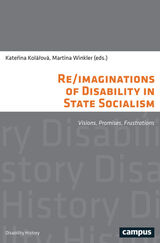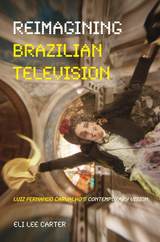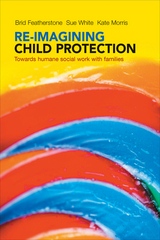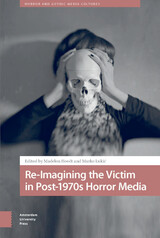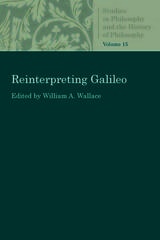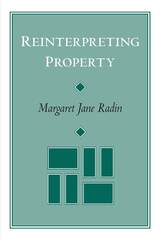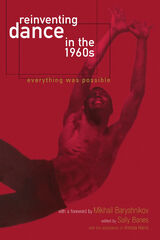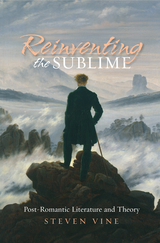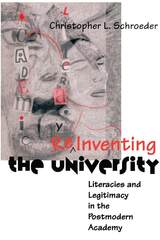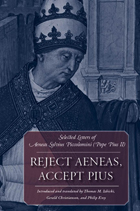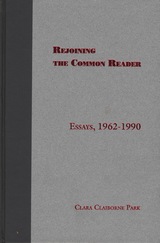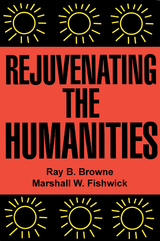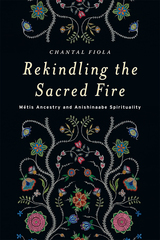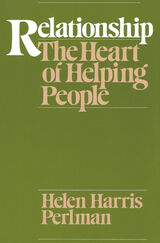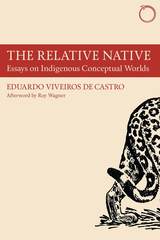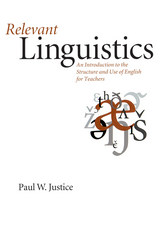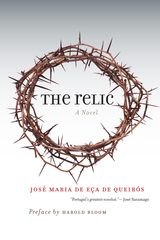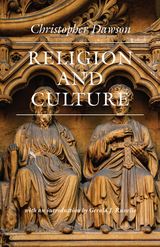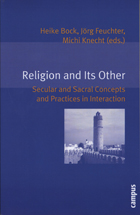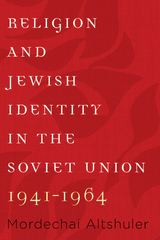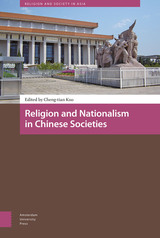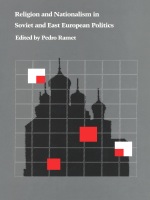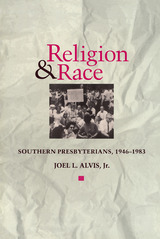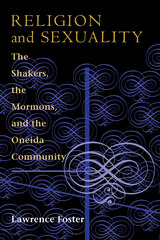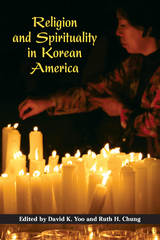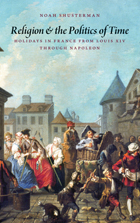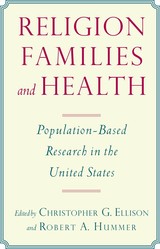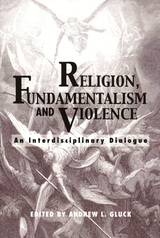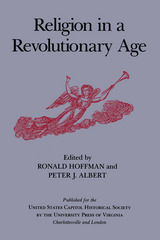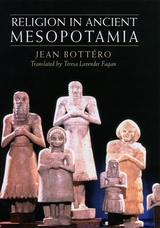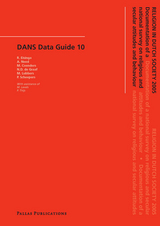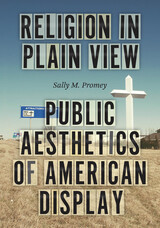 Regulation and Its Reform
Stephen Breyer
Harvard University Press, 1982 This book will become the bible of regulatory reform. No broad, authoritative treatment of the subject has been available for many years except for Alfred Kahn’s Economics of Regulation (1970). And Stephen Breyer’s book is not merely a utilitarian analysis or a legal discussion of procedures; it employs the widest possible perspective to survey the full implications of government regulation—economic, legal, administrative, political—while addressing the complex problems of administering regulatory agencies.
Only a scholar with Judge Breyer’s practical experience as chief counsel to the Senate Judiciary Committee could have accomplished this task. He develops an ingenious original system for classifying regulatory activities according to the kinds of problems that have called for, or have seemed to call for, regulation; he then examines how well or poorly various regulatory regimes remedy these market defects. This enables him to organize an enormous amount of material in a coherent way, and to make significant and useful generalizations about real-world problems.
Among the regulatory areas he considers are health and safety; environmental pollution, trucking, airlines, natural gas, public utilities, and telecommunications. He further gives attention to related topics such as cost-of-service ratemaking, safety standards, antitrust, and property rights. Clearly this is a book whose time is here—a veritable how-to-do-it book for administration deregulators, legislators, and the judiciary; and because it is comprehensive and superbly organized, with a wealth of highly detailed examples, it is practical for use in law schools and in courses on economics and political science.
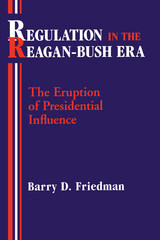 Regulation in the Reagan-Bush Era: The Eruption of Presidential Influence
Barry D. Friedman
University of Pittsburgh Press, 1995 This timely and well-researched study describes for the first tim ethe astonishing acquiecence of executive agency officials, members of Congress, and federal judges to Ronald Regan's assertion of extraordinary new presidential power over the federal regulatory process--the controversial Executive Order 12291.
From Harry Truman through Jimy Carter, chief executives complained that federal bureaucrats disregarded their policy preferences. presidential influence over regulatory rule making was limited: congressional committees and interest groups commanded more attention. Then in February 1981 Ronal regan abruptly departed from tradition by ordering that regulatory agencies must submit proposed guidelines for Office of Management and Budget approval.
Barry D. friedman describes how the executive agencies and Congress responded warily and with skepticism, yet allowed the changes to remain; the judiciary was also willing to retreat from time-honored precedents that had preserved agency prerogative and now accorded due respect to the revolutionary Regan reform initiatives. Institutions that competed for leverage in the system continued to exercise restraint in their mutual relations because they recognized taht all benefitted from the others' viability.
This book shows that conventional political science theories and models are now obsolete because of the eruption of presidential control into bureaucratic affairs. new review procedures have restructured relations between the president and the agencies and among the government's three branches. because of Regan's radical initiative, President Bill Clinton and his successors will sit at the bargaining table when regulation policy is developed in Washington, and political theorists will have to work from a new conception of presidential prerogative.
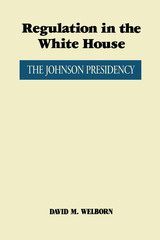 Regulation in the White House: The Johnson Presidency
By David M. Welborn
University of Texas Press, 1993 Regulation in the White House is an examination of regulatory policy and its development in the Johnson administration and the first comprehensive study of any presidency and regulation. Based upon a thorough analysis of presidential papers in the Lyndon B. Johnson Library, the book investigates the working relationships linking the presidency, regulatory commissions, and executive agencies with regulatory responsibilities in both the economic and social spheres. David Welborn finds that the president's business included regulation as a major component. Johnson's concerns in regulation were varied and complex. He and his aides worked assiduously and successfully to establish effective, cooperative relationships with regulators and to avoid the exercise of undue influence on particular regulatory determinations. In Welborn's view, Johnson traversed the treacherous ground of regulatory politics with adeptness and achieved his major purposes in regulation.
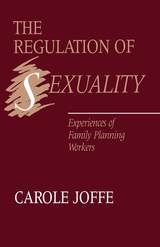 The Regulation of Sexuality: Experiences of Family Planning Workers
Carole Joffe
Temple University Press, 1987 "Joffe takes us from the most private aspects of sexuality into the arena of public policy and state regulation."
--Carroll Smith-Rosenberg
"The author convincingly argues that the Federal Government, the feminist movement and the New Right fail to adequately address the often wrenching conflicts faced daily by birth control and abortion workers. [These conflicts] have spurred many family planning workers to construct and implement a wholly unauthorized vision of family planning policy, one that melds pure ideology with the complicated truths of individuals' social and sexual lives.... [Joffe] makes a cogent and finely nuanced case for the wisdom-indeed, the necessity- of this vision."
--Marian Sandmaier, New York Times Book Review
"A psychosocial presentation at its best, the book probes and illuminates the workers' whole environment, documenting their need for status and engagement to offset meager pay and enervating routine and their need to balance sexual liberalism with concern for immature, vulnerable women. A valuable resource that clarifies human service programs as a whole."
--Library Journal
"A wonderfully alive and readable ethnographic study."
--The Women's Review of Books
Regulation versus Litigation: Perspectives from Economics and Law
Edited by Daniel P. Kessler
University of Chicago Press, 2010 The efficacy of various political institutions is the subject of intense debate between proponents of broad legislative standards enforced through litigation and those who prefer regulation by administrative agencies. This book explores the trade-offs between litigation and regulation, the circumstances in which one approach may outperform the other, and the principles that affect the choice between addressing particular economic activities with one system or the other. Combining theoretical analysis with empirical investigation in a range of industries, including public health, financial markets, medical care, and workplace safety, Regulation versus Litigation sheds light on the costs and benefits of two important instruments of economic policy.
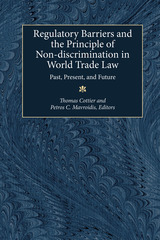 Regulatory Barriers and the Principle of Non-discrimination in World Trade Law: Past, Present, and Future
Thomas Cottier and Petros C. Mavroidis, Editors
University of Michigan Press, 2000 The University of Michigan Press is pleased to announce the second volume in an annual series, the World Trade Forum. The Forum's members include scholars, lawyers, and government and business practitioners working in the area of international trade, law, and policy. They meet annually to discuss integration issues in international economic relations, focusing on a new theme each year.
The World Trade Forum 1998 deals with the issue of regulatory barriers. Contributors focus their attention on the implications that government intervention has on the principle of nondiscrimination, the cornerstone of the World Trade Organization. The chapters, which cover both the positive and the normative level, deal in particular with the issue of "like product" definition, and with mutual recognition agreements. The relevant WTO case law is presented and analyzed, and the roundtable discussions are primarily aimed at clarifying to what extent a constitutional function should be assigned to the WTO organs, if at all.
Contributors include: Christoph Bail, Jacques Bourgeois, Marco Bronckers, Thomas Cottier, William Davey, Paul Demaret, Piet Eeckhout, Crawford Falconer, Olivier Guillod, Meinhard Hilf, Gary Horlick, Robert Howse, Robert Hudec, Patrick Low, Aaditya Mattoo, Petros C. Mavroidis, Patrick Messerlin, Damien Neven, Kalypso Nicolaidis, David Palmeter, Ernst Ulrich Petresmann, Andre Sapir, and Michel Waelbroeck.
Thomas Cottier is Professor of Law, Institute of European and International Economic Law, University of Bern Law School. Petros C. Mavroidis is Professor of Law, University of Neuchâtel.
Regulatory Justice: Implementing a Wage-Price Freeze
Robert A. Kagan
Russell Sage Foundation, 1978 Regulatory Justice is based on a case study of two closely linked federal agencies—the Cost of Living Council (CLC) and the Office of Emergency Preparedness (OEP)—which administered a nationwide wage-price freeze in 1971.
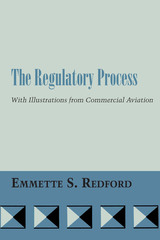 The Regulatory Process: With Illustrations from Commercial Aviation
By Emmette S. Redford
University of Texas Press, 1969 The subject of regulation is one of the most vital and troublesome in our system of government. In this detailed study of early and mid-twentieth-century regulation of commercial aviation Emmette S. Redford illustrates what happens when government regulates a particular industry. He first sets forth the perspectives for a study of an area of regulation and develops an argument for eclectic perspectives in the study of selected systems, or universes, of social action, such as the performance of an economic function under government regulation. These perspectives are illustrated in the following series of case studies on regulation of commercial aviation: - The significance of belief patterns on the content of the Civil Aeronautics Act of 1938.
- The role of Congress in the regulation of commercial aviation in a two-year period.
- The interactions of Congress, the president, and the regulated industry in strengthening safety regulation through passage of the Federal Aviation Act of 1958.
- The actions of the Civil Aeronautics Board on a set of complicated economic issues in the General Passenger Fare Investigation.
- The position of the Air Transport Association in the regulatory pattern.
In "An Essay on Evaluation" Redford summarizes what is revealed in the case studies that is significant with respect to the system of government regulation. He searches for standards for evaluating a system of social control, or for evaluating parts of it, and relates his conclusions to issues regarding the beneficence of a system of regulated private supply of a service. The Regulatory Process is a study of interest to the aviation industry, to students of regulation of the economy, and to those who seek an understanding of social systems.
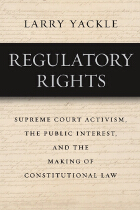 Regulatory Rights: Supreme Court Activism, the Public Interest, and the Making of Constitutional Law
Larry Yackle
University of Chicago Press, 2007 We often hear—with particular frequency during recent Supreme Court nomination hearings—that justices should not create constitutional rights, but should instead enforce the rights that the Constitution enshrines. In Regulatory Rights, Larry Yackle sets out to convince readers that such arguments fundamentally misconceive both the work that justices do and the character of the American Constitution in whose name they do it. It matters who sits on the Supreme Court, he argues, precisely because justices do create individual constitutional rights.
Traversing a wide range of Supreme Court decisions that established crucial precedents about racial discrimination, the death penalty, and sexual freedom, Yackle contends that the rights we enjoy are neither more nor less than what the justices choose to make of them. Regulatory Rights is a bracing read that will be heatedly debated by all those interested in constitutional law and the judiciary.
 Regulatory Takings: Law, Economics, and Politics
William A. Fischel
Harvard University Press, 1995 Are rent controls and zoning regulations unconstitutional? Should the Supreme Court strike down the Endangered Species Act when its administration interferes with the use of private property? These questions are currently debated under the doctrine of regulatory takings, and William Fischel’s book offers a new perspective on the issue.
Regulatory Takings argues that the issue is not so much about the details of property law as it is about the fairness of politics. The book employs jurisprudential theories, economic analysis, historical investigation, and political science to show why local land use regulations, such as zoning and rent control, deserve a higher degree of judicial scrutiny than national regulations. Unlike other books on this topic, Regulatory Takings goes beyond case law to buttress its arguments. Its reality checks range from reviews of statistical evidence to local inquiries about famous takings cases such as Pennsylvania Coal v. Mahon and Lucas v. South Carolina Coastal Commission. The gap between legal theory and on-the-ground practice is one reason that Fischel investigates alternative means of protecting property rights.
Local governments are often deterred from unfairly regulating portable assets by their owners’ threat of “exit” from the jurisdiction. State and federal government regulations are disciplined by property-owner coalitions whose “voice” is clearly audible in the statehouses and in Congress.
Constitutional courts need to preserve their resources for use in areas in which politics is loaded against the property owner. Regulatory Takings advances an economic standard to decide when a local regulation crosses the border from legitimate police power to a taking that requires just compensation for owners who are adversely affected.
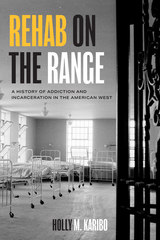 Rehab on the Range: A History of Addiction and Incarceration in the American West
Holly M. Karibo
University of Texas Press, 2024 2025 Coral Horton Tullis Memorial Prize, Texas State Historical Association The first study of the Fort Worth Narcotic Farm, an institution that played a critical role in fusing the War on Drugs, mass incarceration, and public health in the American West. In 1929, the United States government approved two ground-breaking and controversial drug addiction treatment programs. At a time when fears about a supposed rise in drug use reached a fevered pitch, the emergence of the nation’s first “narcotic farms” in Fort Worth, Texas, and Lexington, Kentucky, marked a watershed moment in the treatment of addiction. Rehab on the Range is the first in-depth history of the Fort Worth Narcotic Farm and its impacts on the American West. Throughout its operation from the 1930s to the 1970s, the institution was the only federally funded drug treatment center west of the Mississippi River. Designed to blend psychiatric treatment, physical rehabilitation, and vocational training, the Narcotic Farm, its proponents argued, would transform American treatment policies for the better. The reality was decidedly more complicated. Holly M. Karibo tells the story of how this institution—once framed as revolutionary for addiction care—ultimately contributed to the turn towards incarceration as the solution to the nation’s drug problem. Blending an intellectual history of addiction and imprisonment with a social history of addicts’ experiences, Rehab on the Range provides a nuanced picture of the Narcotic Farm and its cultural impacts. In doing so, it offers crucial historical context that can help us better understand our current debates over addiction, drug policy, and the rise of mass incarceration.
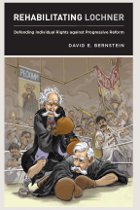 Rehabilitating Lochner: Defending Individual Rights against Progressive Reform
David E. Bernstein
University of Chicago Press, 2011 In this timely reevaluation of an infamous Supreme Court decision, David E. Bernstein provides a compelling survey of the history and background of Lochner v. New York. This 1905 decision invalidated state laws limiting work hours and became the leading case contending that novel economic regulations were unconstitutional. Sure to be controversial, Rehabilitating Lochner argues that the decision was well grounded in precedent—and that modern constitutional jurisprudence owes at least as much to the limited-government ideas of Lochner proponents as to the more expansive vision of its Progressive opponents.
Tracing the influence of this decision through subsequent battles over segregation laws, sex discrimination, civil liberties, and more, Rehabilitating Lochner argues not only that the court acted reasonably in Lochner, but that Lochner and like-minded cases have been widely misunderstood and unfairly maligned ever since.
 Rehabilitative Postsocialism: Disability, Sex, and Race in Eastern Europe
Katerina Kolárová
University of Michigan Press, 2025 Kateřina Kolářová’s Rehabilitative Postsocialism offers a timely interdisciplinary and intersectional analysis of how disability, race, class, and gender operate as ideological tools within the postsocialist Czech Republic (formerly Czechoslovakia). Kolářová presents postsocialism as an analytic that can and should be brought to bear to understand cultural politics, economic formations, and state politics through the present day.
Rehabilitative Postsocialism names disability, sexuality, and race as central yet invisible to negotiations of the postsocialist consensus. Drawing from a rich and varied archive, Rehabilitative Postsocialism maps the formation of new structures of inequalities and social imaginaries of wellness, merit, and justice in order to understand current articulations of global disenchantment with democracy, social justice, and solidarity. The book also makes clear that disability, race, and ethnicity continue to circulate in depictions of Eastern Europe as suspended in a chronic developmental “delay.” Rehabilitative Postsocialism both situates this positioning within its political and historical formation and offers the analytical tools to challenge its continued deployment.
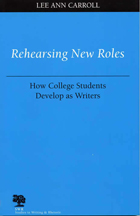 Rehearsing New Roles: How College Students Develop as Writers
Lee Ann Carroll
Southern Illinois University Press, 2002 In Rehearsing New Roles: How College Students Develop as Writers, Lee Ann Carroll argues for a developmental perspective to counter the fantasy held by many college faculty that students should, or could, be taught to write once so that ever after, they can write effectively on any topic, any place, any time. Carroll demonstrates in this volume why a one- or two-semester, first-year course in writing cannot meet all the needs of even more experienced writers. She then shows how students’ complex literacy skills develop slowly, often idiosyncratically, over the course of their college years, as they choose or are coerced to take on new roles as writers. As evidence, Carroll offers a longitudinal study of a group of students and the literacy environment they experienced in a midsize, independent university. Her study follows the experiences that altered their conception of writing in college and fostered their growing capacities as writers. Carroll’s analysis of the data collected supports a limited but still useful role for first-year composition, demonstrates how students do learn to write differently across the curriculum in ways that may or may not be recognized by faculty, and evaluates the teaching and learning practices that promote or constrain students’ development.
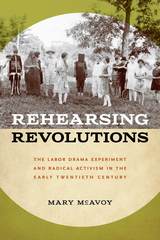 Rehearsing Revolutions: The Labor Drama Experiment and Radical Activism in the Early Twentieth Century
Mary McAvoy
University of Iowa Press, 2019 Choice Outstanding Academic Title, 2019 George Freedley Memorial Award Finalist, 2020 Between the world wars, several labor colleges sprouted up across the U.S. These schools, funded by unions, sought to provide members with adult education while also indoctrinating them into the cause. As Mary McAvoy reveals, a big part of that learning experience centered on the schools’ drama programs. For the first time, Rehearsing Revolutions shows how these left-leaning drama programs prepared American workers for the “on-the-ground” activism emerging across the country. In fact, McAvoy argues, these amateur stages served as training grounds for radical social activism in early twentieth-century America. Using a wealth of previously unpublished material such as director’s reports, course materials, playscripts, and reviews, McAvoy traces the programs’ evolution from experimental teaching tool to radically politicized training that inspired overt—even militant—labor activism by the late 1930s. All the while, she keeps an eye on larger trends in public life, connecting interwar labor drama to post-war arts-based activism in response to McCarthyism, the Cold War, and the Civil Rights movement. Ultimately, McAvoy asks: What did labor drama do for the workers’ colleges and why did they pursue it? She finds her answer through several different case studies in places like the Portland Labor College and the Highlander Folk School in Tennessee.
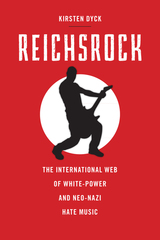 Reichsrock: The International Web of White-Power and Neo-Nazi Hate Music
Dyck, Kirsten
Rutgers University Press, 2016 From rap to folk to punk, music has often sought to shape its listeners’ political views, uniting them as a global community and inspiring them to take action. Yet the rallying potential of music can also be harnessed for sinister ends. As this groundbreaking new book reveals, white-power music has served as a key recruiting tool for neo-Nazi and racist hate groups worldwide. Reichsrock shines a light on the international white-power music industry, the fandoms it has spawned, and the virulently racist beliefs it perpetuates. Kirsten Dyck not only investigates how white-power bands and their fans have used the internet to spread their message globally, but also considers how distinctly local white-power scenes have emerged in Western Europe, Eastern Europe, Latin America, the United States, and many other sites. While exploring how white-power bands draw from a common well of nationalist, racist, and neo-Nazi ideologies, the book thus also illuminates how white-power musicians adapt their music to different locations, many of which have their own terms for defining whiteness and racial otherness. Closely tracking the online presence of white-power musicians and their fans, Dyck analyzes the virtual forums and media they use to articulate their hateful rhetoric. This book also demonstrates how this fandom has sparked spectacular violence in the real world, from bombings to mass shootings. Reichsrock thus sounds an urgent message about a global menace.
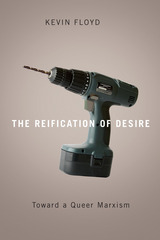 The Reification of Desire: Toward a Queer Marxism
Kevin Floyd
University of Minnesota Press, 2009 The Reification of Desire takes two critical perspectives rarely analyzed together—formative arguments for Marxism and those that have been the basis for queer theory—and productively scrutinizes these ideas both with and against each other to put forth a new theoretical connection between Marxism and queer studies.
Kevin Floyd brings queer critique to bear on the Marxian categories of reification and totality and considers the dialectic that frames the work of Georg Lukács, Herbert Marcuse, and Fredric Jameson. Reading the work of these theorists together with influential queer work by such figures as Michel Foucault and Judith Butler, and alongside reconsiderations of such texts as The Sun Also Rises and Midnight Cowboy, Floyd reformulates these two central categories that have been inseparable from a key strand of Marxist thought and have marked both its explanatory power and its limitations. Floyd theorizes a dissociation of sexuality from gender at the beginning of the twentieth century in terms of reification to claim that this dissociation is one aspect of a larger dynamic of social reification enforced by capitalism.
Developing a queer examination of reification and totality, Kevin Floyd ultimately argues that the insights of queer theory require a fundamental rethinking of both.
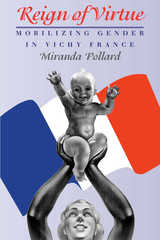 Reign of Virtue: Mobilizing Gender in Vichy France
Miranda Pollard
University of Chicago Press, 1998 In Reign of Virtue, Miranda Pollard explores the effects of military defeat and Nazi occupation on French articulations of gender in wartime France.
Drawing on governmental archives, historical texts, and propaganda, Pollard explores what most historians have ignored: the many ways in which Vichy's politicians used gendered images of work, family, and sexuality to restore and maintain political and social order. She argues that Vichy wanted to return France to an illustrious and largely mythical past of harmony, where citizens all knew their places and fulfilled their responsibilities, where order prevailed. The National Revolution, according to Pollard, replaced the ideals of liberty, equality, and fraternity with work, family, and fatherland, making the acceptance of traditional masculine and feminine roles a key priority. Pollard shows how Vichy's policies promoted the family as the most important social unit of a new France and elevated married mothers to a new social status even as their educational, employment, and reproductive rights were strictly curtailed.
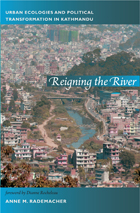 Reigning the River: Urban Ecologies and Political Transformation in Kathmandu
Anne M. Rademacher
Duke University Press, 2011 A major contribution to the nascent anthropology of urban environments, Reigning the River illuminates the complexities of river restoration in Kathmandu, Nepal’s capital and one of the fastest-growing cities in South Asia. In this rich ethnography, Anne M. Rademacher explores the ways that urban riverscape improvement involved multiple actors, each constructing ideals of restoration through contested histories and ideologies of belonging. She examines competing understandings of river restoration, particularly among bureaucrats in state and conservation-development agencies, cultural heritage activists, and advocates for the security of tens of thousands of rural-to-urban migrants settled along the exposed riverbed. Rademacher conducted research during a volatile period in Nepal’s political history. As clashes between Maoist revolutionaries and the government intensified, the riverscape became a site of competing claims to a capital city that increasingly functioned as a last refuge from war-related violence. In this time of intense flux, efforts to ensure, create, or imagine ecological stability intersected with aspirations for political stability. Throughout her analysis, Rademacher emphasizes ecology as an important site of dislocation, entitlement, and cultural meaning.
Re/imaginations of Disability in State Socialism: Visions, Promises, Frustrations
Edited by Katerina Kolárová and Martina Winkler
Campus Verlag, 2021 An interdisciplinary survey of disability in socialist states throughout global history.
In Re/imaginations of Disability in State Socialism, an interdisciplinary group of scholars examines how disability has been conceptualized and treated in socialist states throughout global history. Drawing on intersectional theories that set disability in conversation with other identity categories such as race, age, gender, and sexuality, this book offers a unique approach to this crucial issue.
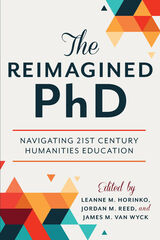 The Reimagined PhD: Navigating 21st Century Humanities Education
Leanne M Horinko
Rutgers University Press, 2021 Long seen as proving grounds for professors, PhD programs have begun to shed this singular sense of mission. Prompted by poor placement numbers and guided by the efforts of academic organizations, administrators and faculty are beginning to feel called to equip students for a range of careers. Yet, graduate students, faculty, and administrators often feel ill-prepared for this pivot. The Reimagined PhD assembles an array of professionals to address this difficult issue. The contributors show that students, faculty, and administrators must collaborate in order to prepare the 21st century PhD for a wide range of careers. The volume also undercuts the insidious notion that career preparation is a zero sum game in which time spent preparing for alternate careers detracts from professorial training. In doing so, The Reimagined PhD normalizes the multiple career paths open to PhD students, while providing practical advice geared to help students, faculty, and administrators incorporate professional skills into graduate training, build career networks, and prepare PhDs for a variety of careers.
 Reimaging Britain: 500 Years of Black and Asian History
Ron Ramdin
Pluto Press, 1999 A full understanding of Black and Asian history within the British context is integral to achieving a truly multicultural Britain. In this landmark book, Ron Ramdin offer the first complete history of both the Black and Asian experience in Britain
Blacks and Asians have a long history in the British Isles. Ramdin illustrates this by covering a 500-year period, from 1500 to the present day. He recounts the major historical episodes and covers all the major figures, including Ottobah Cugoano, William Cuffay, William Davidson, George Padmore, Mary Seacole, C.L.R. James, V.S. Naipaul, Sam Selvon, Walter Tull, Shirley Bassey, Bill Morris, Salman Rushdie, Hanif Kureshi and Bernie Grant.
In bringing the largely hidden histories of these immigrant communities to the fore, Ron Ramdin’s wide-ranging study challenges conventional histories of the British Isles. Reimaging Britain will lead to a reappraisal of how ‘British’ history is written in the future.
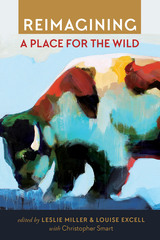 Reimagining a Place for the Wild
Leslie Miller, Louise Excell, and Christopher Smart
University of Utah Press, 2018 Reimagining a Place for the Wild contains a diverse collection of personal stories that describe encounters with the remaining wild creatures of the American West and critical essays that reveal wildlife’s essential place in western landscapes. Gleaned from historians, journalists, biologists, ranchers, artists, philosophers, teachers, and conservationists, these narratives expose the complex challenges faced by wild animals and those devoted to understanding them. Whether discussing keystone species like grizzly bears and gray wolves or microfauna swimming the thermal depths of geysers, these accounts reflect the authors’ expertise as well as their wonder and respect for wild nature. The writers do more than inform our sensibilities; their narratives examine both humanity’s conduct and its capacity for empathy toward other life. A selection of photos and paintings punctuates the volume. This collection sprang from the Reimagine Western Landscapes Symposium held at the University of Utah’s Taft-Nicholson Environmental Humanities Education Center in Centennial Valley, Montana. These testaments join a chorus of voices seeking improved relations with the western wild in the twenty-first century.
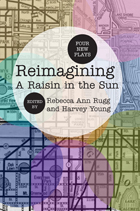 Reimagining A Raisin in the Sun: Four New Plays
Rebecca Ann Rugg
Northwestern University Press, 2012 Winner, 2011 Pulitzer Prize for Drama
Winner, 2012 Tony Award for Best Play
Winner, 1974 National Book Award for Philosophy and Religion
In 1959, Lorraine Hansberry’s A Raisin in the Sun energized the conversation about how Americans live together across lines of race and difference. In Reimagining “A Raisin in the Sun,” Rebecca Ann Rugg and Harvey Young bring together four contemporary plays—including 2011 Pulitzer Prize for Drama winner Clybourne Park—that, in their engagement with Hansberry’s play, illuminate the tensions and anxieties that still surround neighborhood integration.
Although the plays—Robert O’Hara’s Etiquette of Vigilance, Gloria Bond Clunie’s Living Green, Branden Jacobs-Jenkins’s Neighbors, and Bruce Norris’s Clybourne Park—are distinct from one another in terms of style and perspective on their predecessor, they commonly feature characters who are forced to closely examine, and sometimes revise or abandon, their ideas concerning race and their notions of social and economic justice. Above all, the plays use the lenses of neighborliness, privacy, and community to engage the large question of America’s common purpose. Each play is accompanied by an interview with the playwright about the influence of Hansberry’s landmark work. The afterword includes an interview with George C. Wolfe, whose play The Colored Museum laid the groundwork for the titles in this collection. The conversation around A Raisin in the Sun has continued unabated since its premiere fifty years ago. Rugg and Young’s book will serve as a valuable resource to fans, scholars, and students alike.
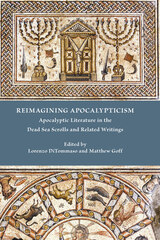 Reimagining Apocalypticism: Apocalyptic Literature in the Dead Sea Scrolls and Related Writings
Lorenzo DiTommaso
SBL Press, 2023 The Dead Sea Scrolls have expanded the corpus of early Jewish apocalyptic literature and tested scholars’ ideas of what apocalyptic means. With all the scrolls now available for study, contributors to this volume engage those texts and many more to reexplore not only definitions of the genre but also the influence of the Dead Sea Scrolls on the study of apocalyptic literature in the Second Temple period and beyond. Part 1 focuses on debates about categories and genre. Part 2 explores ancient Jewish texts from the Second Temple period to the early rabbinic era. Part 3 brings the results of scroll research into dialogue with the New Testament and early Christian writings. Contributors include Garrick V. Allen, Giovanni B. Bazzana, Stefan Beyerle, Dylan M. Burns, John J. Collins, Devorah Dimant, Lorenzo DiTommaso, Frances Flannery, Matthew J. Goff, Angela Kim Harkins, Martha Himmelfarb, G. Anthony Keddie, Armin Lange, Harry O. Maier, Andrew B. Perrin, Christopher Rowland, Alex Samely, Jason M. Silverman, and Rebecca Scharbach Wollenberg.
Reimagining Brazilian Television: Luiz Fernando Carvalho's Contemporary Vision
Eli Lee Carter
University of Pittsburgh Press, 2018 The Brazilian television industry is one of the most productive and commercially successful in the world. At the forefront of this industry is TV Globo and its production of standardized telenovelas, which millions of Brazilians and viewers from over 130 countries watch nightly. Eli Lee Carter examines the field of television production by focusing on the work of one of Brazil’s greatest living directors, Luiz Fernando Carvalho. Through an emphasis on Carvalho’s thirty-plus year career working for TV Globo, his unique mode of production, and his development of a singular aesthetic as a reaction to the dominant telenovela genre, Carter sheds new light on Brazilian television’s history, its current state, and where it is going—as new legislation and technology push it increasingly toward a post-network era.
Re-imagining Child Protection: Towards Humane Social Work with Families
Brid Featherstone, Susan White, and Kate Morris
Bristol University Press, 2014 Raising a number of critical questions, Brid Featherstone, Susan White and Kate Morris challenge a child protection culture that they see as becoming increasingly authoritarian. Calling for a family-minded practice of child protection, they argue that children should be understood as relational beings and that greater sensitivity should be paid to parents and the needs they have as a result of the burdens of childcare. They argue that current child protection services need to ameliorate, rather than reinforce, the many deprivations that parents engaged in their systems face. Bringing together authors who combine a wealth of experience in both scholarship and practice, this book provides a sensitive reassessment of a critical point of contact between governments and families.
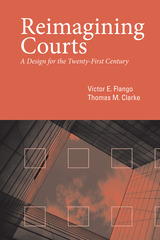 Reimagining Courts: A Design for the Twenty-First Century
Victor E Flango
Temple University Press, 2017 In their timely and topical book, Reimagining Courts, Victor Flango and Thomas Clarke argue that courts are a victim of their own success. Disputes that once were resolved either informally in the family or within the community are now handled mainly by courts, which strains government agency resources. The authors offer provocative suggestions for a thorough overhaul of American state and local courts, one that better fits the needs of a twenty-first century legal system.
Reimagining Courts recommends a triage process based upon case characteristics, litigant goals, and resolution processes. Courts must fundamentally reorganize their business processes around the concept of the litigant as a customer. Each adjudication process that the authors propose requires a different case management process and different amounts of judicial, staff, and facility resources.
Reimagining Courts should spark much-needed debate. This book will be of significant interest to lawyers, judges, and professionals in the court system as well as to scholars in public administration and political science.
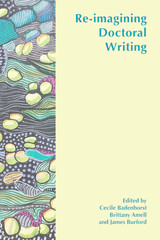 Re-imagining Doctoral Writing
Cecile Badenhorst
University Press of Colorado, 2021 What imaginings of the doctoral writer circulate in the talk of doctoral researchers and their supervisors? How do institutional policies and the conventions of particular disciplines shape the ways in which doctoral writing is imagined? Why, and in what ways, has doctoral writing been re-imagined in the twenty-first century? What future imaginings of doctoral writing may be hovering on the horizon? This edited collection has gathered a diverse group of authors—from Aotearoa New Zealand, Australia, Bangladesh, Japan, South Africa, the UK, Denmark, Canada, and the US—to consider these challenging questions during a time in which doctoral education is undergoing enormous transformation. Together, the contributors to this collection explore how the practice of doctoral writing is entangled with broader concerns within doctoral education, including attrition, timeliness, the quality of supervision, the transferability of knowledge and skills to industry settings, research impact, research integrity, and the decolonization of the doctorate.
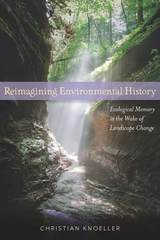 Reimagining Environmental History: Ecological Memory in the Wake of Landscape Change
Christian Knoeller
University of Nevada Press, 2017 Christian Knoeller presents a radical reinterpretation of environmental history set in the heartland of America. In an excellent model of narrative-based scholarship, this book dynamically reimagines American environmentalism across generations of writers, artists, and scientists. Knoeller starts out with Audubon, and cites Thoreau’s journals in the 1850s as he assesses an early 17th century account of New England’s natural resources by William Wood, showing the epic decline in game and bird populations in Concord. This reading of environmental history is replicated throughout with a gallery of novelists, poets, essayists, and other commentators as they explore ecological memory and environmental destruction. In apt discussions of Matthiessen, Lopez, Wendell Berry, William Stafford and many others, Knoeller offers vibrant insights into literary history. He also cites his own memoir of perpetual development on his family’s farm in Indiana, enriching the scholarship and making an urgent plea for the healing aesthetics of the imagination.
Reading across centuries and genres, Knoeller gives us a vibrant new appraisal of Midwestern/North American interior literary traditions and makes clear how vital environmental writing is to this region. To date, no one has written such an eloquent and comprehensive cross-genre analysis of Midwestern environmental literature.
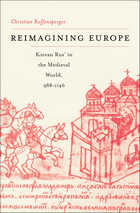 Reimagining Europe: Kievan Rus’ in the Medieval World, 988–1146
Christian Raffensperger
Harvard University Press, 2012 An overriding assumption has long directed scholarship in both European and Slavic history: that Kievan Rus' in the tenth through twelfth centuries was part of a Byzantine commonwealth separate from Europe. Christian Raffensperger refutes this conception and offers a new frame for two hundred years of history, one in which Rus' is understood as part of medieval Europe and East is not so neatly divided from West.
With the aid of Latin sources, the author brings to light the considerable political, religious, marital, and economic ties among European kingdoms, including Rus', restoring a historical record rendered blank by Russian monastic chroniclers as well as modern scholars ideologically motivated to build barriers between East and West. Further, Raffensperger revises the concept of a Byzantine commonwealth that stood in opposition to Europe-and under which Rus' was subsumed-toward that of a Byzantine Ideal esteemed and emulated by all the states of Europe. In this new context, appropriation of Byzantine customs, law, coinage, art, and architecture in both Rus' and Europe can be understood as an attempt to gain legitimacy and prestige by association with the surviving remnant of the Roman Empire. Reimagining Europe initiates an expansion of history that is sure to challenge ideas of Russian exceptionalism and influence the course of European medieval studies.
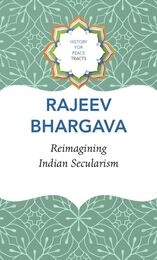 Reimagining Indian Secularism
Rajeev Bhargava
Seagull Books, 2023 An original analysis of religion versus the religionization of society in India.
What is unique about Indian secularism? In this book, Rajeev Bhargava argues that secularism in India, as opposed to in the West, did not arise in a society that had already been religiously homogenized, where the need of the hour was to break the political nexus between church and state. In India, secularism does not demand that the state is against or indifferent to religion, but rather that it combat institutionalized religious domination, both between and within religions. Apathy or antipathy to religion, Bhargava points out, would foment inter-religious rivalries that intensify anti-reformist tendencies, fueling further division.
As secularism receives daily ridicule in India, Bhargava provides an account of how this “principled distance” from religion has been a victim of misunderstandings by its proponents, abuse by its practitioners, and deliberate distortion by its opponents. Reimagining Indian Secularism offers a proposal of how we might one day be able to rehabilitate secularism.
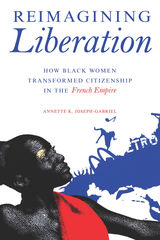 Reimagining Liberation: How Black Women Transformed Citizenship in the French Empire
Annette K. Joseph-Gabriel
University of Illinois Press, 2019 Black women living in the French empire played a key role in the decolonial movements of the mid-twentieth century. Thinkers and activists, these women lived lives of commitment and risk that landed them in war zones and concentration camps and saw them declared enemies of the state. Annette K. Joseph-Gabriel mines published writings and untapped archives to reveal the anticolonialist endeavors of seven women. Though often overlooked today, Suzanne Césaire, Paulette Nardal, Eugénie Éboué-Tell, Jane Vialle, Andrée Blouin, Aoua Kéita, and Eslanda Robeson took part in a forceful transnational movement. Their activism and thought challenged France's imperial system by shaping forms of citizenship that encouraged multiple cultural and racial identities. Expanding the possibilities of belonging beyond national and even Francophone borders, these women imagined new pan-African and pan-Caribbean identities informed by black feminist intellectual frameworks and practices. The visions they articulated also shifted the idea of citizenship itself, replacing a single form of collective identity and political participation with an expansive plurality of forms of belonging.
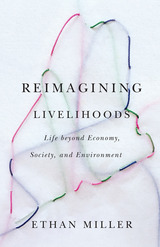 Reimagining Livelihoods: Life beyond Economy, Society, and Environment
Ethan Miller
University of Minnesota Press, 2019 A provocative reassessment of the concepts underlying the struggle for sustainable development Much of the debate over sustainable development revolves around how to balance the competing demands of economic development, social well-being, and environmental protection. “Jobs vs. environment” is only one of the many forms that such struggles take. But what if the very terms of this debate are part of the problem? Reimagining Livelihoods argues that the “hegemonic trio” of economy, society, and environment not only fails to describe the actual world around us but poses a tremendous obstacle to enacting a truly sustainable future. In a rich blend of ethnography and theory, Reimagining Livelihoods engages with questions of development in the state of Maine to trace the dangerous effects of contemporary stories that simplify and domesticate conflict. As in so many other places around the world, the trio of economy, society, and environment in Maine produces a particular space of “common sense” within which struggles over life and livelihood unfold. Yet the terms of engagement embodied by this trio are neither innocent nor inevitable. It is a contingent, historically produced configuration, born from the throes of capitalist industrialism and colonialism. Drawing in part on his own participation in the struggle over the Plum Creek Corporation’s “concept plan” for a major resort development on the shores of Moosehead Lake in northern Maine, Ethan Miller articulates a rich framework for engaging with the ethical and political challenges of building ecological livelihoods among diverse human and nonhuman communities. In seeking a pathway for transformative thought that is both critical and affirmative, Reimagining Livelihoods provides new frames of reference for living together on an increasingly volatile Earth.
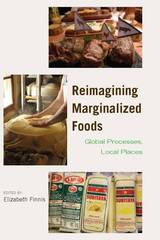 Reimagining Marginalized Foods: Global Processes, Local Places
Edited by Elizabeth Finnis
University of Arizona Press, 2012 With globalization has come an increased focus on food—where it comes from, how it is transported, who eats it, and what cultural significance it has. This volume brings together ethnographically based anthropological analyses of shifting meanings and representations associated with the foods, ingredients, and cooking practices of marginalized and/or indigenous cultures. Contributors are particularly interested in how these foods intersect with politics, nationhood and governance, identity, authenticity, and conservation. The chapters cover diverse locales, issues, and foods: the cultural meanings of sinonggi, a thick sago porridge from Sulawesi, Indonesia; the significance of pom, a Surinam dish popular in the Netherlands; the transformation of alpaca meat in Peru; the impact of culinary tourism on indigenous cuisine in Mexico; the re-presenting of minor millets in South India; and the development of cheeses in the Italian Alps. A conceptual essay on food and social boundaries rounds out the collection.
Throughout, the contributors address important questions, including: How are traditional foods “repackaged” in the process of mainstreaming access? What does this repackaging mean for the ways local or indigenous peoples view their traditional food practices? How are local cuisines mobilized in movements to create national images and identities? What tensions emerge between new representations of foods and local cultural meanings?
Together the contributors provide a thoughtful inquiry into what happens when food and culinary practices are moved from the cultural or physical margins, and how such movements can be shaped by—and employed in the pursuit of—political, social, and cultural goals.
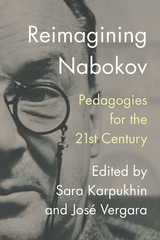 Reimagining Nabokov: Pedagogies for the 21st Century
José Vergara
Amherst College Press, 2022 In Reimagining Nabokov: Pedagogies for the 21st Century, eleven teachers of Vladimir Nabokov describe how and why they teach this notoriously difficult, even problematic, writer to the next generations of students. Contributors offer fresh perspectives and embrace emergent pedagogical methods, detailing how developments in technology, translation and archival studies, and new interpretative models have helped them to address urgent questions of power, authority, and identity. Practical and insightful, this volume features exciting methods through which to reimagine the literature classroom as one of shared agency between students, instructors, and the authors they read together. “It is both timely and refreshing to have an influx of teacher-scholars who engage Nabokov from a variety of perspectives… this volume does justice to the breadth of Nabokov’s literary achievements, and it does so with both pedagogical creativity and scholarly integrity."—Dana Dragunoiu, Carleton University "[A] valuable study for any reader, teacher, scholar, or student of Nabokov. Amongst specific and urgent insights on the potential for digital methods, the relevance of Nabokov for students today, and how to reconcile issues of identity with an author who disavowed history and politics, are much wider and timeless questions of authorial control and the ability to access reality."— Anoushka Alexander-Rose, Nabokov Online Journal Reimagining Nabokov takes a holistic approach to the many stumbling blocks in teaching Nabokov today. Especially intriguing about this volume is that through its essays a fresh picture of Nabokov emerges, not as an authoritarian and paranoid world-creator (an image long entrenched in Nabokov scholarship), but as someone who is tentative, hopeful, socially conscious, compassionate, and traumatized by the experience of exile....Reimagining Nabokov models pedagogical concepts that can be applied to teaching any literary text with a social conscience.—Alisa Ballard Lin, Modern Language Review Contributions by Galya Diment, Tim Harte, Robyn Jensen, Sara Karpukhin, Yuri Leving, Roman Utkin, José Vergara, Meghan Vicks, Olga Voronina, Lisa Ryoko Wakamiya, and Matthew Walker.
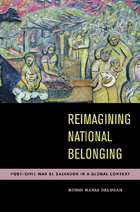 Reimagining National Belonging: Post-Civil War El Salvador in a Global Context
Robin Maria DeLugan
University of Arizona Press, 2012 Reimagining National Belonging is the first sustained critical examination of post–civil war El Salvador. It describes how one nation, after an extended and divisive conflict, took up the challenge of generating social unity and shared meanings around ideas of the nation. In tracing state-led efforts to promote the concepts of national culture, history, and identity, Robin DeLugan highlights the sites and practices—as well as the complexities—of nation-building in the twenty-first century.
Examining events that unfolded between 1992 and 2011, DeLugan both illustrates the idiosyncrasies of state and society in El Salvador and opens a larger portal into conditions of constructing a state in the present day around the globe—particularly the process of democratization in an age of neoliberalism. She demonstrates how academics, culture experts, popular media, and the United Nations and other international agencies have all helped shape ideas about national belonging in El Salvador. She also reveals the efforts that have been made to include populations that might have been overlooked, including indigenous people and faraway citizens not living inside the country’s borders. And she describes how history and memory projects have begun to recall the nation’s violent past with the goal of creating a more just and equitable nation.
This illuminating case study fills a gap in the scholarship about culture and society in contemporary El Salvador, while offering an “ethnography of the state” that situates El Salvador in a global context.
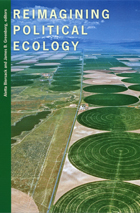 Reimagining Political Ecology
Aletta Biersack and James B. Greenberg, eds.
Duke University Press, 2006 Reimagining Political Ecology is a state-of-the-art collection of ethnographies grounded in political ecology. When political ecology first emerged as a distinct field in the early 1970s, it was rooted in the neo-Marxism of world system theory. This collection showcases second-generation political ecology, which retains the Marxist interest in capitalism as a global structure but which is also heavily influenced by poststructuralism, feminism, practice theory, and cultural studies. As these essays illustrate, contemporary political ecology moves beyond binary thinking, focusing instead on the interchanges between nature and culture, the symbolic and the material, and the local and the global. Aletta Biersack’s introduction takes stock of where political ecology has been, assesses the field’s strengths, and sets forth a bold research agenda for the future. Two essays offer wide-ranging critiques of modernist ecology, with its artificial dichotomy between nature and culture, faith in the scientific management of nature, and related tendency to dismiss local knowledge. The remaining eight essays are case studies of particular constructions and appropriations of nature and the complex politics that come into play regionally, nationally, and internationally when nature is brought within the human sphere. Written by some of the leading thinkers in environmental anthropology, these rich ethnographies are based in locales around the world: in Belize, Papua New Guinea, the Gulf of California, Iceland, Finland, the Peruvian Amazon, Malaysia, and Indonesia. Collectively, they demonstrate that political ecology speaks to concerns shared by geographers, sociologists, political scientists, historians, and anthropologists alike. And they model the kind of work that this volume identifies as the future of political ecology: place-based “ethnographies of nature” keenly attuned to the conjunctural effects of globalization. Contributors. Eeva Berglund, Aletta Biersack, J. Peter Brosius, Michael R. Dove, James B. Greenberg, Søren Hvalkof, J. Stephen Lansing, Gísli Pálsson, Joel Robbins, Vernon L. Scarborough, John W. Schoenfelder, Richard Wilk
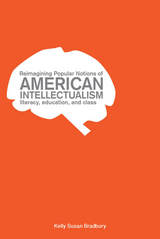 Reimagining Popular Notions of American Intellectualism: Literacy, Education, and Class
Kelly Susan Bradbury
Southern Illinois University Press, 2016 The image of the lazy, media-obsessed American, preoccupied with vanity and consumerism, permeates popular culture and fuels critiques of American education. In Reimagining Popular Notions of American Intellectualism, Kelly Susan Bradbury challenges this image by examining and reimagining widespread conceptions of intellectualism that assume intellectual activity is situated solely in elite institutions of higher education.
Bradbury begins by tracing the origins and evolution of the narrow views of intellectualism that are common in the United States today. Then, applying a more inclusive and egalitarian definition of intellectualism, she examines the literacy and learning practices of three nonelite sites of adult public education in the United States: the nineteenth-century lyceum, a twentieth-century labor college, and a twenty-first-century GED writing workshop. Bradbury argues that together these three case studies teach us much about literacy, learning, and intellectualism in the United States over time and place. She concludes the book with a reflection on her own efforts to aid students in recognizing and resisting the rhetoric of anti-intellectualism that surrounds them and that influences their attitudes and actions.
Drawing on case studies as well as Bradbury’s own experiences with students, Reimagining Popular Notions of American Intellectualism demonstrates that Americans have engaged and do engage in the process and exercise of intellectual inquiry, contrary to what many people believe. Addressing a topic often overlooked by rhetoric, composition, and literacy studies scholars, it offers methods for helping students reimagine what it means to be intellectual in the twenty-first century.
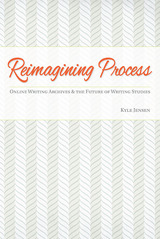 Reimagining Process: Online Writing Archives and the Future of Writing Studies
Kyle Jensen
Southern Illinois University Press, 2015 For more than four decades, the dominant model for pedagogy and research in the field of composition has been a how-centered process approach to writing instruction, which involves studying the writing that students produce to expose the various stages of their writing process. By looking at notes, outlines, and multiple drafts, often presented by students together in the form of a portfolio, instructors can identify unproductive habits that students may have and provide techniques that help them improve their writing. In this groundbreaking volume, Kyle Jensen critiques traditional how-centered process instruction and presents a sound, practical methodology by which portfolios and online writing archives—digital interfaces that expose the marks of revision writers make during composition—might be employed to develop theories about what writing is: how it occurs, functions, circulates, creates meaning, and forms its subjects. Offering online writing archives as a way to envision a transdisciplinary approach to writing studies, Reimagining Process does not abandon the prevailing concepts of process pedagogy but rather casts them in wider contexts to conceive new ways of teaching and studying writing.
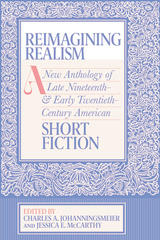 Reimagining Realism: A New Anthology of Late Nineteenth- and Early Twentieth-Century American Short Fiction
Charles A. Johanningsmeier
Ohio University Press, 2022 This innovative collection reinvents the standard American short fiction anthology and offers readers an invigorated, inclusive, and nuanced understanding of American literary history and culture from the Civil War to the end of World War I. Beginning with one of Louisa May Alcott’s Hospital Sketches, originally published in 1863, this anthology offers a refreshing perspective on American literature from the latter half of the nineteenth century through the first decades of the twentieth. Based on Alcott’s brief stint as a Civil War nurse, Hospital Sketches stands in contrast to the sentimentality of her better-known Little Women and illustrates a blending of romanticism and realism. Furthermore, its thematic focus on the tension between idealized notions of noble, patriotic duty and the horrific reality of war exemplifies a dominant American cultural mindset at the time. Following this model of complicating accepted ideas about realism and of particular authors, Reimagining Realism brings together dozens of texts that engage with the immense changes and upheavals that characterized American culture over the next six decades: war, abolition, voting rights, westward expansion, immigration, racism and ethnocentrism, industrial production, labor reforms, transportation, urban growth, journalism, mass media, education, and economic disparity. Reimagining Realism presents a collection of works much more diverse than what is typically found in other anthologies of short fiction from this era. Some selections are lesser-known works by familiar authors that enable readers to see dimensions of these authors that are rarely considered but deserve further study. The book also features authors from many previously underrepresented groups and includes some outstanding works by authors whose names are almost completely unknown to today’s readers—but which deserve greater attention. The volume’s editors, in their intent to spur readers to further reimagine realism, to represent the spectrum of viewpoints prevalent during this era, and to spark critical thinking and productive discussion, have been careful not to apply any type of political litmus test to the included works. They have also refrained from categorizing works according to convention, so as not to predispose readers to restrictive interpretations, and have provided only brief, highly readable headnotes and annotations that will help readers better understand the texts.
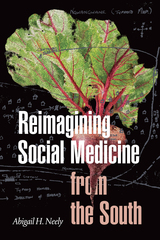 Reimagining Social Medicine from the South
Abigail H. Neely
Duke University Press, 2021 In Reimagining Social Medicine from the South, Abigail H. Neely explores social medicine's possibilities and limitations at one of its most important origin sites: the Pholela Community Health Centre (PCHC) in South Africa. The PCHC's focus on medical and social factors of health yielded remarkable success. And yet South Africa's systemic racial inequality hindered health center work, and witchcraft illnesses challenged a program rooted in the sciences. To understand Pholela's successes and failures, Neely interrogates the “social” in social medicine. She makes clear that the social sciences the PCHC used failed to account for the roles that Pholela's residents and their environment played in the development and success of its program. At the same time, the PCHC's reliance on biomedicine prevented it from recognizing the impact on health of witchcraft illnesses and the social relationships from which they emerged. By rewriting the story of social medicine from Pholela, Neely challenges global health practitioners to recognize the multiple worlds and actors that shape health and healing in Africa and beyond.
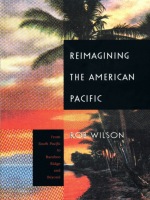 Reimagining the American Pacific: From South Pacific to Bamboo Ridge and Beyond
Rob Wilson
Duke University Press, 2000 In this compelling critique Rob Wilson explores the creation of the “Pacific Rim” in the American imagination and how the concept has been variously adapted and resisted in Hawai‘i, the Pacific Islands, New Zealand, and Australia. Reimagining the American Pacific ranges from the nineteenth century to the present and draws on theories of postmodernism, transnationality, and post-Marxist geography to contribute to the ongoing discussion of what constitutes “global” and “local.” Wilson begins by tracing the arrival of American commerce and culture in the Pacific through missionary and imperial forces in the nineteenth century and the parallel development of Asia/Pacific as an idea. Using an impressive range of texts—from works by Herman Melville, James Michener, Maori and Western Samoan novelists, and Bamboo Ridge poets to Baywatch, films and musicals such as South Pacific and Blue Hawaii, and native Hawaiian shark god poetry—Wilson illustrates what it means for a space to be “regionalized.” Claiming that such places become more open to transnational flows of information, labor, finance, media, and global commodities, he explains how they then become isolated, their borders simultaneously crossed and fixed. In the case of Hawai’i, Wilson argues that culturally innovative, risky forms of symbol making and a broader—more global—vision of local plight are needed to counterbalance the racism and increasing imbalance of cultural capital and goods in the emerging postplantation and tourist-centered economy. Reimagining the American Pacific leaves the reader with a new understanding of the complex interactions of global and local economies and cultures in a region that, since the 1970s, has been a leading trading partner of the United States. It is an engaging and provocative contribution to the fields of Asian and American studies, as well as those of cultural studies and theory, literary criticism, and popular culture.
Re-Imagining the City: Art, Globalization and Urban Spaces
Edited by Elizabeth Grierson and Kristen Sharp
Intellect Books, 2013 Re-Imagining the City: Art, Globalization, and Urban Spaces examines how contemporary processes of globalization are transforming cultural experience and production in urban spaces. It maps how cultural productions in art, architecture, and communications media are contributing to the reimagining of place and identity through events, artifacts, and attitudes. This book recasts how we understand cities—how knowledge can be formed, framed, and transferred through cultural production and how that knowledge is mediated through the construction of aesthetic meaning and value.
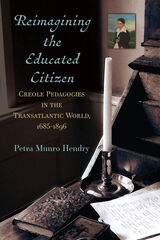 Reimagining the Educated Citizen: Creole Pedagogies in the Transatlantic World, 1685-1896
Petra Munro Hendry
University of Michigan Press, 2023 Reimagining the Educated Citizen contends that the constructs of public education and citizenship in the struggle to constitute a U.S. national identity are inseparable from the simultaneous emergence of transatlantic constructs of an educated citizen along transnational and transracial lines. The nineteenth century is commonly understood as the age of nationalism and nation formation in which the Anglo-Protestant Common School movement takes center stage in the production of the American democratic citizen. Ironically, the argument for public, Common Schools privileged whiteness instead of equality. This book suggests that an alternative vision of the relationship between education and citizenship emerged from a larger transatlantic history. Given shape by the movement of people, ideas, commodities, and practices across the Caribbean, Africa, Europe, the Gulf of Mexico and the Mississippi Valley, this radical egalitarian vision emerged at the crossroads of the Atlantic-colonial and antebellum Louisiana.
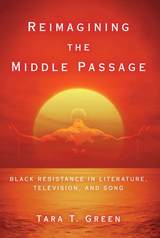 Reimagining the Middle Passage: Black Resistance in Literature, Television, and Song
Tara T. Green
Ohio State University Press, 2018 In Reimagining the Middle Passage: Black Resistance in Literature, Television, and Song, Tara T. Green turns to twentieth- and recent twenty-first-century representations of the Middle Passage created by African-descended artists and writers. Examining how these writers and performers revised and reimagined the Middle Passage in their work, Green argues that they recognized it as a historical and geographical site of trauma as well as a symbol for a place of understanding and change. Their work represents the legacy African captives left for resisting “social death” (the idea that Black life does not matter), but it also highlights strong resistance to that social death (the idea that it does matter).
Exploring the presence of water and its impact on African descendants,Reimagining the Middle Passageoffers fresh analyses of Alex Haley’sRootsand the television adaptations; the history of flooding in Black communities in literature such as Jesmyn Ward’sSalvage the Bonesand Paule Marshall’sPraisesong for the Widow, in blues songs, and in television shows such asTreme; and stories of resistance found in myths associated with Marie Laveau and flying Africans.
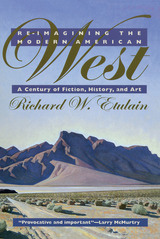 Re-imagining the Modern American West: A Century of Fiction, History, and Art
Richard W. Etulain
University of Arizona Press, 1996 From the Mississippi west to the Pacific, from border to border north and south, here is the first thorough overview of novelists, historians, and artists of the modern American West. Examining a full century of cultural-intellectual forces at work, a leading authority on the twentieth-century West brings his formidable talents to bear in this pioneering study. Richard W. Etulain divides his book into three major sections. He begins with the period from the 1890s to the 1920s, when artists and authors were inventing an idealized frontier--especially one depicting initial contacts and conflicts with new landscapes and new peoples. The second section covers the regionalists, who focused on regional (mostly geographical) characteristics that shaped distinctively "western" traits of character and institutions. The book concludes with a discussion of the postregional West from World War II to the ’90s, a period when novelists, historians, and artists stressed ethnicity, gender, and a new environmentalism as powerful forces in the formation of modern western society and culture. Etulain casts a wide net in his new study.
He discusses novelists from Jack London to John Steinbeck and on to Joan Didion. He covers historians from Frederick Jackson Turner to Earl Pomeroy and Patricia Nelson Limerick, and artists from Frederic Remington and Charles Russell to Georgia O’Keeffe and R. C. Gorman. The author places emphasis on women painters and authors such as Mary Hallock Foote, Mary Austin, Willa Cather, and Judith Baca. He also stresses important works of ethnic writers including Leslie Marmon Silko, Rudolfo Anaya, and Amy Tan. An intriguing survey of tendencies and trends and a well-defined profile of influences and outgrowths, this book will be valuable to students and scholars of western culture and history, American studies, and related disciplines. General readers will appreciate the book’s balanced structure and spirited writing style. All readers, whatever their level of interest, will discover the major cultural inventions of the American West over the past one hundred years.
 Reimagining the Nation-State: The Contested Terrains of Nation-Building
Jim MacLaughlin
Pluto Press, 2001 This book assesses competing modes of nation-building and nationalism through a critical reappraisal of the works of key theorists such as Benedict Anderson and Eric Hobsbawm. Exploring the processes of nation building from a variety of ethnic and social class contexts, it focuses on the contested terrains within which nationalist ideologies are often rooted.
Mac Laughlin offers a theoretical and empirical analysis of nation building, taking as a case study the historical connections between Ireland and Great Britain in the clash between 'big nation' historic British nationalism on the one hand, and minority Irish nationalism on the other. Locating the origins of the historic nation in the seventeenth and eighteenth centuries, Mac Laughlin emphasises the difficulties, and specifities, of minority nationalisms in the nineteenth century. In so doing he calls for a place-centred approach which recognises the symbolic and socio-economic significance of territory to the different scales of nation-building. Exploring the evolution of Irish Nationalism, Reimaging the Nation State also shows how minority nations can challenge the hegemony of dominant states and threaten the territorial integrity of historic nations.
Re-Imagining the Victim in Post-1970s Horror Media
Madelon Hoedt
Amsterdam University Press, 2024 Despite its necessary centrality within the genre, the concept of the victim has not received much direct attention within the field of horror studies. Arguably, their presence is so ubiquitous as to become invisible—the threat of horror implies the need for a victim, whose function never alters, often becoming a blank slate for audiences to project their desires and fears onto.
This volume seeks to make explicit the concept of the victim within horror media and to examine their position in more detail, demonstrating that the necessity of their appearance within the genre does not equate to a simplicity of definition.
The chapters within this volume cover a number of topics and approaches, examining sources from literature, film, TV, and games (both analogue and digital) to show the pervasiveness of horror’s victims, as well as the variety of their guises.
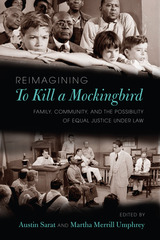 Reimagining "To Kill a Mockingbird": Family, Community, and the Possibility of Equal Justice under Law
Austin Sarat
University of Massachusetts Press, 2013 Fifty years after the release of the film version of Harper Lee's acclaimed novel To Kill a Mockingbird, this collection of original essays takes a fresh look at a classic text in legal scholarship. The contributors revisit and examine Atticus, Scout, and Jem Finch, their community, and the events that occur there through the interdisciplinary lens of law and humanities scholarship.
The readings in this volume peel back the film's visual representation of the many-layered social world of Maycomb, Alabama, offering sometimes counterintuitive insights through the prism of a number of provocative contemporary theoretical and interpretive questions. What, they ask, is the relationship between the subversion of social norms and the doing of justice or injustice? Through what narrative and visual devices are some social hierarchies destabilized while others remain hegemonic? How should we understand the sacrifices characters make in the name of justice, and comprehend their failures in achieving it?
Asking such questions casts light on the film's eccentricities and internal contradictions and suggests the possibility of new interpretations of a culturally iconic text. The book examines the context that gave meaning to the film's representation of race and how debates about family, community, and race are played out and reframed in law.
Contributors include Colin Dayan, Thomas L. Dumm, Susan Sage Heinzelman, Linda Ross Meyer, Naomi Mezey, Imani Perry, and Ravit Reichman.
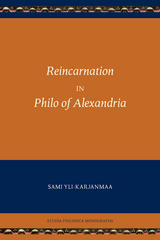 Reincarnation in Philo of Alexandria
Sami Yli-Karjanmaa
SBL Press, 2015 The best current research on Philo's allegorical exegesis of Scripture The strong element of Greek philosophy in Philo's thought has been recognized since antiquity, but his relation to the Pythagorean-Platonic tenet of reincarnation has been a neglected, even avoided, topic in research. This book confirms the view common in the seventeenth to nineteenth centuries that Philo accepted the doctrine of reincarnation even though he preferred not to speak openly about it. The book shows how allegorization enabled Philo to give a reincarnational interpretation to very different scriptural passages. Features: - Highlights the importance of reading Philonic parallel passages together for fuller understanding of Philo s message
- Discusses the difference between protological and universal allegory in Philo's exegesis of the first chapters of Genesis
- Introduces new concepts to Philonic research such as the corporealization of the mind (the result of transgression and a driving force for reincarnation) and monadization (the human soul's transformation into pure mind upon salvation)
 The Reincarnation of Russia: Struggling with the Legacy of Communism, 1990–1994
John Löwenhardt
Duke University Press, 1995 In The Reincarnation of Russia, John Löwenhardt presents the first in-depth analysis of the initial and crucial stages of Russia’s new statehood. He examines Russia’s recent turbulent history—beginning with the explosive Declaration of State Sovereignty in June 1990, through the adoption of the Yeltsin constitution in the elections of December 1993 and concluding with the early months of 1994. His analysis of Russia’s struggle with the vestige of Soviet Communism and the attempt to create a more democratic form of government offers crucial insight into one of the critical turning points in contemporary history.
Building on analysis of the failure of the Soviet system, Löwenhardt compares the emergence of Russia as a newborn state with other countries that have undergone transitions from authoritarianism toward democracy. Although it is often claimed that Russia is a unique case, the author argues that the lessons of other nations are relevant to the Russian situation. In conjunction with this comparative analysis and with consideration of the significance of the communist and Russian past, Löwenhardt discusses political and economic developments—including both foreign and domestic policy concerns—in Russia over the last four years. He provides a better understanding of the Russian condition and a guarded optimism regarding the ongoing process taking place in Russia today.
The Reincarnation of Russia will be welcomed by scholars with specialized interests in the democratization of Russia, political leaders, journalists, and general readers concerned with the global impact of Russia’s changing status.
 Reinscribing Moses: Heine, Kafka, Freud, and Schoenberg in a European Wilderness
Bluma Goldstein
Harvard University Press, 1992 Heinrich Heine, Franz Kafka, Sigmund Freud, Arnold Schoenberg—all were Jews who considered themselves more European than Jewish. Yet their experience of anti-Semitism and injustice undermined a full commitment to their native German or Austrian heritage. Writing about Moses—the towering architect of the nation of Israel and also the quintessential diaspora figure who wandered between bondage and liberation—the four very different writers articulated a shared quandary. Their writings about Moses are Bluma Goldstein's focal point in her eloquent book about Jewish identity and assimilation, tradition and cultural allegiance. Skillfully blending textual interpretation, historical context, and biography, Goldstein is able to illuminate the particular meaning of these works as well as their political significance.
The writings considered here at times express despair over the dominant culture's unfulfilled promises of emancipation and equality. Alternatively, adopting the terms of Jewish tradition, they articulate a paradigm of freedom and Jewish identity. But more often, as Goldstein shows, they do both, reflecting a continuing, albeit disillusioned, commitment to European culture and a return to Jewish heritage. Reinscribing Moses thus reveals the ways in which these texts speak with two voices, opposing injustice and oppression within the bounds of German or Austrian society and advancing the biblical story of national liberation within Jewish tradition. It will be a valuable addition to the ongoing debate over questions of Jewish as well as German heritage and identity.
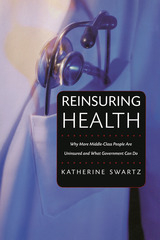 Reinsuring Health: Why More Middle-Class People Are Uninsured and What Government Can Do
Katherine Swartz
Russell Sage Foundation, 2006 America's current system of health insurance, which relies almost exclusively on employer-sponsored coverage, is in danger of collapse, and this problem is not limited to the poor and working class. An increasing number of middle class Americans do not have employer-provided insurance and—due to skyrocketing premiums—cannot afford to purchase coverage for themselves. Reinsuring Health, by economist Katherine Swartz, examines this growing national crisis and outlines a concrete plan to make health insurance accessible and affordable for all Americans. Reinsuring Health documents why the number of uninsured Americans—now 45.5 million people—has grown in the last twenty-five years. Swartz focuses on how labor market changes—such as the decline of domestic manufacturing, decreased unionization, and the growth of non-standard work arrangements—have led U.S. employers to retreat from providing health insurance for their workers. These trends, combined with the increasing costs of medical care, have led to an explosion in health insurance premiums and a decline in coverage, particularly among the middle-class. Since those who seek insurance as individuals are generally most likely to need health care, private insurers charge higher premiums in the individual (non-group) markets than to people who obtain group insurance. This makes individual health insurance less attractive to the young and increasingly unaffordable for middle-class Americans. Similarly, insurers charge higher per person (or per family) premiums to small firms than to large companies, so many small firms do not sponsor coverage for their employees. Reinsuring Health shows how these problems can be overcome if the federal government provides a new reinsurance program which would protect insurance companies that provide small group and individual health insurance against the possibility that their policy-holders will incur very high medical expenses. By assuming some of the risk that people will face extremely costly medical bills, the government will make insurers less hesitant to offer coverage to high-risk individuals, and will help drive down premiums for others. Reinsuring Health demonstrates that this form of government reinsurance has worked in the past, helping to establish smooth running private markets for catastrophe insurance and secondary mortgages. Today, growing numbers of middle class Americans lack health insurance. Protection against the possibility of falling ill or getting hurt and having to pay extraordinary health care bills should not be a luxury available only to the very rich and the very poor. Reinsuring Health proposes a straightforward solution that would bring health insurance back within the reach of the increasing ranks of the uninsured, particularly those who are in the middle class.
Reinterpreting Galileo
William A. Wallace
Catholic University of America Press, 2018 A collection of papers to mark the 350th anniversary of the publication of Galileo's Dialogue
Reinterpreting Property
Margaret Jane Radin
University of Chicago Press, 1994 This collection of essays by one of the country's leading property theorists revitalizes the liberal personality theory of property.
Departing from traditional libertarian and economic theories of property, Margaret Jane Radin argues that the law should take into account nonmonetary personal value attached to property—and that some things, such as bodily integrity, are so personal they should not be considered property at all. Gathered here are pieces ranging from Radin's classic early essay on property and personhood to her recent works on governmental "taking" of private property.
Margaret Jane Radin is professor of law at Stanford University. She is the author of over twenty-five articles on legal and political theory.
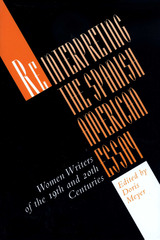 Reinterpreting the Spanish American Essay: Women Writers of the 19th and 20th Centuries
Edited by Doris Meyer
University of Texas Press, 1995 Latin American women have long written essays on topics ranging from gender identity and the female experience to social injustice, political oppression, lack of educational opportunities, and the need for female solidarity in a patriarchal environment. But this rich vein of writing has often been ignored and is rarely studied. This volume of twenty-one original studies by noted experts in Latin American literature seeks to recover and celebrate the accomplishments of Latin American women essayists. Taking a variety of critical approaches, the authors look at the way women writers have interpreted the essay genre, molded it to their expression, and created an intellectual tradition of their own. Some of the writers they treat are Flora Tristan, Gertrudis Gómez de Avellaneda, Clorinda Matto de Turner, Victoria Ocampo, Alfonsina Storni, Rosario Ferré, Christina Peri Rossi, and Elena Poniatowska. This book is the first of a two-volume project that reexamines the Latin American essay from a feminist perspective. The second volume, also edited by Doris Meyer, contains thirty-six essays in translation by twenty-two women authors.
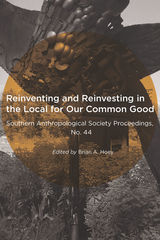 Reinventing and Reinvesting in the Local for Our Common Good: Selected Papers from the Annual Meeting of the Southern Anthropological Society, Huntington, West Virginia, April, 2016
Brian A. Hoey
University of Tennessee Press, 2020 A growing number of cultural anthropologists and others in allied disciplines are doing ethnographic fieldwork in the communities where they live and work. Essays in Reinventing and Reinvesting in the Local for Our Common Good describe an engaged local anthropology that contributes to the common good by informing social change and public policy.
The volume includes examples of citizen or student involvement in ethnographic research: Residents of a rural community were both subjects and collaborators on a study of cultural attachment to land. A group of American university students on an international travel course and their South African peer mentors explored racism and cultural differences in an immersive fieldwork experience.
One essay traces the discipline’s evolving understanding of the ethnographer’s relationship to the community being studied—from dispassionate observer to critically self-conscious participant-observer. Another heralds the success of an unconventional local initiative: a popular radio drama shows great promise for raising HIV awareness among young women in Botswana. A final essay makes a plea for broad public engagement in improving the lives of people with Autism Spectrum Disorder.
These papers were presented at the April 2016 annual meeting of the Southern Anthropological Society (SAS) in Huntington, West Virginia.
BRIAN A. HOEY is associate dean of the Honors College and a professor of anthropology at Marshall University.
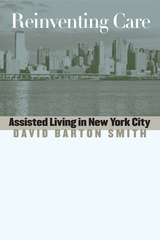 Reinventing Care: Assisted Living in New York City
David Barton Smith
Vanderbilt University Press, 2003 TThe recent growth of "assisted living" facilities and programs has shaken the foundations of the system of long-term care for the elderly in the United States. Fueled by consumer frustrations with the available options, notably nursing homes, the assisted living model emerged during the 1990s to promise shelter, health care, control of one's own life, less government involvement, and a "real home." But how well have the advocates and developers of assisted living delivered on such promises? And what are the model's implications for public policy and the future of caregiving? In Reinventing Care, David Barton Smith offers brilliant insights into those questions by examining the realities of assisted living in New York City. Encompassing the largest, most concentrated population of elderly in the United States, New York spends more per person caring for its seniors than any other urban center. Yet, while the size of the city's care system boggles the mind, it nevertheless contains the same elements that exist in other metropolitan areas and thus provides valuable lessons for the nation as a whole. Smith's study draws on twenty-five years of research, including hundreds of interviews and visits to representative facilities. He provides a succinct overview of how care is presently organized for New York's aging population and traces the history of the system up to the present. Among the key issues he addresses are the role of market forces and government regulation, the impact of class differences on access to quality care, and the ways in which perceptions of community affect the creation and management of assisted living programs. At the heart of the book are ten fascinating case studies, half of them focused on private-pay facilities and the other half on public-pay institutions. While finding that the actualities of assisted living rarely match the rhetoric of its proponents, Smith sees much to admire in its goals. He suggests tactics and strategies--such as promoting family- and community-based models of assisted living and adopting a standard of licensure for certain facilities--that could point the way to a better future.
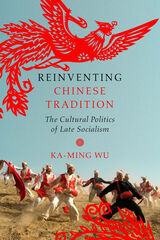 Reinventing Chinese Tradition: The Cultural Politics of Late Socialism
Ka-ming Wu
University of Illinois Press, 2015 The final destination of the Long March and center of the Chinese Communist Party's red bases, Yan'an acquired mythical status during the Maoist era. Though the city's significance as an emblem of revolutionary heroism has faded, today's Chinese still glorify Yan'an as a sanctuary for ancient cultural traditions. Ka-ming Wu's ethnographic account of contemporary Yan'an documents how people have reworked the revival of three rural practices--paper-cutting, folk storytelling, and spirit cults--within (and beyond) the socialist legacy. Moving beyond dominant views of Yan'an folk culture as a tool of revolution or object of market reform, Wu reveals how cultural traditions become battlegrounds where conflicts among the state, market forces, and intellectuals in search of an authentic China play out. At the same time, she shows these emerging new dynamics in the light of the ways rural residents make sense of rapid social change. Alive with details, Reinventing Chinese Tradition is an in-depth, eye-opening study of an evolving culture and society within contemporary China.
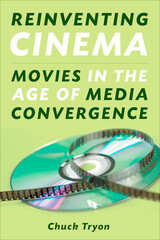 Reinventing Cinema: Movies in the Age of Media Convergence
Tryon, Chuck
Rutgers University Press, 2009 For over a century, movies have played an important role in our lives, entertaining us, often provoking conversation and debate. Now, with the rise of digital cinema, audiences often encounter movies outside the theater and even outside the home. Traditional distribution models are challenged by new media entrepreneurs and independent film makers, usergenerated video, film blogs, mashups, downloads, and other expanding networks. Reinventing Cinema examines film culture at the turn of this century, at the precise moment when digital media are altering our historical relationship with the movies. Spanning multiple disciplines, Chuck Tryon addresses the interaction between production, distribution, and reception of films, television, and other new and emerging media.Through close readings of trade publications, DVD extras, public lectures by new media leaders, movie blogs, and YouTube videos, Tryon navigates the shift to digital cinema and examines how it is altering film and popular culture.
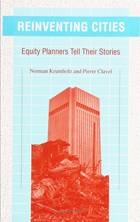 Reinventing Cities: Equity Planners Tell Their Stories
Norman Krumholz and Pierre Clavel
Temple University Press, 1994 Reinventing Cities emphasizes the extraordinary accomplishments of eleven urban planners who work for the needs of low income and working class people. Through the voices of equity planners who have worked "in the trenches" of city halls, Norman Krumholz and Pierre Clavel explore the inner dimensions of social change, economic development, community organizing, and the dynamics of implementing and producing fair housing. Preceded by "snapshots" that describe the demographics, politics, and economics of each specific city or region, the editors' interviews with these leading progressive planners highlight productive strategies, disquieting failures, and the cities in which the fought for equity. Included are conversations with Rick Cohen, former director of Jersey City's Department of Housing and Economic Development; Dale F. Bertsch, former first director of the Miami Valley Regional Planning Commission, Dayton, Ohio; Robert Mier, former commissioner of the Department of Economic Development (DED); Kari J. Moe, former deputy commissioner of Research and Development, DED'; Arturo Vazquez, former director of Mayor Washington's Office of Employment and Training, Chicago; Margaret D. Strachan, former city commissioner, Portland, Oregon; Peter Dreier, former housing director, Boston Redevelopment Authority, and policy aide to Mayor Raymond Flynn; Billie Bramhall, planning staff, Mayor Federico Pena, Denver, Colorado; Howard Stanback, city manager, Hartford, Connecticut; Derek Shearer, former Planning Commission chairman, Santa Monica, California; and Kenneth Grimes, senior planning analyst, San Diego Housing Commission. In the series Conflicts in Urban and Regional Development, edited by John R. Logan and Todd Swanstrom.
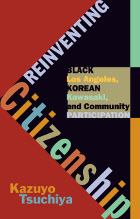 Reinventing Citizenship: Black Los Angeles, Korean Kawasaki, and Community Participation
Kazuyo Tsuchiya
University of Minnesota Press, 2014
In the 1960s and 1970s, the United States and Japan went through massive welfare expansions that sparked debates about citizenship. At the heart of these disputes stood African Americans and Koreans. Reinventing Citizenship offers a comparative study of African American welfare activism in Los Angeles and Koreans’ campaigns for welfare rights in Kawasaki. In working-class and poor neighborhoods in both locations, African Americans and Koreans sought not only to be recognized as citizens but also to become legitimate constituting members of communities.
Local activists in Los Angeles and Kawasaki ardently challenged the welfare institutions. By creating opposition movements and voicing alternative visions of citizenship, African American leaders, Tsuchiya argues, turned Lyndon B. Johnson’s War on Poverty into a battle for equality. Koreans countered the city’s and the nation’s exclusionary policies and asserted their welfare rights. Tsuchiya’s work exemplifies transnational antiracist networking, showing how black religious leaders traveled to Japan to meet Christian Korean activists and to provide counsel for their own struggles. Reinventing Citizenship reveals how race and citizenship transform as they cross countries and continents. By documenting the interconnected histories of African Americans and Koreans in Japan, Tsuchiya enables us to rethink present ideas of community and belonging.
Reinventing Dance in the 1960s: Everything Was Possible
Edited by Sally Banes
University of Wisconsin Press, 2003 The 1960s was a pivotal decade in dance, an era of intense experimentation and rich invention. In this volume an impressive range of dance critics and scholars examine the pioneering choreographers and companies of the era, such as Anna Halprin’s West Coast experiments, the innovative Judson Dance Theater, avant-garde dance subcultures in New York, the work of Meredith Monk and Kenneth King, and parallel movements in Britain. The contributors include Janice Ross, Leslie Satin, Noël Carroll, Gus Solomons jr., Deborah Jowitt, Stephanie Jordan, Joan Acocella, and Sally Banes.
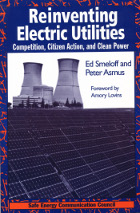 Reinventing Electric Utilities: Competition, Citizen Action, and Clean Power
Ed Smeloff and Peter Asmus; Foreword by Amory Lovins
Island Press, 1997 Traditionally protected as monopolies, electric utilities are now being caught in the fervor for deregulation that is sweeping the country. Nearly forty states have enacted or are considering laws and regulations that will profoundly alter the way the electric utility industry is governed. Concerned citizens are beginning to ponder the environmental implications of such a change, and while many fear that the pressure of competition will exacerbate environmental problems, others argue that deregulation provides a tremendous opportunity for citizens to work toward promoting cleaner energy and a more sustainable way of life. In Reinventing Electric Utilities, Ed Smeloff and Peter Asmus consider the challenges for citizens and the utility industry in this new era of competition. Through an in-depth case study of the Sacramento Municipal Utility District (SMUD), a once-troubled utility that is now widely regarded as a model for energy efficiency and renewable energy development, they explore the changes that have occurred in the utility industry, and the implications of those changes for the future. The SMUD portrait is complemented by regional case studies of Portland General Electric and the Washington Public Power Supply System, the New England Electric Service, Northern States Power, the Electricity Reliability Council of Texas, and others that highlight the efforts of citizen groups and utilities to eliminate unproductive and environmentally damaging sources of power and to promote the use of new, cleaner energy technologies. The authors present and explain some of the fundamental principles that govern restructuring, while acknowledging that solutions will depend upon the unique resource needs, culture, and utility structure of each particular region. Smeloff and Asmus argue that any politically sustainable restructuring of the electric services industry must address the industry's high capital cost commitments and environmental burdens. Throughout, they make the case that with creative leadership, open and competitive markets, and the active participation of citizens, this upheaval offers a unique opportunity for electric utilities to lessen the burden of electricity production on the environment and reduce the cost of electric services through the use of more competitive, cleaner power sources. While neither technological innovation nor the magic of the market will in and of itself reinvent the electric utility industry, the influence of those dynamic forces must be understood. Reinventing Electric Utilities is an important work for policymakers, energy professionals, and anyone concerned about the future of the electric services industry.
 Reinventing Examination and the State in Twentieth-Century China and Taiwan
Shiuon Chu
Harvard University Press After the abolition of the imperial examination system in 1905, what made examinations a trusted method of selection in China and Taiwan? Reinventing Examination and the State traces the ideological evolution of civil service and state-organized educational examinations in twentieth-century China and Taiwan. In the making of the modern Chinese civil service, the concept of examination as a basic power of government was institutionalized as the Examination Yuan in the 1930s and was written into the 1947 Constitution of the Republic of China, which remains in effect in Taiwan today. Meanwhile, two models of educational examination, one of gatekeeping school graduates and the other of mobilizing human resources, emerged during WWII and constituted a repertoire of educational policies shared by the Republic of China and the People’s Republic of China after the 1949 divide. The authority of examination, Shiuon Chu argues, was by no means a natural development from the long history of imperial China but was in fact contingent on specific political maneuverings over the course of the twentieth century. Unlike the imperial examinations, which heavily rewarded participants with titles and fame, modern examinations shaped new concepts about the responsibility of the individual vis-à-vis the state, and this shift contributed to the resilience of the state during times of significant political and social change.
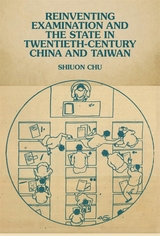 Reinventing Examination and the State in Twentieth-Century China and Taiwan
Shiuon Chu
Harvard University Press After the abolition of the imperial examination system in 1905, what made examinations a trusted method of selection in China and Taiwan? Reinventing Examination and the State traces the ideological evolution of civil service and state-organized educational examinations in twentieth-century China and Taiwan. In the making of the modern Chinese civil service, the concept of examination as a basic power of government was institutionalized as the Examination Yuan in the 1930s and was written into the 1947 Constitution of the Republic of China, which remains in effect in Taiwan today. Meanwhile, two models of educational examination, one of gatekeeping school graduates and the other of mobilizing human resources, emerged during WWII and constituted a repertoire of educational policies shared by the Republic of China and the People’s Republic of China after the 1949 divide. The authority of examination, Shiuon Chu argues, was by no means a natural development from the long history of imperial China but was in fact contingent on specific political maneuverings over the course of the twentieth century. Unlike the imperial examinations, which heavily rewarded participants with titles and fame, modern examinations shaped new concepts about the responsibility of the individual vis-à-vis the state, and this shift contributed to the resilience of the state during times of significant political and social change.
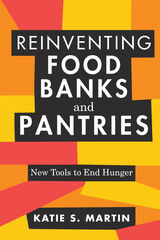 Reinventing Food Banks and Pantries: New Tools to End Hunger
Katie S. Martin
Island Press, 2021 In the US, there is a wide-ranging network of at least 370 food banks, and more than 60,000 hunger-relief organizations such as food pantries and meal programs. These groups provide billions of meals a year to people in need. And yet hunger still affects one in nine Americans. What are we doing wrong?
In Reinventing Food Banks and Pantries, Katie Martin argues that if handing out more and more food was the answer, we would have solved the problem of hunger decades ago. Martin instead presents a new model for charitable food, one where success is measured not by pounds of food distributed but by lives changed. The key is to focus on the root causes of hunger. When we shift our attention to strategies that build empathy, equity, and political will, we can implement real solutions.
Martin shares those solutions in a warm, engaging style, with simple steps that anyone working or volunteering at a food bank or pantry can take today. Some are short-term strategies to create a more dignified experience for food pantry clients: providing client choice, where individuals select their own food, or redesigning a waiting room with better seating and a designated greeter. Some are longer-term: increasing the supply of healthy food, offering job training programs, or connecting clients to other social services. And some are big picture: joining the fight for living wages and a stronger social safety net.
These strategies are illustrated through inspiring success stories and backed up by scientific research. Throughout, readers will find a wealth of proven ideas to make their charitable food organizations more empathetic and more effective. As Martin writes, it takes more than food to end hunger. Picking up this insightful, lively book is a great first step.
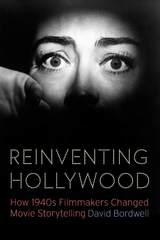 Reinventing Hollywood: How 1940s Filmmakers Changed Movie Storytelling
David Bordwell
University of Chicago Press, 2017 In the 1940s, American movies changed. Flashbacks began to be used in outrageous, unpredictable ways. Soundtracks flaunted voice-over commentary, and characters might pivot from a scene to address the viewer. Incidents were replayed from different characters’ viewpoints, and sometimes those versions proved to be false. Films now plunged viewers into characters’ memories, dreams, and hallucinations. Some films didn’t have protagonists, while others centered on anti-heroes or psychopaths. Women might be on the verge of madness, and neurotic heroes lurched into violent confrontations. Combining many of these ingredients, a new genre emerged—the psychological thriller, populated by women in peril and innocent bystanders targeted for death.
If this sounds like today’s cinema, that’s because it is. In Reinventing Hollywood, David Bordwell examines the full range and depth of trends that crystallized into traditions. He shows how the Christopher Nolans and Quentin Tarantinos of today owe an immense debt to the dynamic, occasionally delirious narrative experiments of the Forties. Through in-depth analyses of films both famous and virtually unknown, from Our Town and All About Eve to Swell Guy and The Guilt of Janet Ames, Bordwell assesses the era’s unique achievements and its legacy for future filmmakers. Reinventing Hollywood is a groundbreaking study of how Hollywood storytelling became a more complex art and essential reading for lovers of popular cinema.
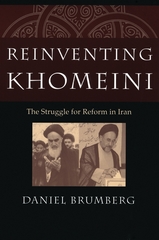 Reinventing Khomeini: The Struggle for Reform in Iran
Daniel Brumberg
University of Chicago Press, 2001 Reinventing Khomeini offers a new interpretation of the political battles that paved the way for reform in Iran. Brumberg argues that these conflicts did not result from a sudden ideological shift; nor did the election of President Mohammad Khatami in 1997 really defy the core principles of the Islamic Revolution. To the contrary, the struggle for a more democratic Iran can be traced to the revolution itself, and to the contradictory agendas of the revolution's founding father, Ayatollah Ruhollah Khomeini.
A complex figure, Khomeini was a fervent champion of Islam, but while he sought a Shi'ite vision of clerical rule under one Supreme Leader, he also strove to mesh that vision with an implicitly Western view of mass participatory politics. The intense magnetism and charisma of the ayatollah obscured this paradox. But reformers in Iran today, while rejecting his autocratic vision, are reviving the constitutional notions of government that he considered, and even casting themselves as the bearers of his legacy. In Reinventing Khomeini, Brumberg proves that the ayatollah is as much the author of modern Iran as he is the symbol of its fundamentalist past.
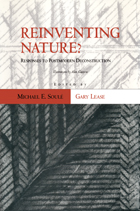 Reinventing Nature?: Responses To Postmodern Deconstruction
Edited by Michael E. Soule and Gary Lease
Island Press, 1995 How much of science is culturally constructed? How much depends on language and metaphor? How do our ideas about nature connect with reality? Can nature be "reinvented" through theme parks and malls, or through restoration? Reinventing Nature? is an interdisciplinary investigation of how perceptions and conceptions of nature affect both the individual experience and society's management of nature. Leading thinkers from a variety of fields -- philosophy, psychology, sociology, public policy, forestry, and others -- address the conflict between perception and reality of nature, each from a different perspective. The editors of the volume provide an insightful introductory chapter that places the book in the context of contemporary debates and a concluding chapter that brings together themes and draws conclusions from the dialogue. In addition to the editors, contributors include Albert Borgmann, David Graber, N. Katherine Hayles, Stephen R. Kellert, Gary P. Nabhan, Paul Shepard, and Donald Worster.
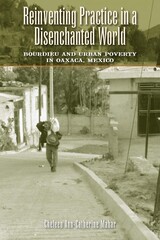 Reinventing Practice in a Disenchanted World: Bourdieu and Urban Poverty in Oaxaca, Mexico
By Cheleen Ann-Catherine Mahar
University of Texas Press, 2010 Colonia Hermosa, now considered a suburb of Oaxaca, began as a squatter settlement in the 1950s. The original residents came in search of transformation from migrants to urban citizens, struggling from rural poverty for the chance to be part of the global economy in Oaxaca. Cheleen Ann-Catherine Mahar charts the lives of a group of residents in Colonia Hermosa over a period of thirty years, as Mexico became more closely tied into the structures of global capital, and the residents of Colonia Hermosa struggled to survive. Residents shape their discussions within a larger narrative, and their talk is the language of the heroic individual, so necessary to the ideology and the functioning of capital. However, this logic only tenuously connects to the actual material circumstances of their lives. Mahar applies the theories of French sociologist Pierre Bourdieu to her data from Mexico in order to examine the class trajectories of migrant families over more than three decades. Through this investigation, Mahar adds an important intergenerational study to the existing body of literature on Oaxaca, particularly concerning the factors that have reshaped the lives of urban working poor families and have created a working-class fraction of globalized citizenship.
 Reinventing Protestant Germany: Religious Nationalists and the Contest for Post-Nazi Democracy
Brandon Bloch
Harvard University Press, 2025 A revealing account of how German Protestant leaders embraced democratic ideals after WWII, while firmly and consequentially refusing to account for their earlier complicity with Nazism.
Germany’s Protestant churches, longtime strongholds of nationalism and militarism, largely backed the Nazi dictatorship that took power in 1933. For many Protestant leaders, pastors, and activists, national and religious revival were one and the same. Even those who opposed the regime tended toward antidemocratic attitudes. By the 1950s, however, Church leaders in West Germany had repositioned themselves as prominent advocates for constitutional democracy and human rights.
Brandon Bloch reveals how this remarkable ideological shift came to pass, following the cohort of theologians, pastors, and lay intellectuals who spearheaded the postwar transformation of their church. Born around the turn of the twentieth century, these individuals came of age amid the turbulence of the Weimar Republic and were easily swayed to complicity with the Third Reich. They accommodated the state in hopes of protecting the Church’s independence from it, but they also embraced the Nazi regime’s antisemitic and anticommunist platform. After the war, under the pressures of Allied occupation, these Protestant intellectuals and their heirs creatively reimagined their tradition as a fount of democratic and humanitarian values. But while they campaigned for family law reform, conscientious objection to military service, and the protection of basic rights, they also promoted a narrative of Christian anti-Nazi resistance that whitewashed the Church’s complicity in dictatorship and genocide.
Examining the sources and limits of democratic transformation, Reinventing Protestant Germany sheds new light on the development of postwar European politics and the power of national myths.
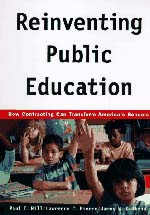 Reinventing Public Education: How Contracting Can Transform America's Schools
Paul Hill, Lawrence C. Pierce, and James W. Guthrie
University of Chicago Press, 1997 A heated debate is raging over our nation’s public schools and how they should be reformed, with proposals ranging from imposing national standards to replacing public education altogether with a voucher system for private schools. Combining decades of experience in education, the authors propose an innovative approach to solving the problems of our school system and find a middle ground between these extremes.
Reinventing Public Education shows how contracting would radically change the way we operate our schools, while keeping them public and accessible to all, and making them better able to meet standards of achievement and equity. Using public funds, local school boards would select private providers to operate individual schools under formal contracts specifying the type and quality of instruction.
In a hands-on, concrete fashion, the authors provide a thorough explanation of the pros and cons of school contracting and how it would work in practice. They show how contracting would free local school boards from operating schools so they can focus on improving educational policy; how it would allow parents to choose the best school for their children; and, finally, how it would ensure that schools are held accountable and academic standards are met.
While retaining a strong public role in education, contracting enables schools to be more imaginative, adaptable, and suited to the needs of children and families. In presenting an alternative vision for America’s schools, Reinventing Public Education is too important to be ignored.
Reinventing Public Service Television for the Digital Future
Mary Debrett
Intellect Books, 2010 Since the 1980s there has been much speculation about the demise of public service television, initially because of the advent of cable and satellite television and the variety of entertainment channels they offer. While the proliferation of global niche media might seem to accelerate the demise of public television, in reality, public broadcasters are undergoing a reinvention. Reinventing Public Service Television for the Digital Future draws on fifty interviews with media industry and academic specialists from four countries to discuss on how public service broadcasting institutions are responding to the changes in digital media. This seminal work offers superior insights into the constraints and possibilities of the public service system and its prospects for survival in the age of on-demand media.
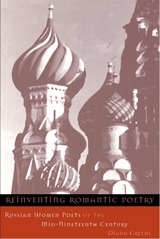 Reinventing Romantic Poetry: Russian Women Poets of the Mid-Nineteenth Century
Diana Greene
University of Wisconsin Press, 2003 Reinventing Romantic Poetry offers a new look at the Russian literary scene in the nineteenth century. While celebrated poets such as Aleksandr Pushkin worked within a male-centered Romantic aesthetic—the poet as a bard or sexual conqueror; nature as a mother or mistress; the poet’s muse as an idealized woman—Russian women attempting to write Romantic poetry found they had to reinvent poetic conventions of the day to express themselves as women and as poets. Comparing the poetry of fourteen men and fourteen women from this period, Diana Greene revives and redefines the women’s writings and offers a thoughtful examination of the sexual politics of reception and literary reputation.
The fourteen women considered wrote poetry in every genre, from visions to verse tales, from love lyrics to metaphysical poetry, as well as prose works and plays. Greene delves into the reasons why their writing was dismissed, focusing in particular on the work of Evdokiia Rostopchina, Nadezhda Khvoshchinskaia, and Karolina Pavlova. Greene also considers class as a factor in literary reputation, comparing canonical male poets with the work of other men whose work, like the women’s, was deemed inferior at the time. The book also features an appendix of significant poems by Russian women discussed in the text. Some, found in archival notebooks, are published here for the first time, and others are reprinted for the first time since the mid-nineteenth century.
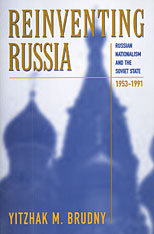 Reinventing Russia: Russian Nationalism and the Soviet State, 1953-1991
Yitzhak M. Brudny
Harvard University Press, 1998 What caused the emergence of nationalist movements in many post-communist states? What role did communist regimes play in fostering these movements? Why have some been more successful than others? To address these questions, Yitzhak Brudny traces the Russian nationalist movement from its origins within the Russian intellectual elite of the 1950s to its institutionalization in electoral alliances, parliamentary factions, and political movements of the early 1990s.
Brudny argues that the rise of the Russian nationalist movement was a combined result of the reinvention of Russian national identity by a group of intellectuals, and the Communist Party's active support of this reinvention in order to gain greater political legitimacy. The author meticulously reconstructs the development of the Russian nationalist thought from Khrushchev to Yeltsin, as well as the nature of the Communist Party response to Russian nationalist ideas. Through analysis of major Russian literary, political, and historical writings, the recently-published memoirs of the Russian nationalist intellectuals and Communist Party officials, and documents discovered in the Communist Party archives, Brudny sheds new light on social, intellectual, and political origins of Russian nationalism, and emphasizes the importance of ideas in explaining the fate of the Russian nationalist movement during late communist and early post-communist periods.
 Reinventing State Capitalism: Leviathan in Business, Brazil and Beyond
Aldo Musacchio and Sergio G. Lazzarini
Harvard University Press, 2014 The wave of liberalization that swept world markets in the 1980s and 90s altered the ways that governments manage their economies. Reinventing State Capitalism analyzes the rise of new species of state capitalism in which governments interact with private investors either as majority or minority shareholders in publicly-traded corporations or as financial backers of purely private firms (the so-called “national champions”). Focusing on a detailed quantitative assessment of Brazil’s economic performance from 1976 to 2009, Aldo Musacchio and Sergio Lazzarini examine how these models of state capitalism influence corporate investment and performance.
According to one model, the state acts as a majority investor, granting the state-owned enterprise (SOE) financial autonomy and allowing professional management. This form, the authors argue, has reduced many agency problems commonly faced by state ownership. According to another hybrid model, the state uses sovereign wealth funds, holding companies, and development banks to acquire a small share of equity ownership in a corporation, thereby potentially alleviating capital constraints and leveraging latent capabilities.
Both models have benefits and costs. Yet neither model has entirely eliminated the temptation of governments to intervene in the operation of natural resource industries and other large strategic enterprises. Nevertheless, the longstanding debate over whether private ownership is superior or inferior to state capitalism has become irrelevant, Musacchio and Lazzarini conclude. Private ownership is now mingled with state capital on a global scale.
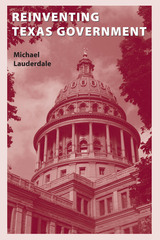 Reinventing Texas Government
By Michael Lauderdale
University of Texas Press, 1999 The Survey of Organizational Excellence is revolutionizing the operation of Texas state agencies and other governmental and private organizations. Developed and refined over the last twenty years by a team of researchers led by Michael Lauderdale, the survey is a proven tool for improving the effectiveness of state government services through surveys of employee attitudes toward their organizations. In this book, Lauderdale gives a history of the survey and its use under four governors, including George W. Bush. He explains what the survey is, how to use it, and how to apply its results to organizational change and improvement. Step-by-step instructions for planning, implementing, and evaluating the survey are enhanced with real-life case studies from the 140,000 surveys that have been distributed and used by more than 75 different organizations. Lauderdale also sets the survey in a broader perspective by identifying some of the forces currently impelling change in organizations throughout our society and exploring where this push for change is taking us.
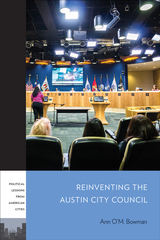 Reinventing the Austin City Council
Ann O'M. Bowman
Temple University Press, 2020 Until recently, Austin, the progressive, politically liberal capital of Texas, elected its city council using a not-so-progressive system. Candidates competed citywide for seats, and voters could cast ballots for as many candidates as there were seats up for election. However, this approach disadvantages the representation of geographically-concentrated minority groups, thereby—among other things—preventing the benefits of growth from reaching all of the city’s communities.
Reinventing the Austin City Council explores the puzzle that was Austin’s reluctance to alter its at-large system and establish a geographically-based, single-member district system. Ann Bowman chronicles the repeated attempts to change the system, the eventual decision to do so, and the consequences of that change. In the process, she explores the many twists and turns that occurred in Austin as it struggled to design a fair system of representation. Reinventing the Austin City Council assesses the impact of the new district system since its inception in 2014.
Austin’s experience ultimately offers a political lesson for creating institutional change.
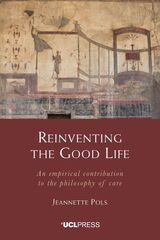 Reinventing the Good Life: An Empirical Contribution to the Philosophy of Care
Jeannette Pols
University College London, 2023 An analytical exploration of what it means to live a good life.
Ever since Adam Smith’s musings on “the invisible hand” became more famous than his work on moral sentiments, social theorists started to pay less attention to everyday ethics and aesthetics. Smith’s metaphor of the invisible hand posits that social outcomes emerge by dint of the behaviors of individuals rather than their intentions or virtues.
Modernist and scientific approaches to determining the common good or good forms of governance have increasingly relied on techniques of generalization, rationalization, and universalization. Everyday ethics and aesthetics—and recently also matters of truth—came to be regarded as individual matters of taste. This shift, however, has meant that we no longer comprehend why and how people display a deep concern with everyday life values in their social practices. People continue to enact these values and live by them while academics lack the vocabulary and methods to grasp them.
By reconstructing the history of ideas about everyday-life values, and by analyzing the role of such values in contemporary care practices for patients with chronic disease in the Netherlands, Reinventing the Good Life seeks to explore new ways to study the values of everyday life, particularly in situations where the achievement of a clear-cut or uniform good is unlikely. The book presents a practice-based epistemology and methodology for studying everyday care practices and supporting their goodness. This analytical approach ultimately aims to generate ideas that will allow us to relate in more imaginative ways to the many pressing concerns that we are forced to live with today.
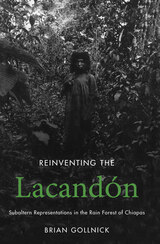 Reinventing the Lacandón: Subaltern Representations in the Rain Forest of Chiapas
Brian Gollnick
University of Arizona Press, 2008 Before massive deforestation began in the 1960s, the Lacandón jungle, which lies on the border of Mexico and Guatemala, was part of the largest tropical rain forest north of the Amazon. The destruction of the Lacandón occurred with little attention from the international press—until January 1, 1994, when a group of armed Maya rebels led by a charismatic spokesperson who called himself Subcomandante Marcos emerged from jungle communities and briefly occupied several towns in the Mexican state of Chiapas. These rebels, known as the Zapatista National Liberation Army, became front-page news around the globe, and they used their notoriety to issue rhetorically powerful communiqués that denounced political corruption, the Mexican government’s treatment of indigenous peoples, and the negative impact of globalization. As Brian Gollnick reveals, the Zapatista communiqués had deeper roots in the Mayan rain forest than Westerners realized—and he points out that the very idea of the jungle is also deeply rooted, though in different ways, in the Western imagination. Gollnick draws on theoretical innovations offered by subaltern studies to discover “oral traces” left by indigenous inhabitants in dominant cultural productions. He explores both how the jungle region and its inhabitants have been represented in literary writings from the time of the Spanish conquest to the present and how the indigenous people have represented themselves in such works, including post-colonial and anti-colonial narratives, poetry, video, and photography. His goal is to show how popular and elite cultures have interacted in creating depictions of life in the rain forest and to offer new critical vocabularies for analyzing forms of cross-cultural expression.
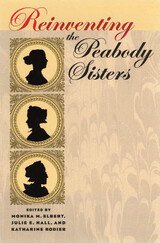 Reinventing the Peabody Sisters
Monika M. Elbert
University of Iowa Press, 2006 Whether in the public realm as political activists, artists, teachers, biographers, editors, and writers or in the more traditional role of domestic, nurturing women, Elizabeth Peabody, Mary Peabody Mann, and Sophia Peabody Hawthorne subverted rigid nineteenth-century definitions of women’s limited realm of influence.
Reinventing the Peabody Sisters seeks to redefine this dynamic trio’s relationship to the literary and political movements of the mid nineteenth century. Previous scholarship has romanticized, vilified, or altogether erased their influences and literary productions or viewed these individuals solely in light of their relationships to other nineteenth-century luminaries, particularly men—Ralph Waldo Emerson, Nathaniel Hawthorne, Horace Mann. This collection underscores that each woman was a creative force in her own right.
Despite their differences and sibling conflicts, all three sisters thrived in the rarefied—if economically modest—atmosphere of a childhood household that glorified intellectual and artistic pursuits. This background allowed each woman to negotiate the nineteenth-century literary marketplace and in the process redefine its scope. Elizabeth, Mary, and Sophia remained linked throughout their lives, encouraging, complementing, and sometimes challenging each other's endeavors while also contributing to each other’s literary work.
The essays in this collection examine the sisters’ confrontations with and involvement in the intellectual movements and social conflicts of the nineteenth century, including Transcendentalism, the Civil War, the role of women, international issues, slavery, Native American rights, and parenting. Among the most revealing writings that the sisters left behind, however, are those which explore the interlaced relationship that continued throughout their remarkable lives.
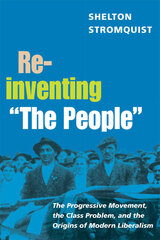 Reinventing "The People": The Progressive Movement, the Class Problem, and the Origins of Modern Liberalism
Shelton Stromquist
University of Illinois Press, 2006 A comprehensive study of the Progressive movement, Reinventing "The People"contends that the persistence of class conflict in America challenged the very defining feature of Progressivism: its promise of social harmony through democratic renewal. Shelton Stromquist profiles the movement's work in diverse arenas of social reform, politics, labor regulation and so-called race improvement. While these reformers emphasized different programs, they crafted a common language of social reconciliation in which an imagined civic community--"the People"--would transcend parochial class and political loyalties. But efforts to invent a society without enduring class lines marginalized new immigrants and African Americans by declaring them unprepared for civic responsibilities. In so doing, Progressives laid the foundation for twentieth-century liberals' inability to see their world in class terms and to conceive of social remedies that might alter the structures of class power.
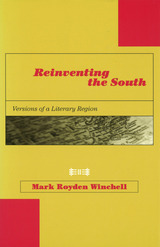 Reinventing the South: Versions of a Literary Region
Mark Royden Winchell
University of Missouri Press, 2006
Before the Civil War, the South had a flourishing culture. In the dormant decades following the surrender at Appomattox, however, southerners devoted most of their energies to survival, neglecting such luxuries as literature. It was not until the 1920s that the South experienced a significant rebirth of literary activity.
Mark Royden Winchell’s book is divided into two sections. The first, entitled “The Nashville Renascence,” examines this resurgence of literature. This movement was partly an attempt to define or reinvent southern culture both socially and aesthetically, and the Fugitives and Agrarians were at the forefront. Essays in this section explore the political and social vision of the Agrarians; discuss prominent charter Agrarians John Gould Fletcher and Robert Penn Warren; and examine the influence the Fugitives and Agrarians have had on later southern literature, even into the twenty-first century.
The second section of the book, “The Lower South,” deals with writers outside the Nashville tradition, including William Faulkner and Tennessee Williams, as well as two novelists who combine elements of southern and western regionalism—William Humphrey and Cormac McCarthy. All of these figures belong to a “lower South,” a region unrelated to the Nashville literati and with an audience less insistently highbrow.
Winchell’s thoughtful and well-informed book includes the most extensive discussions to date of the work of Monroe K. Spears and Walter Sullivan. The essays in this cohesive collection build upon one another to demonstrate how the literary imagination can create different visions of a regional culture and different versions of a regional myth.
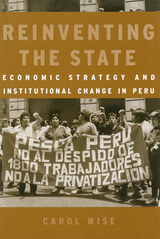 Reinventing the State: Economic Strategy and Institutional Change in Peru
Carol Wise
University of Michigan Press, 2003 The political economic history of Latin America in the post-World War II era has largely been one of underachievement and opportunities lost. This all changed with the wave of market reforms that were implemented in the 1990s. However, the precise role of these reforms as an agent of change is still hotly debated. This in-depth analysis of the Peruvian case argues for an explanation that treats institutional innovation and state reconstruction as necessary conditions for the apparent success of the market in Latin America.
Exploring how state intervention has been both the cause of Latin America's economic downfall in the 1980s and the solution to its recovery, Reinventing the State analyzes three main phases of state intervention: the developmentalism that lasted until 1982, the state in retreat of the 1980s, and the streamlined state of the 1990s. Through a comprehensive examination of the Peruvian experience, the book explains the country's impressive turnaround from the standpoint of institutional modernization and internal state reform.
Written for a broad academic audience, the public-policy community, and the private sector, this book is also meant as a quick primer for any journalist, consultant, or private-sector analyst in need of an overview of the region's market-reform effort and how it has played out in Peru.
Carol Wise is Associate Professor, School of International Relations, University of Southern California.
Reinventing the Sublime: Post-Romantic Literature and Theory
Steven Vine
Sussex Academic Press, 2022 This study looks at the return of the sublime in postmodernity literature as well as the intimations of a post-Romantic sublime in Romanticism itself. It examines 18th-century, Romantic, modernist, and postmodern inventions of the sublime alongside contemporary critical accounts of the relationship of sublimity to subjectivity, aesthetics, politics, and history. It reads Burke and Kant alongside postmodern discourses on the sublime; Wordsworth, De Quincey, and Mary Shelley in relation to temporality and materiality in Romanticism; and considers modernist inflections of the sublime in T. S. Eliot, Virginia Woolf, and Djuna Barnes in relation to the themes of disjunction and excess in modernity. The book focuses on the endurance of the sublime in contemporary thinking, and on the way that the sublime can be read as a figure of the relationship of representation to temporality itself.
 Reinventing the Supply Chain: A 21st-Century Covenant with America
Jack Buffington
Georgetown University Press, 2023 An original vision for using technology to transform supply chains into value chains in order to revitalize American communities When the COVID-19 pandemic led to a global economic “shutdown” in March 2020, our supply chains began to fail, and out-of-stocks and delivery delays became the new norm. Contrary to public perception, the pandemic strain did not break the current system of supply chains; it merely exposed weaknesses and fault lines that were decades in the making, and which were already acutely felt in deindustrialized cities and depopulated rural towns throughout the United States. Reinventing the Supply Chain explores the historical role of supply chains in the global economy, outlines where the system went wrong and what needs to be done to fix it, and demonstrates how a retooled supply chain can lead to the revitalization of American communities. Jack Buffington proposes a transformation of the global supply chain system into a community-based value chain, led by the communities themselves and driven by digital platforms for raising capital and blockchain technology. Buffington proposes new solutions to problems that have been decades in the making. With clear analysis and profound insight, Buffington provides a clear roadmap to a more durable and efficient system.
Reinventing The University: Literacies and Legitimacy in the Postmodern Academy
Christopher L. Schroeder
Utah State University Press, 2001 Christopher Schroeder spends almost no time disputing David Bartholomae's famous essay, but throughout ReInventing the University, he elaborates an approach to teaching composition that is at odds with the tradition that essay has come to represent. On the other hand, his approach is also at odds with elements of the pedagogies of such theorists as Berlin, Bizzell, and Shor. Schroeder argues that, for students, postmodern instability in literacy and meaning has become a question of the legitimacy of current discourse of education. Schroeder is committed, then, to constructing literacies jointly with students and by so doing to bringing students to engage more deeply with education and society.
 Reinventing the Welfare State: Digital Platforms and Public Policies
Ursula Huws
Pluto Press, 2020 The Covid-19 pandemic has tragically exposed how today’s welfare state cannot properly protect its citizens. Despite the valiant efforts of public sector workers, from under-resourced hospitals to a shortage of housing and affordable social care, the pandemic has tragically shown how decades of neglect has caused hundreds to die. In this bold new book, leading policy analyst Ursula Huws shows how we can create a welfare state that is fair, affordable, and offers security for all. Huws focuses on some of the key issues of our time – the gig economy, universal, free healthcare, and social care, to criticize the current state of welfare provision. Drawing on a lifetime of research on these topics, she clearly explains why we need to radically rethink how it could change. With positivity and rigor, she proposes new and original policy ideas, including critical discussions of Universal Basic Income and new legislation for universal workers' rights. She also outlines a 'digital welfare state' for the 21st century. This would involve a repurposing of online platform technologies under public control to modernize and expand public services, and improve accessibility.
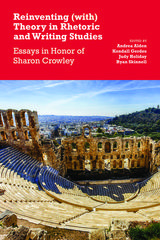 Reinventing (with) Theory in Rhetoric and Writing Studies: Essays in Honor of Sharon Crowley
Andrea Alden
Utah State University Press, 2019 Reinventing (with) Theory in Rhetoric and Writing Studies collects original scholarship that takes up and extends the practices of inventive theorizing that characterize Sharon Crowley’s body of work. Including sixteen chapters by established and emerging scholars and an interview with Crowley, the book shows that doing theory is a contingent and continual rhetorical process that is indispensable for understanding situations and their potential significance—and for discovering the available means of persuasion.
For Crowley, theory is a basic building block of rhetoric “produced by and within specific times and locations as a means of opening other ways of believing or acting.” Doing theory, in this sense, is the practice of surveying the common sense of the community (doxa) and discovering the available means of persuasion (invention). The ultimate goal of doing theory is not to prescribe certain actions but to ascertain what options exist for rhetors to see the world differently, to discover new possibilities for thought and action, and thereby to effect change in the world.
The scholarship collected in Reinventing (with) Theory in Rhetoric and Writing Studies takes Crowley’s notion of theory as an invitation to develop new avenues for believing and acting. By reinventing the understanding of theory and its role in the field, this collection makes an important contribution to scholarship in rhetorical studies and writing studies. It will be valuable to scholars, teachers, and students interested in diverse theoretical directions in rhetoric and writing studies as well as in race, gender, and disability theories, religious rhetorics, digital rhetoric, and the history of rhetoric.
Publication supported in part by the Texas Tech University Humanities Center.
Contributors: Jason Barrett-Fox, Geoffrey Clegg, Kirsti Cole, Joshua Daniel-Wariya, Diane Davis, Rebecca Disrud, Bre Garrett, Catherine C. Gouge, Debra Hawhee, Matthew Heard, Joshua C. Hilst, David G. Holmes, Bruce Horner, William B. Lalicker, Jennifer Lin LeMesurier, James C. McDonald, Timothy Oleksiak, Dawn Penich-Thacker, J. Blake Scott, Victor J. Vitanza, Susan Wyche
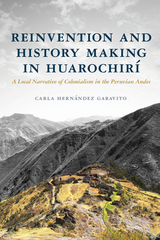 Reinvention and History Making in Huarochirí: A Local Narrative of Colonialism in the Peruvian Andes
Carla Hernández Garavito
University of Arizona Press, 2026 Within just two generations, communities in the Peruvian Andes experienced conquest by the Indigenous Inka Empire (1450–1532 CE) and the European Spanish (1532–1821 CE), leading to three centuries of colonial subjugation. Reinvention and History Making in Huarochirí is an archaeological and historical rendering of the experience of the people of Huarochirí (Lima, Peru) and their interactions with successive waves of colonialism.
Using archaeological and historical datasets and spatial modeling, this book centers on local memory and experience throughout colonized landscapes as the thread that connects the long history of Indigenous engagement with expanding colonial empires and the emergent Peruvian nation. The author builds on Andean epistemological frameworks to argue that in the face of drastic sociopolitical changes, the people of Huarochirí turned to their own history. They created analogies and shared spaces between local and Inka landscapes and materiality and incorporated written representations and ideas of settled lives to validate their claims.
This exciting new work moves the field of Andean archaeology into conversations with decolonial and decolonizing methodologies and shows how Indigenous communities captured and made sense of their long history, reframing colonialism as a local experience.
 The Reinvention of Mexico in Contemporary Spanish Travel Writing
Jane Hanley
Vanderbilt University Press, 2021 The long history of transatlantic movement in the Spanish-speaking world has had a significant impact on present-day concepts of Mexico and the implications of representing Mexico and Latin America more generally in Spain, Europe, and throughout the world. In addition to analyzing texts that have received little to no critical attention, this book examines the connections between contemporary travel, including the local dynamics of encounters and the global circulation of information, and the significant influence of the history of exchange between Spain and Mexico in the construction of existing ideas of place.
To frame the analysis of contemporary travel writing, author Jane Hanley examines key moments in the history of Mexican-Spanish relations, including the origins of narratives regarding Spaniards' sense of Mexico's similarity to and difference from Spain. This history underpins the discussion of the role of Spanish travelers in their encounters with Mexican peoples and places and their reflection on their own role as communicators of cultural meaning and participants in the tourist economy with its impact—both negative and positive—on places.
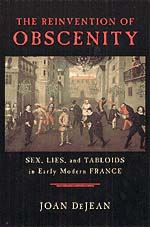 The Reinvention of Obscenity: Sex, Lies, and Tabloids in Early Modern France
Joan DeJean
University of Chicago Press, 2002 The concept of obscenity is an ancient one. But as Joan DeJean suggests, its modern form, the same version that today's politicians decry and savvy artists exploit, was invented in seventeenth-century France.
The Reinvention of Obscenity casts a fresh light on the mythical link between sexual impropriety and things French. Exploring the complicity between censorship, print culture, and obscenity, DeJean argues that mass market printing and the first modern censorial machinery came into being at the very moment that obscenity was being reinvented—that is, transformed from a minor literary phenomenon into a threat to society. DeJean's principal case in this study is the career of Moliére, who cannily exploited the new link between indecency and female genitalia to found his career as a print author; the enormous scandal which followed his play L'école des femmes made him the first modern writer to have his sex life dissected in the press.
Keenly alert to parallels with the currency of obscenity in contemporary America, The Reinvention of Obscenity will concern not only scholars of French history, but anyone interested in the intertwined histories of sex, publishing, and censorship.
 Rejecting Climate Doomism
Diana Stuart
University of Michigan Press, 2026 As scientists call for widespread climate action, there has been an alarming rise in climate doomism, the belief that it is too late to do anything about climate change. Many people who struggle to imagine the solutions and social order that would be needed to support more sustainable outcomes instead look away and do nothing, immobilized by defeatist thinking. Yet every fraction of a degree of warming avoided means saving lives and livelihoods in the future.
Drawing from climate science, sociology, psychology, and philosophy, Rejecting Climate Doomism outlines the reasons to instead choose action grounded in active hope. It examines how global warming could be effectively limited through specific policy proposals. Despite the many obstacles to achieving some of the policies discussed in this book, they are still possible and worth pursuing. By outlining a positive vision of the far-reaching changes that can be used to minimize warming, the book encourages readers to advocate for the social and economic changes necessary to forge the best path for people and the planet.
Rejoining the Common Reader: Essays, 1962-1990
Clara Claiborne Park
Northwestern University Press, 1991 Rejoining the Common Reader is suffused with the impulse that motivates Clara Claiborne Park's distinguished writing and teaching: the desire to related literature to the experience of its readers. This humane, balanced, and entertaining book will appeal to anyone who longs to recapture the pleasure of reading for personal enrichment and to teachers of literature who have grown to resent the intrusiveness of theory and theorizing and wish to reexamine what they are doing to, for, and with their students.
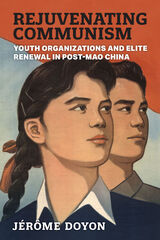 Rejuvenating Communism: Youth Organizations and Elite Renewal in Post-Mao China
Jérôme Doyon
University of Michigan Press, 2023 Working for the administration remains one of the most coveted career paths for young Chinese. Rejuvenating Communism: Youth Organizations and Elite Renewal in Post-Mao China seeks to understand what motivates young and educated Chinese to commit to a long-term career in the party-state and how this question is central to the Chinese regime’s ability to maintain its cohesion and survive. Jérôme Doyon draws upon extensive fieldwork and statistical analysis in order to illuminate the undogmatic commitment recruitment techniques and other methods the state has taken to develop a diffuse allegiance to the party-state in the post-Mao era. He then analyzes recruitment and political professionalization in the Communist Party’s youth organizations and shows how experiences in the Chinese Communist Youth League transform recruits and feed their political commitment as they are gradually inducted into the world of officials. As the first in-depth study of the Communist Youth League’s role in recruitment, this book challenges the assumption that merit is the main criteria for advancement within the party-state, an argument with deep implications for understanding Chinese politics today.
Rejuvenating the Humanities
Ray B. Browne
University of Wisconsin Press, 1992 The twenty essays in this effort to bring new vitality to the humanities range through fields familiar in life but unfamiliar in the humanities canon. They include leisure, folk cultures, material culture, pornography, comics, animal rights, Black studies, traveling, and, of course, the bugbear of academics, television.
Rekindling the Sacred Fire: Métis Ancestry and Anishinaabe Spirituality
Chantal Fiola
University of Manitoba Press, 2015 The Haudenosaunee, more commonly known as the Iroquois or Six Nations, have been one of the most widely written about Indigenous groups in the United States and Canada. But seldom have the voices emerging from this community been drawn on in order to understand its enduring intellectual traditions. Rick Monture’s We Share Our Matters offers the first comprehensive portrait of how the Haudenosaunee of the Grand River region have expressed their long struggle for sovereignty in Canada. Through careful readings of more than two centuries of letters, speeches, ethnography, poetry, fiction, nonfiction, and film, Monture argues Haudenosaunee core beliefs have remained remarkably consistent and continue to inspire ways to address current social and political realities.
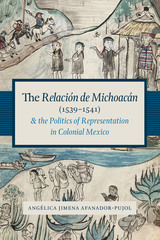 The Relación de Michoacán (1539-1541) and the Politics of Representation in Colonial Mexico
By Angélica Jimena Afanador-Pujol
University of Texas Press, 2015 Through close readings of the painted images in a major sixteenth-century illustrated manuscript, this book demonstrates the critical role that images played in ethnic identity formation and politics in colonial Mexico. The Relación de Michoacán (1539–1541) is one of the earliest surviving illustrated manuscripts from colonial Mexico. Commissioned by the Spanish viceroy Antonio de Mendoza, the Relación was produced by a Franciscan friar together with indigenous noble informants and anonymous native artists who created its forty-four illustrations. To this day, the Relación remains the primary source for studying the pre-Columbian practices and history of the people known as Tarascans or P’urhépecha. However, much remains to be said about how the Relación’s colonial setting shaped its final form. By looking at the Relación in its colonial context, this study reveals how it presented the indigenous collaborators a unique opportunity to shape European perceptions of them while settling conflicting agendas, outshining competing ethnic groups, and carving a place for themselves in the new colonial society. Through archival research and careful visual analysis, Angélica Afanador-Pujol provides a new and fascinating account that situates the manuscript’s images within the colonial conflicts that engulfed the indigenous collaborators. These conflicts ranged from disputes over political posts among indigenous factions to labor and land disputes against Spanish newcomers. Afanador-Pujol explores how these tensions are physically expressed in the manuscript’s production and in its many contradictions between text and images, as well as in numerous emendations to the images. By studying representations of justice, landscape, conquest narratives, and genealogy within the Relación, Afanador-Pujol clearly demonstrates the visual construction of identity, its malleability, and its political possibilities.
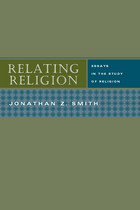 Relating Religion: Essays in the Study of Religion
Jonathan Z. Smith
University of Chicago Press, 2004 One of the most influential theorists of religion, Jonathan Z. Smith is best known for his analyses of religious studies as a discipline and for his advocacy and refinement of comparison as the basis for the history of religions. Relating Religion gathers seventeen essays—four of them never before published—that together provide the first broad overview of Smith's thinking since his seminal 1982 book, Imagining Religion.
Smith first explains how he was drawn to the study of religion, outlines his own theoretical commitments, and draws the connections between his thinking and his concerns for general education. He then engages several figures and traditions that serve to define his interests within the larger setting of the discipline. The essays that follow consider the role of taxonomy and classification in the study of religion, the construction of difference, and the procedures of generalization and redescription that Smith takes to be key to the comparative enterprise. The final essays deploy features of Smith's most recent work, especially the notion of translation.
Heady, original, and provocative, Relating Religion is certain to be hailed as a landmark in the academic study and critical theory of religion.
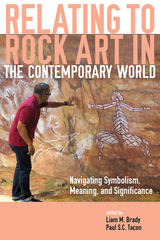 Relating to Rock Art in the Contemporary World: Navigating Symbolism, Meaning, and Significance
Liam M. Brady
University Press of Colorado, 2016 Rock art has long been considered an archaeological artifact reflecting activities from the past, yet it is also a phenomenon with present-day meaning and relevance to both indigenous and non-indigenous communities. Relating to Rock Art in the Contemporary World challenges traditional ways of thinking about this highly recognizable form of visual heritage and provides insight into its contemporary significance.
One of the most visually striking forms of material culture embedded in landscapes, rock art is ascribed different meanings by diverse groups of people including indigenous peoples, governments, tourism offices, and the general public, all of whom relate to images and sites in unique ways. In this volume, leading scholars from around the globe shift the discourse from a primarily archaeological basis to one that examines the myriad ways that symbolism, meaning, and significance in rock art are being renegotiated in various geographical and cultural settings, from Australia to the British Isles. They also consider how people manage the complex meanings, emotions, and cultural and political practices tied to rock art sites and how these factors impact processes relating to identity construction and reaffirmation today.
Richly illustrated and geographically diverse, Relating to Rock Art in the Contemporary World connects archaeology, anthropology, and heritage studies. The book will appeal to students and scholars of archaeology, anthropology, heritage, heritage management, identity studies, art history, indigenous studies, and visual theory, as well as professionals and amateurs who have vested or avocational interests in rock art.
Contributors: Agustín Acevedo, Manuel Bea, Jutinach Bowonsachoti, Gemma Boyle, John J. Bradley, Noelene Cole, Inés Domingo, Kurt E. Dongoske, Davida Eisenberg-Degen, Dánae Fiore, Ursula K. Frederick, Kelley Hays-Gilpin, Catherine Namono, George H. Nash, John Norder, Marianna Ocampo, Joshua Schmidt, Duangpond Singhaseni, Benjamin W. Smith, Atthasit Sukkham, Noel Hidalgo Tan, Watinee Tanompolkrang, Luke Taylor, Dagmara Zawadzka
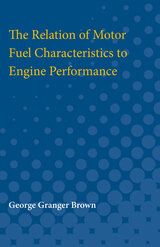 Relation of Motor Fuel Characteristics to Engine Performance
George Granger Brown
University of Michigan Press, 1927 This publication looks at the relation of motor fuel characteristics to engine performance. In order to give satisfactory engine performance a motor fuel must have adequate partial volatility to enable the motor to be started and operated at the lowest temperatures found in the manifold. The dew point or temperature of complete vaporization should be low enough to prevent condensation on the cylinder walls, and high enough to prevent appreciable superheating of the mixture in highly heated manifolds. The vapor pressure should be limited in order to prevent gassing in the carburetor bowl or fuel ducts. The anti-knock quality of the fuel should be sufficient to prevent engine knocking and the accompanying loss in power and efficiency.Fuels meeting these requirements of volatility may be produced at no increase in cost by blending material having the desired volatility at low temperatures with other material having the desired dew points. Anti-knock qualities are generally improved by increasing the volatility but can be best obtained by selecting or treating the fuel specifically for this purpose.
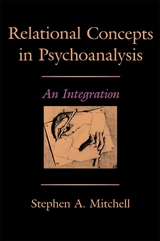 Relational Concepts in Psychoanalysis: An Integration
Stephen Mitchell
Harvard University Press, 1988 There are more psychoanalytic theories today than anyone knows what to do with, and the heterogeneity and complexity of the entire body of psychoanalytic though have become staggering. In Relational Concepts in Psychoanalysis, Stephen A. Mitchell weaves strands from the principal relational-model traditions (interpersonal psychoanalysis, British school object-relations theories, self psychology, and existential psychoanalysis) into a comprehensive approach to many of the knottiest problems and controversies in theoretical and clinical psychoanalysis.
Mitchell’s earlier book, Object Relations in Psychoanalytic Theory, co-authored with Jay Greenberg, set the stage for this current integration by providing a broad comparative analysis of important thinking on the nature of human relationships. In that classic study Greenberg and Mitchell distinguished between two basic paradigms: the drive model, in which relations with others are generated and shaped by the need for drive gratifications, and various relational models, in which relations themselves are taken as primary and irreducible. In Relational Concepts in Psychoanalysis, Mitchell argues that the drive model has since outlived its usefulness. The relational model, on the other hand, has been developed piecemeal by different authors who rarely acknowledge and explore the commonality of their assumptions or the rich complementarity of their perspectives.
In this bold effort at integrative theorizing, Mitchell draws together major lines of relational-model traditions into a unified framework for psychoanalytic thought, more economical than the anachronistic drive model and more inclusive than any of the singular relational approaches to the core significance of sexuality, the impact of early experience, the relation of the past to the present, the interpenetration of illusion and actuality, the centrality of the will, the repetition of painful experience, the nature of analytic situation, and the process of analytic change. As such, his book will be required reading for psychoanalytic scholars, practitioners, candidates in psychoanalysis, and students in the field.
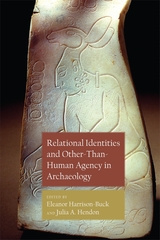 Relational Identities and Other-than-Human Agency in Archaeology
Eleanor Harrison-Buck
University Press of Colorado, 2020 Relational Identities and Other-than-Human Agency in Archaeology explores the benefits and consequences of archaeological theorizing on and interpretation of the social agency of nonhumans as relational beings capable of producing change in the world. The volume cross-examines traditional understanding of agency and personhood, presenting a globally diverse set of case studies that cover a range of cultural, geographical, and historical contexts.
Agency (the ability to act) and personhood (the reciprocal qualities of relational beings) have traditionally been strictly assigned to humans. In case studies from Ghana to Australia to the British Isles and Mesoamerica, contributors to this volume demonstrate that objects, animals, locations, and other nonhuman actors also potentially share this ontological status and are capable of instigating events and enacting change. This kind of other-than-human agency is not a one-way transaction of cause to effect but requires an appropriate form of reciprocal engagement indicative of relational personhood, which in these cases, left material traces detectable in the archaeological record.
Modern dualist ontologies separating objects from subjects and the animate from the inanimate obscure our understanding of the roles that other-than-human agents played in past societies. Relational Identities and Other-than-Human Agency in Archaeology challenges this essentialist binary perspective. Contributors in this volume show that intersubjective (inherently social) ways of being are a fundamental and indispensable condition of all personhood and move the debate in posthumanist scholarship beyond the polarizing dichotomies of relational versus bounded types of persons. In this way, the book makes a significant contribution to theory and interpretation of personhood and other-than-human agency in archaeology.
Contributors:
Susan M. Alt, Joanna Brück, Kaitlyn Chandler, Erica Hill, Meghan C. L. Howey, Andrew Meirion Jones, Matthew Looper, Ian J. McNiven, Wendi Field Murray, Timothy R. Pauketat, Ann B. Stahl, Maria Nieves Zedeño
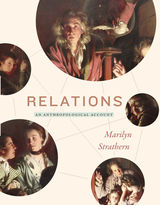 Relations: An Anthropological Account
Marilyn Strathern
Duke University Press, 2020 The concept of relation holds a privileged place in how anthropologists think and write about the social and cultural lives they study. In Relations, eminent anthropologist Marilyn Strathern provides a critical account of this key concept and its usage and significance in the English-speaking world. Exploring relation's changing articulations and meanings over the past three centuries, Strathern shows how the historical idiosyncrasy of using an epistemological term for kinspersons (“relatives”) was bound up with evolving ideas about knowledge-making and kin-making. She draws on philosophical debates about relation—such as Leibniz's reaction to Locke—and what became its definitive place in anthropological exposition, elucidating the underlying assumptions and conventions of its use. She also calls for scholars in anthropology and beyond to take up the limitations of Western relational thinking, especially against the background of present ecological crises and interest in multispecies relations. In weaving together analyses of kin-making and knowledge-making, Strathern opens up new ways of thinking about the contours of epistemic and relational possibilities while questioning the limits and potential of ethnographic methods.
 The Relationship Code: Deciphering Genetic and Social Influences on Adolescent Development
David Reiss, Jenae M. Neiderhiser, E. Mavis Hetherington, Robert Plomin
Harvard University Press, 2000 The Relationship Code is the report of a longitudinal study, conducted over a ten-year period, of the influence of family relationships and genetic factors on competence and psychopathology in adolescent development. The sample for this landmark study included 720 pairs of same-sex adolescent siblings—including twins, half siblings, and genetically unrelated siblings—and their parents.
Using a clear expressive style, David Reiss and his coinvestigators identify specific mechanisms that link genetic factors and the social environment in psychological development. They propose a striking hypothesis: family relationships are crucial to the expression of genetic influences on a broad array of complex behaviors in adolescents. Moreover, this role of family relationships may be very specific: some genetic factors are linked to mother–child relationships, others to father–child relations, some to relationship warmth, while others are linked to relationship conflict or control. The specificity of these links suggests that family relationships may constitute a code for translating genetic influences into the ontogeny of behaviors, a code every bit as important for behavior as DNA-RNA.
Relationship: The Heart of Helping People
Helen Harris Perlman
University of Chicago Press, 1979 "Like the subject about which she writes, Perlman engages the reader immediately, permitting a view into the author's rich and varied experiences, threaded throughout with profound compassion for all those who seek, suffer, and strive. . . . [This is] a welcome and wise effort, written with grace, sense and deep humanism. Were it in my power I would make it mandatory reading for all those who seek to offer others help."—Shirley Cooper, American Journal of Orthopsychiatry
 Relativ Frequency of English Speech Sounds: Second Edition
Godfrey Dewey
Harvard University Press This investigation, based on a sufficient number and variety of modern texts, conducted on sound principles and with scrupulous care, aside from its obvious utility for shorthand and for instruction in reading, is of value to phoneticians in that it affords abundant choice material for the study of the adjustment of sound to sound in the syllable. To the linguist it furnishes also a starting point for comparison of one language with another, in respect either to acoustic effect or to the characteristic operations of the vocal organs; and it provides, in its word list, a foundation for comparative estimates of current vocabulary as an index of national civilization. To one interested in the history of speech, or the history of thought, it suggests and facilitates a series of comparisons of present and past aspects of English, whether one consider the language as an aggregate of sound-patterns or as a medium of expression. Multiple are the uses to which these tables may be put. It is to be hoped that many scholars, in many fields, will avail themselves of them.
[Note accompanying the Original Edition © 1923, Graduate School of Education, Harvard University:]
The text of this investigation is speld in accord with the recommendations of the Simplified Spelling Board. In the material investigated the conventional spelling, as found, has been adhered to strictly thruout.
The fonetist and filologist has always been among the first to recognize the immense importance of the movement for reform of English spelling, which commands the united support of the leading language scolars both of England and America. He should be willing to bear his share of the prejudice which some must endure in the course of progress toward a rational orthografy.
Simpler Spelling Association, Lake Placid Club, N.Y., wil send ful information concerning this important movement on request.
The Relative Native: Essays on Indigenous Conceptual Worlds
Eduardo Viveiros de Castro
HAU, 2015 This volume is the first to collect the most influential essays and lectures of Eduardo Viveiros de Castro. Published in a wide variety of venues, and often difficult to find, the pieces are brought together here for the first time in a one major volume, which includes his momentous 1998 Cambridge University Lectures, “Cosmological Perspectivism in Amazonia and Elsewhere.” Rounded out with new English translations of a number of previously unpublished works, the resulting book is a wide-ranging portrait of one of the towering figures of contemporary thought—philosopher, anthropologist, ethnographer, ethnologist, and more. With a new afterword by Roy Wagner elucidating Viveiros de Castro’s work, influence, and legacy, The Relative Native will be required reading, further cementing Viveiros de Castro’s position at the center of contemporary anthropological inquiry.
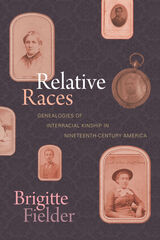 Relative Races: Genealogies of Interracial Kinship in Nineteenth-Century America
Brigitte Fielder
Duke University Press, 2020 In Relative Races, Brigitte Fielder presents an alternative theory of how race is ascribed. Contrary to notions of genealogies by which race is transmitted from parents to children, the examples Fielder discusses from nineteenth-century literature, history, and popular culture show how race can follow other directions: Desdemona becomes less than fully white when she is smudged with Othello's blackface, a white woman becomes Native American when she is adopted by a Seneca family, and a mixed-race baby casts doubt on the whiteness of his mother. Fielder shows that the genealogies of race are especially visible in the racialization of white women, whose whiteness often depends on their ability to reproduce white family and white supremacy. Using black feminist and queer theories, Fielder presents readings of personal narratives, novels, plays, stories, poems, and images to illustrate how interracial kinship follows non-heteronormative, non-biological, and non-patrilineal models of inheritance in nineteenth-century literary culture.
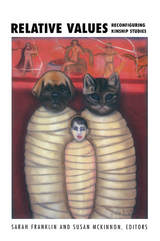 Relative Values: Reconfiguring Kinship Studies
Sarah Franklin and Susan McKinnon, eds.
Duke University Press, 2001 The essays in Relative Values draw on new work in anthropology, science studies, gender theory, critical race studies, and postmodernism to offer a radical revisioning of kinship and kinship theory. Through a combination of vivid case studies and trenchant theoretical essays, the contributors—a group of internationally recognized scholars—examine both the history of kinship theory and its future, at once raising questions that have long occupied a central place within the discipline of anthropology and moving beyond them. Ideas about kinship are vital not only to understanding but also to forming many of the practices and innovations of contemporary society. How do the cultural logics of contemporary biopolitics, commodification, and globalization intersect with kinship practices and theories? In what ways do kinship analogies inform scientific and clinical practices; and what happens to kinship when it is created in such unfamiliar sites as biogenetic labs, new reproductive technology clinics, and the computers of artificial life scientists? How does kinship constitute—and get constituted by—the relations of power that draw lines of hierarchy and equality, exclusion and inclusion, ambivalence and violence? The contributors assess the implications for kinship of such phenomena as blood transfusions, adoption across national borders, genetic support groups, photography, and the new reproductive technologies while ranging from rural China to mid-century Africa to contemporary Norway and the United States. Addressing these and other timely issues, Relative Values injects new life into one of anthropology's most important disciplinary traditions. Posing these and other timely questions, Relative Values injects an important interdisciplinary curiosity into one of anthropology’s most important disciplinary traditions. Contributors. Mary Bouquet, Janet Carsten, Charis Thompson Cussins, Carol Delaney, Gillian Feeley-Harnik, Sarah Franklin, Deborah Heath, Stefan Helmreich, Signe Howell, Jonathan Marks, Susan McKinnon, Michael G. Peletz, Rayna Rapp, Martine Segalen, Pauline Turner Strong, Melbourne Tapper, Karen-Sue Taussig, Kath Weston, Yunxiang Yan
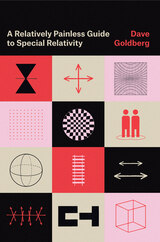 A Relatively Painless Guide to Special Relativity
Dave Goldberg
University of Chicago Press, 2023 Serious and accessible—finally the special relativity course book that both physics majors and lifelong learners deserve.
Special relativity challenges one’s physical intuition of space, time, matter, and energy in a way that few other topics in physics do. Yet the subject is often treated as an extra in undergraduate courses—something to be picked up in a few random lectures and presented as a combination of geometric and logical puzzles (seemingly with the premise of getting the novice student to concede that Einstein was a genius and that the universe is weird). But special relativity is absolutely fundamental to modern physics. It is the canvas on which electromagnetism, particle physics, field theory, and ultimately general relativity are based. For physics students, developing a relativistic intuition isn’t just a luxury: it’s a requirement.
Physicist and popular author Dave Goldberg provides a rigorous but conversational introduction to fill this void in spacetime education. Employing the standard calculus a sophomore or junior university student in science, engineering, or computer science will have encountered, Goldberg connects relativity to a student’s work ahead, acquainting them with topics like tensors, the development of new physical theories, and how relativity directly relates to other disciplines. But more than this, Goldberg welcomes lifelong learners who may have encountered special relativity in popular accounts, but are seeking a mathematical challenge to understand an elegant physical theory.
 Relativistic Astrophysics, 2: The Structure and Evolution of the Universe
Ya. B. Zel'dovich and I. D. Novikov
University of Chicago Press, 1983 Though the kinematics of the evolving universe became known decades ago, research into the physics of processes occurring in the expanding universe received a reliable observational and theoretical basis only in more recent years. These achievements have led in turn to the emergence of new problems, on which an unusually active assault has begun.
This second volume of Relativistic Astrophysics provides a remarkably complete picture of the present state of cosmology. It is a synthesis of the theoretical foundations of contemporary cosmology, which are derived from work in relativity, plasma theory, thermodynamics, hydrodynamics, and particle physics. It presents the theoretical work that explains, describes, and predicts the nature of the universe, the physical process that occur in it, the formation of galaxies, the synthesis of the light elements, and the cosmological singularity and the theory of gravitation.
This book, long and eagerly awaited, is essential for everyone whose work is related to cosmology and astrophysics.
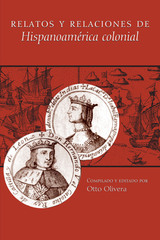 Relatos y relaciones de Hispanoamérica colonial
Compilado y editado por Otto Olivera
University of Texas Press, 2004 This anthology of foundational sixteenth-century Spanish-language texts presents the European side of the discovery and colonization of the New World. Otto Olivera has chosen representative selections from the works of eighteen authors, including Garcilaso de la Vega, Bartolomé de Las Casas, Bernal Díaz del Castillo, Hernán Cortés, and Alvar Núñez Cabeza de Vaca. Their writings present an impressive panorama of the first years of a real New World that could compete with any portrayed in European novels of chivalry or travel. To put these texts in historical context, Olivera has written an introduction that links the literature of colonization in its first century to the classical and medieval myths that helped shape Spaniards' thinking about the New World. He also provides a brief history of the discovery and conquest and a discussion of the social organization of the Spanish colonies.
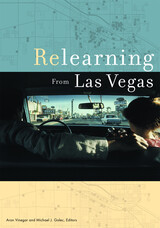 Relearning from Las Vegas
Aron Vinegar
University of Minnesota Press, 2009 Evaluates for the first time one of the foundational works in architecture criticism Immediately on its publication in 1972, Learning from Las Vegas, by Robert Venturi, Denise Scott Brown, and Steven Izenour, was hailed as a transformative work in the history and theory of architecture, liberating those in architecture who were trying to find a way out of the straitjacket of architectural orthodoxies. Resonating far beyond the professional and institutional boundaries of the field, the book contributed to a thorough rethinking of modernism and was subsequently taken up as an early manifestation and progenitor of postmodernism. Going beyond analyzing the original text, the essays provide insights into the issues surrounding architecture, culture, and philosophy that have been influenced by Learning from Las Vegas. For the contributors, as for scholars in an array of fields, the pioneering book is as relevant to architectural debates today as it was when it was first published.Contributors: Ritu Bhatt, Karsten Harries, Jean-Claude Lebensztejn, John McMorrough, Katherine Smith, Dell Upton, Nigel Whitely.
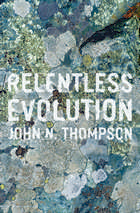 Relentless Evolution
John N. Thompson
University of Chicago Press, 2013 At a glance, most species seem adapted to the environment in which they live. Yet species relentlessly evolve, and populations within species evolve in different ways. Evolution, as it turns out, is much more dynamic than biologists realized just a few decades ago. In Relentless Evolution, John N. Thompson explores why adaptive evolution never ceases and why natural selection acts on species in so many different ways. Thompson presents a view of life in which ongoing evolution is essential and inevitable. Each chapter focuses on one of the major problems in adaptive evolution: How fast is evolution? How strong is natural selection? How do species co-opt the genomes of other species as they adapt? Why does adaptive evolution sometimes lead to more, rather than less, genetic variation within populations? How does the process of adaptation drive the evolution of new species? How does coevolution among species continually reshape the web of life? And, more generally, how are our views of adaptive evolution changing? Relentless Evolution draws on studies of all the major forms of life—from microbes that evolve in microcosms within a few weeks to plants and animals that sometimes evolve in detectable ways within a few decades. It shows evolution not as a slow and stately process, but rather as a continual and sometimes frenetic process that favors yet more evolutionary change.
 The Relevance of International Adjudication
Milton Katz
Harvard University Press It has been an ancient and tenacious human hope that mankind could apply to the no man's land between states the experience of domestic law in curbing violence and settling disputes. Within a society, the use of law to resolve disputes and contain violence centers in the courts and the police. Men anxious to restrain international aggression and settle international disputes peaceably have long sought to invoke international policing and adjudication under law. Twice within the past half-century, they have undertaken to build worldwide organizations to keep the peace. The United Nations system assigns a critical role to adjudication under the Charter and international law.
In this book, one of America's foremost legal scholars, who has extensive experience in foreign policy, administration, and international law, explores whether and to what extent decisions by international tribunals have been significant, or may yet be significant, for the settlement of international disputes. Mr. Katz believes that adjudication as an institution ranks among the great creative achievements of mankind, but it has its limitations--limits both in current practice and in its potential scope.
In presenting his argument; Mr. Katz concentrates upon the period since the end of World War II and deals primarily with international conflict within the experience of the United Nations and the International Court of Justice. He focuses on disputes resulting from the Cold War and on those between established industrial states and newly emerging states or peoples that have not yet attained a full measure of self-government.
In examining what happened and appraising what might have happened; Mr. Katz keeps the reader constantly aware of the many meanings of law; and of the need to sort out the different meanings in order to apply law effectively. Without an understanding of the effective reach and the limits of adjudication; he insists; we will waste opportunities for settling international controversies. We can waste opportunities by failing to use international tribunals where they can be effective; we can dissipate the precious resource of adjudication in wishful misapplications; and in misapplying adjudication; we can divert our attention from other ways and means more pertinent to the settlement of particular international disputes.
The Relevance of Philosophy to Life
John Lachs
Vanderbilt University Press, 1995 With The Relevance of Philosophy to Life, eminent American philosopher John Lachs reminds us that philosophy is not merely a remote subject of academic research and discourse, but an ever-changing field which can help us navigate through some of the chaos of late twentieth-century living. It provides a clear-eyed look at important philosophical issues--the primacy of values, rationality and irrationality, society and its discontents, life and death, and the traits of human nature--as related to the human condition in the modern world.
Relevant Linguistics: An Introduction to the Structure and Use of English for Teachers
Paul W. Justice
CSLI, 2001 As linguistic diversity in schools continues to rise, more educators find themselves studying linguistics in teacher training programs. Unfortunately, the vast majority of introductory linguistics texts do not address their needs; such teachers are likely to find the texts inaccessible and irrelevant. Relevant Linguistics, written with teachers and future teachers in mind, provides a straightforward, accessible introduction to the basics of phonetics, phonology, morphology, and syntax.
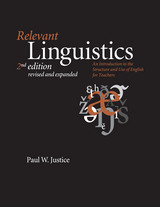 Relevant Linguistics, Second Edition, Revised and Expanded: An Introduction to the Structure and Use of English for Teachers
Paul W. Justice
CSLI, 2004 This revised and expanded edition of Paul W. Justice's popular text provides a straightforward, accessible introduction to the basics of linguistics for education students and all non-linguistics majors, covering the essentials of phonetics, phonology, morphology, morpho-phonology, and syntax. While this overview is accessible to any student, Justice's text will be of particular use in teacher training programs, many of which now expose trainees to these topics in order to cope with rising linguistic diversity in classrooms.
Each chapter of Relevant Linguistics leads students through descriptive analysis, helps them grasp linguistic concepts, and provides them with the reference materials necessary for their own teaching. This second edition contains more exercises as well as expanded and clarified explanations of the issues discussed in the first edition. Also included are more references to areas such as the history of English and semantics.
Reliability of Power Electronic Converter Systems
Henry Shu-hung Chung
The Institution of Engineering and Technology, 2016 The main aims of power electronic converter systems (PECS) are to control, convert, and condition electrical power flow from one form to another through the use of solid state electronics. This book outlines current research into the scientific modeling, experimentation, and remedial measures for advancing the reliability, availability, system robustness, and maintainability of PECS at different levels of complexity.
Reliability of Power Electronic Converter Systems
Henry Shu-Hung Chung
The Institution of Engineering and Technology, 2025 The reliability of power electronic systems is a major concern because these systems are exposed to harsh environments, high stresses, and variable loads caused by the increasing proliferation of renewable power generation.
Reliability of Power Electronics Converters for Solar Photovoltaic Applications
Ahteshamul Haque
The Institution of Engineering and Technology, 2021 The importance of power electronic converters for electricity grid equipment is increasing due to the growing distribution-level penetration of renewable energy sources. The performance of the converters mostly depends on interactions between sources, loads, and their state of operation. These devices must be operated with safety and stability under normal conditions, fault conditions, overloads, as well as different operation modes. Therefore, enhanced control strategies of power electronic converters are necessary to improve system stability.
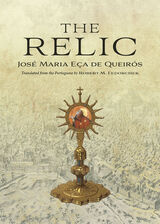 The Relic
Jose Maria Eca de Queiros
Catholic University of America Press, 2023 The Relic tells the story of an orphaned young man, Teodorico Raposo, who is brought to Lisbon from a provincial town in Portugal to live with his aunt, a rigid, stern—and oftentimes—forbidding Catholic. Her devout circle of acquaintances is made up almost entirely of priests, many of whom are more concerned with appearances than spirituality, and seeking her and their approval, Teodorico is driven to attend Mass, say rosaries, and frequent churches, all the while awakening to sensuality, women, and the material life in conflict with “Auntie’s” devotions, which are—inwardly—devoid of the charity preached by Christ.
When Teodorico obtains a degree from the University of Coimbra, Auntie sends him to the Holy Land to search for a relic to cure her ills. He meets up with a learned German author and, after a sojourn to Egypt, the two make their way to the land trod by Jesus. It is there that Teodorico has the dream that takes up nearly one third of the novel: he witnesses the travails that lead to the Passion and Crucifixion, as well as the aftermath of Christ’s death.
Faced now with his mission, Teodorico embarks on a search. He soon comes upon an item, a “true” relic authenticated by his German friend, the sanctity of which will send Auntie to the heights of spiritual bliss, so much so that she will make him her heir. But when Teodorico returns to Lisbon with it, deception awaits her as the result of a simple mistake that had been made, and disinheritance awaits him as a result of Auntie’s anger and vindictiveness.
The Relic: A Novel
José Maria De Eça De Queirós
Tagus Press, 2012 The Relic is an irreverent fictional autobiography narrating the picaresque adventures of Teodorico, a Portuguese playboy determined to be the sole heir of his absurdly pious, sexually repressed, and tyrannical Auntie. Sent to the Holy Land, he returns with what he presumes is the "relic of relics" in hopes of persuading Auntie to bequeath her vast fortune to him. While in Jerusalem, Teodorico has a vision in which he witnesses Christ’s trial and crucifixion and the founding of Christianity—with a twist.
 Relics, Apocalypse, and the Deceits of History: Ademar of Chabannes, 989–1034
Richard Landes
Harvard University Press, 1995 This unusual biographical work traces the life and career of Ademar of Chabannes, a monk, historian, liturgist, and hagiographer who lived at the turn of the first Christian millennium. Thanks to the unique collection of over one thousand folios of autograph manuscript that Ademar left behind, Richard Landes has been able to reconstruct in great detail the development of Ademar's career and the events of his day, and to suggest several major revisions in the general picture held by current medieval historiography.
Above all, the author's research confirms and elaborates the realization (first articulated over sixty years ago by the historian Louis Saltet) that in 1029 Ademar suffered a humiliating defeat at the height of his career and spent his final five years feverishly producing a dossier of forgeries and fictions about his own contemporaries that has few parallels in the annals on medieval forgery. Not only did that dossier of forgeries succeed in misleading historians from the twelfth century right up to the twentieth, but few historians have been willing to explore the implications of so striking a revision in Ademar's biography. Richard Landes is the first to systematically examine the evidence and the implications for our understanding of the period, and he offers an explanation of how these remarkable developments might have occurred.
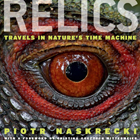 Relics: Travels in Nature's Time Machine
Piotr Naskrecki
University of Chicago Press, 2011 On any night in early June, if you stand on the right beaches of America’s East Coast, you can travel back in time all the way to the Jurassic. For as you watch, thousands of horseshoe crabs will emerge from the foam and scuttle up the beach to their spawning grounds, as they’ve done, nearly unchanged, for more than 440 million years.
Horseshoe crabs are far from the only contemporary manifestation of Earth’s distant past, and in Relics, world-renowned zoologist and photographer Piotr Naskrecki leads readers on an unbelievable journey through those lingering traces of a lost world. With camera in hand, he travels the globe to create a words-and-pictures portrait of our planet like no other, a time-lapse tour that renders Earth’s colossal age comprehensible, visible in creatures and habitats that have persisted, nearly untouched, for hundreds of millions of years.
Naskrecki begins by defining the concept of a relic—a creature or habitat that, while acted upon by evolution, remains remarkably similar to its earliest manifestations in the fossil record. Then he pulls back the Cambrian curtain to reveal relic after eye-popping relic: katydids, ancient reptiles, horsetail ferns, majestic magnolias, and more, all depicted through stunning photographs and first-person accounts of Naskrecki’s time studying them and watching their interactions in their natural habitats. Then he turns to the habitats themselves, traveling to such remote locations as the Atewa Plateau of Africa, the highlands of Papua New Guinea, and the lush forests of the Guyana Shield of South America—a group of relatively untrammeled ecosystems that are the current end point of staggeringly long, uninterrupted histories that have made them our best entryway to understanding what the prehuman world looked, felt, sounded, and even smelled like.
The stories and images of Earth’s past assembled in Relics are beautiful, breathtaking, and unmooring, plunging the reader into the hitherto incomprehensible reaches of deep time. We emerge changed, astonished by the unbroken skein of life on Earth and attentive to the hidden heritage of our planet’s past that surrounds us.
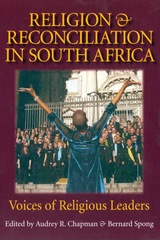 Religion & Reconciliation in South Africa: Voices of Religious Leaders
Bernard Spong
Templeton Press, 2003 Postapartheid South Africa's efforts to come to terms with its past, particularly its Truth and Reconciliation Commission's emphasis on forgiveness and reconciliation, is of special interest to many in the world community. The Truth and Reconciliation Commission (TRC), led by Archbishop Desmond Tutu, was mandated to go beyond truth-finding and to "promote national unity and reconciliation in a spirit of understanding which transcends the conflict and divisions of the past." In contrast with other truth commissions, the TRC was led by clerics rather than lawyers and judge, and the TRC's approach to reconciliation was shaped by and imbued with religious content. The TRC submitted its final report to the Mandela administration in October 1998. Over the next two years, the Rev. Bernard Spong, former communications director of the South African Council of Churches, conducted a series of in-depth interviews about the TRC with thirty-three key religious figures. In this volume, they discuss and evaluate the following issues: •How should we understand the concept of national or political reconciliation and its requirements? •What are the differences and similarities between religious and political approaches to reconciliation? •Does national or political reconciliation require forgiveness between former victims and perpetrators? •What is the appropriate role of religious representatives in a truth commission process? And is it recommended that other countries emulate the South African model? •How do religious leaders assess the contributions and limitations of the TRC? •What kind of initiatives are contemporary religious communities taking to promote reconciliation among their members and in the wider society? The conversations presented in this volume, and the essays interpreting them, seek to illuminate issues and questions raised by the TRC model, including how to conceptualize reconciliation and the differences between political and religious approaches.
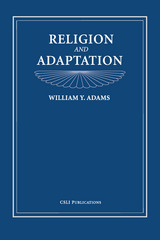 Religion and Adaptation
William Adams
CSLI, 2004 Throughout history, religion has been the primary tool used by human societies to understand the inexplicable and the powerful. Religion and Adaptation examines how this role of religion affects the development of human society and individual identity.
The volume uses a wide variety of ethnographic and historical sources to support its analysis, beginning with two detailed case studies of the religions practiced by Navajo Indians and Arab villagers. An intriguing comparison of these two systems of faith reveals the difficulty of finding one definition of religion. William Adams explores this problem of definition, suggesting that religion and science actually share the role of providing logical explanations in human society. In subsequent chapters, he considers the development of religious systems, the growth of religious consciousness in the individual, and the dynamics of religious change. The book ultimately aims to be a purely empirical study that probes the reasons for the existence of religion and its role as a moral and stabilizing force in human societies.
Religion and Culture
Christopher Dawson
Catholic University of America Press, 2013 Religion and Culture was first presented by historian Christopher Dawson as part of the prestigious Gifford Lecture series in 1947. It sets out the thesis for which he became famous: religion is the key of history
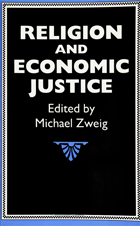 Religion and Economic Justice
edited by Michael Zweig
Temple University Press, 1992 As Eastern European economies move to capitalism, many people there hope for a better life. But capitalism is no guarantee of prosperity. Economic deprivation, war, social marginalization, and powerlessness mark the lives of millions and spark social movements for economic justice aimed at correcting these conditions. Often these movements are based in religious communities, their activists motivated by religious commitment to human dignity and the need for personal empowerment. Although the new theology contains an economic critique, little dialogue has taken place between the religious and economic communities on matters of economic analysis. Religion and Economic Justice seeks to develop this exchange. This book contains original essays by distinguished contributors from economics, religious ethics, and biblical studies. The authors provide a powerful critique of the individualism which underlies mainstream economic analysis and which fragments our communities, a critique that extends to the values implicit in the market system. The authors also show how social marginalization and economic deprivation are the consequences of economic organization, not simply the failings of individuals.
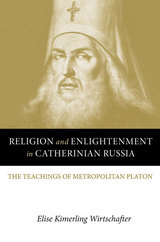 Religion and Enlightenment in Catherinian Russia: The Teachings of Metropolitan Platon
Elise Wirtschafter
Northern Illinois University Press, 2013 This valuable study explores the Russian Enlightenment with reference to the religious Enlightenment of the mid to late eighteenth century. Grounded in close reading of the sermons and devotional writings of Platon (Levshin), Court preacher and Metropolitan of Moscow, the book examines the blending of European ideas into the teachings of Russian Orthodoxy. Highlighting the interplay between Enlightenment thought and Orthodox enlightenment, Elise Wirtschafter addresses key questions of concern to religious Enlighteners across Europe: humanity’s relationship to God and creation, the distinction between learning and enlightenment, the role of Christian love in authority relationships, the meaning of free will in a universe governed by Divine Providence, and the unity of church, monarchy, and civil society. Countering scholarship that depicts an Orthodox religious culture under assault from European modernity and Petrine absolutism, Wirtschafter emphasizes the ability of Russia’s educated churchmen to assimilate and transform Enlightenment ideas. The intellectual and spiritual vitality of eighteenth-century Orthodoxy helps to explain how Russian policymakers and intellectuals met the challenge of European power while simultaneously coming to terms with the broad cultural appeal of the Enlightenment’s universalistic human rights agenda.
Religion and Enlightenment in Catherinian Russia defines the Russian Enlightenment as a response to the allure of European modernity, as an instrument of social control, and as the moral voice of an emergent independent society. Because Russia’s enlightened intellectuals focused on the moral perfectibility of the individual human being, rather than social and political change, the originality of the Russian Enlightenment has gone unrecognized. This study corrects images of a superficial Enlightenment and crisis-ridden religious culture, arguing that in order to understand the humanistic sensibility and emphasis on individual dignity that permeate Russian intellectual history, and the history of the educated classes more broadly, it is necessary to bring Orthodox teachings into the discussion of Enlightenment thought. The result is a book that explains the distinctive origins of modern Russian culture while also allowing scholars to situate the Russian Enlightenment in European and global history.
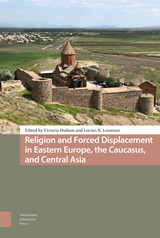 Religion and Forced Displacement in Eastern Europe, the Caucasus, and Central Asia
Victoria Hudson
Amsterdam University Press, 2022 This book examines the social and political mobilisation of religious communities towards forced displacement in relation to tolerance and transitory environments. How do religious actors and state bodies engage with refugees and migrants? What are the mechanisms of religious support towards forcibly displaced communities? Religion and Forced Displacement in Eastern Europe, the Caucasus, and Central Asia argues that when states do not act as providers of human security, religious communities, as representatives of civil society and often closer to the grass roots level, can be well placed to serve populations in need. The book brings together scholars from across the region and provides a comprehensive overview of the ways in which religious communities tackle humanitarian crises in contemporary Armenia, Bulgaria, Greece, Georgia, Kazakhstan, Kyrgyzstan, Moldova, Poland, Russia, Serbia, Ukraine and Uzbekistan.
Religion and Its Other: Secular and Sacral Concepts and Practices in Interaction
Edited by Heike Bock, Jörg Feuchter, and Michi Knecht
Campus Verlag, 2008 Modern Western thought has traditionally relegated the religious and the secular to two entirely different spheres. Religion and Its Other takes issue with this oversimplified dichotomy, tracing the borders and grey areas between religion and the secular world as conceived of in Christian, Jewish, and Muslim cultures past and present.
A unique collection of theoretically informed historical and anthropological case studies, this comprehensive volume includes discussions of medieval atheism, Egyptian modernization, Jewish mysticism, Lutheran angels, and other such topics. Religion and Its Other will enrich the library of anyone interested in the social construction of religion across the centuries.
Religion and Jewish Identity in the Soviet Union, 1941–1964
Mordechai Altshuler
Brandeis University Press, 2012 This illuminating study explores the role of religious institutions in the makeup of Jewish identity in the former Soviet Union, against the backdrop of the government’s antireligion policies from the 1940s to the 1960s. Foregrounding instances of Jewish public and private activities centered on synagogues and prayer groups—paradoxically the only Jewish institutions sanctioned by the government—Altshuler dispels the commonly held perception of Soviet Jewry as “The Jews of Silence” and reveals the earliest stirrings of Jewish national sentiment that anticipated the liberation movement of the 1960s and 1970s.
Religion and Nationalism in Chinese Societies
Edited by Cheng-tian Kuo
Amsterdam University Press, 2017 This book explores the interaction between religion and nationalism in the Chinese societies of mainland China, Taiwan, and Hong Kong. Cheng-tian Kuo analyses the dominant religions, including Chinese Buddhism, Tibetan Buddhism, Daoism, Christianity, Islam, and folk religions, but he also goes beyond that, showing how in recent decades the Chinese state has tightened its control over religion to an unprecedented degree. Indeed, it could almost be said to have constructed a wholly new religion, Chinese Patriotism. The same period, however, has seen the growth of democratic civil religions, which could challenge the state.
 Religion and Nationalism in Iraq: A Comparative Perspective
David Little
Harvard University Press, 2006 Because the situation in Iraq exhibits some of the standard symptoms of religious nationalism, it seems appropriate to compare it to other cases where the impulses of religion and nationalism have also come together in a highly lethal way. This volume provides a comparative consideration of attempts to manage and resolve nationalist conflicts in Bosnia, Sri Lanka, and Sudan, and examines how lessons from those situations might inform similar efforts in Iraq. In their introduction, Professors Little and Swearer review current scholarly thinking on the connection of religious and ethnic factors to nationalist conflicts, and they demonstrate the salience of religious and ethnic identity to these conflicts. For each country, two prominent thinkers examine the intersection of religion and ethnicity and the struggles to form a nation-state. The volume also contains a summary of the discussion on each country among 20 scholars, appendices providing background on the three countries with which Iraq is compared, and maps of the countries. The central role of ethnic and religious impulses in forming the identity of a people or "nation" directly ties these matters to nationalism and nationalist conflict.
Religion and Nationalism in Soviet and East European Politics
Pedro Ramet, ed.
Duke University Press, 1988 Religious organizations in many countries of the communist world have served as agents for the preservation, defense, and reinforcement of nationalist feelings, and in playing this role have frequently been a source of frustration to the Communist Party elites. Although the relationship between governments and religious groups varies according to the particular country and group in question, the mosaic of these relationships constitutes a revealing picture of the political reform shaping the lives of Soviet and East European citizens.
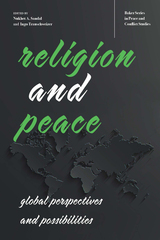 Religion and Peace: Global Perspectives and Possibilities
Nukhet A. Sandal
Ohio University Press, 2022 Can religion help societies achieve peace and stability? What actions can religious leaders take to facilitate conflict resolution? This book addresses these critical questions in terms of numerous contemporary conflicts within and between countries. In the aftermath of the 9/11 attacks, public attention to religion shifted away from its relationship to politics and toward its connection to violence in civil conflicts, wars, and terrorism. Religion’s role in sowing discord became more prominent than its ability to unify. Only recently have discussions turned toward the positive impact of religion and spirituality in the public sphere and to the role of faith in resolving diplomatic, political, and social problems. The essays in this book contribute to this discourse by examining past, present, and future opportunities to promote peace through religion and spirituality. The contributors to this volume explore topics such as humanitarianism, philosophy, counterextremism, human rights, rituals, populism, foreign policy, and environmentalism. Some of the chapters approach these topics from a transnational perspective, while others focus on specific countries in Africa, Asia, Europe, Latin America, and the Middle East. Contributors: - Jonathan C. Agensky
- Slavica Jakelić
- Afra Jalabi
- Brandon Kendhammer
- Loren D. Lybarger
- Cecelia Lynch
- Peter Mandaville
- Jeremy Rinker
- Margaret M. Scull
- Amy Erica Smith
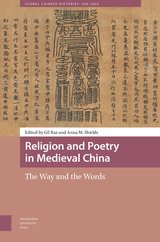 Religion and Poetry in Medieval China: The Way and the Words
Gil Raz
Amsterdam University Press, 2024 This volume of interdisciplinary essays examines the intersection of religion and literature in medieval China, focusing on the impact of Buddhism and Daoism on a wide range of elite and popular literary texts and religious practices in the 3rd-11th centuries CE. Drawing on the work of the interdisciplinary scholar Stephen Bokenkamp, the essays weave together the many cross-currents of religious, intellectual, and literary traditions in medieval China to provide vivid pictures of medieval Chinese religion and culture as it was lived and practiced. The contributors to the volume are all highly regarded experts in the fields of Chinese poetry, Daoism, Buddhism, popular religion, and literature. Their research papers cut across imagined disciplinary boundaries to show that the culture of medieval China can only be understood by close reading of texts from multiple genres, traditions, and approaches.
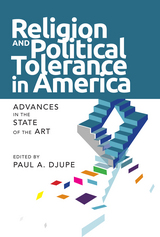 Religion and Political Tolerance in America: Advances in the State of the Art
Paul Djupe
Temple University Press, 2015 Religious institutions are often engaged in influencing the beliefs and values that individuals hold. But religious groups can also challenge how people think about democracy, including the extension of equal rights and liberties regardless of viewpoint, or what is commonly called political tolerance.
The essays in Religion and Political Tolerance in America seek to understand how these elements interrelate. The editor and contributors to this important volume present new and innovative research that wrestles with the fundamental question of the place of religion in democratic society. They address topics ranging from religious contributions to social identity to the political tolerance that religious elites (clergy) hold and advocate to others, and how religion shapes responses to intolerance.
The conclusion, by Ted Jelen, emphasizes that religion’s take on political tolerance is nuanced and that they are not incompatible; religion can sometimes enhance the tolerance of ordinary citizens.
Religion and Politics in East Africa: The Period since Independence
Hölger Bernt Hansen
Ohio University Press, 1994 Religious activities have been of continuing importance in the rise of protest against postcolonial governments in Eastern Africa. Governments have attempted to “manage“ religious affairs in both Muslim and Christian areas. Religious denominations have acted as advocates of human rights and in opposition to one-party-state regimes. Islamic fundamentalism changed with the ending of the Cold War. The book is divided into four parts: The Challenge of Islam; Christianity, Sectarianism, and Politics in Uganda; Christians and Muslim in Kenyan Politics; and Cross-cultural Complications. An introductory essay by Michael Twaddle provides and overview of the changing character of politico-religious conflict in Eastern Africa. Holger Bernt Hansen summarizes the presentation with a discussion of dilemmas and challenges in the study of religion and politics.
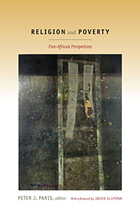 Religion and Poverty: Pan-African Perspectives
Peter J. Paris, ed.
Duke University Press, 2009 A Ghanaian scholar of religion argues that poverty is a particularly complex subject in traditional African cultures, where holistic worldviews unite life’s material and spiritual dimensions. A South African ethicist examines informal economies in Ghana, Jamaica, Kenya, and South Africa, looking at their ideological roots, social organization, and vulnerability to global capital. African American theologians offer ethnographic accounts of empowering religious rituals performed in churches in the United States, Jamaica, and South Africa. This important collection brings together these and other Pan-African perspectives on religion and poverty in Africa and the African diaspora. Contributors from Africa and North America explore poverty’s roots and effects, the ways that experiences and understandings of deprivation are shaped by religion, and the capacity and limitations of religion as a means of alleviating poverty. As part of a collaborative project, the contributors visited Ghana, Kenya, and South Africa, as well as Jamaica and the United States. In each location, they met with clergy, scholars, government representatives, and NGO workers, and they examined how religious groups and community organizations address poverty. Their essays complement one another. Some focus on poverty, some on religion, others on their intersection, and still others on social change. A Jamaican scholar of gender studies decries the feminization of poverty, while a Nigerian ethicist and lawyer argues that the protection of human rights must factor into efforts to overcome poverty. A church historian from Togo examines the idea of poverty as a moral virtue and its repercussions in Africa, and a Tanzanian theologian and priest analyzes ujamaa, an African philosophy of community and social change. Taken together, the volume’s essays create a discourse of mutual understanding across linguistic, religious, ethnic, and national boundaries. Contributors. Elizabeth Amoah, Kossi A. Ayedze, Barbara Bailey, Katie G. Cannon, Noel Erskine, Dwight N. Hopkins, Simeon O. Ilesanmi, Laurenti Magesa, Madipoane Masenya, Takatso A. Mofokeng, Esther M. Mombo, Nyambura J. Njoroge, Jacob Olupona, Peter J. Paris, Anthony B. Pinn, Linda E. Thomas, Lewin L. Williams
Religion and Race: Southern Presbyterians, 1946 to 1983
Joel L. Alvis Jr
University of Alabama Press, 1994 Joel Alvis focuses on the relationships and tensions in the Presbyterian Church, U.S., whose ecclesiastical boundaries never expanded significantly beyond its original territory in the Confederacy and border South. By the time of the civil rights movement, the church was actively involved in ecumenical activities despite its regional isolation, and that involvement created unease in some quarters of the denomination. This concise institutional history traces how the church shaped and was shaped by its regional culture and explores the denomination's own cultural struggle to determine what role race issues would play in the definition of being Presbyterian.
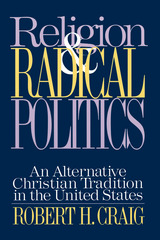 Religion and Radical Politics: An Alternative Christian Tradition in the United States
Robert Craig
Temple University Press, 1995 "This meticulously researched study....discusses a varied array of movements, organizations, and activists, many largely unstudied, who sought to aid the poor and oppressed through Christian social action....[This] thoughtful, lucid book will engage not only historians but also theologians, ethicists, political scientists, sociologists, indeed anyone interested in the convergence of religion and politics in the United States."
--Journal of American History
Robert Craig explores the history of American left-wing Christians who discovered the convergence between radical politics and Christian faith. He examines the life histories of individuals, movements, and organizations that encompass more than a century of American history and discusses the role of religious activism in movements of social transformation.
Craig describes the activists who participated in this (largely ignored) alternative tradition of social action on behalf of the poor. Among those included are Jesse H. Jones, Edward H. Rogers, the Christian Labor Union, and the Knights of labor, which represented workers; Frances Willard and Mother Jones, who worked to improve the status of women and working-class people; Reverdy Ransom, W.E.B. Du Bois, Hubert Harrison, and George Washington Woodbey, who wrestled with the relationship between race and class; Southern radicals, such as Howard Kester, Claude Williams, and the southern Tenant Farmers' Union, which struggled for radical equality; and those involved in the politics of nonviolence, such as Dorothy Day and A.J.. Muste.
"Religion and Radical Politics is a helpful analysis of several chapters in American a religious history....built around a series of biographical sketches that explore the lives of people such as Terence Powederly, Frances Willard, Mother Jones, George Washington Woodbey, Claude Williams, Howard Kester, Harry F. Ward, A.J. Juste, and Dorothy Day. ...[It] is a remarkably strong book."
--Journal of Church and State
"A major contribution to American history and to Christian ethics. It will be controversial in the best way, raising questions which are the right questions, at least right for those who care for a democracy of human rights, universal participation, and social justice."
--David J. O'Brien, College of the Holy Cross
Religion and Sexuality: The Shakers, the Mormons, and the Oneida Community
Lawrence Foster
University of Illinois Press, 2009 "Most writers have treated these three groups and the social ferment out of which they grew as simply an American sideshow. . . . In this book, therefore, I have attempted to go beyond the conventional focus on what these groups did; I have also sought to explain why they did what they did and how successful they were in terms of their own objectives. By trying sympathetically to understand these extraordinary experiments in social and religious revitalization, I believe it is possible to come to terms with a broader set of questions that affect all men and women during times of crisis and transition."--From the preface
Winner of the Best Book Award, Mormon History Association
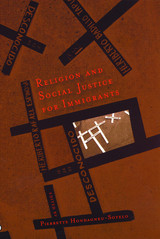 Religion and Social Justice For Immigrants
Hondagneu-Sotelo, Pierrette
Rutgers University Press, 2006 Religion has jumped into the sphere of global and domestic politics in ways that few would have imagined a century ago. Some expected that religion would die as modernity flourished. Instead, it now stares at us almost daily from the front pages of newspapers and television broadcasts. Although it is usually stories about the Christian Right or conservative Islam that grab headlines, there are many religious activists of other political persuasions that are working quietly for social justice. This book examines how religious immigrants and religious activists are working for equitable treatment for immigrants in the United States. The essays in this book analyze the different ways in which organized religion provides immigrants with an arena for mobilization, civic participation, and solidarity. Contributors explore topics including how non-Western religious groups such as the Vietnamese Caodai are striving for community recognition and addressing problems such as racism, economic issues, and the politics of diaspora; how interfaith groups organize religious people into immigrant civil rights activists at the U.S.–Mexican border; and how Catholic groups advocate governmental legislation and policies on behalf of refugees.
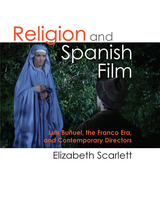 Religion and Spanish Film: Luis Buñuel, the Franco Era, and Contemporary Directors
Elizabeth Scarlett
University of Michigan Press, 2014 Treatments of religion found in Spanish cinema range from the pious to the anticlerical and atheistic, and every position in between. In a nation with a strong Catholic tradition, resistance to and rebellion against religious norms go back almost as far as the notion of “Sacred Spain.” Religion and Spanish Film provides a sustained study of the religious film genre in Spain practiced by mainstream Francoist film makers, the evolving iconoclasm, parody, and reinvention of the Catholic by internationally renowned Surrealist Luis Buñuel, and the ongoing battle of the secular versus the religious manifested in critically and popularly acclaimed directors Pedro Almodóvar, Julio Medem, Alejandro Amenábar, and many others. The conflicted Catholicism that emerges from examining religious themes in Spanish film history shows no sign of ending, as unresolved issues from the Civil War and Franco dictatorship, as well as the unsettled relationship between Church and State, continue into the present.
Religion and Spirituality in Korean America
Edited by David K. Yoo and Ruth H. Chung
University of Illinois Press, 2007 Religion and Spirituality in Korean America examines the ambivalent identities of predominantly Protestant Korean Americans in Judeo-Christian American culture. Focusing largely on the migration of Koreans to the United States since 1965, this interdisciplinary collection investigates campus faith groups and adoptees. The authors probe factors such as race, the concept of diaspora, and the ways the improvised creation of sacred spaces shape Korean American religious identity and experience. In calling attention to important trends in Korean American spirituality, the essays highlight a high rate of religious involvement in urban places and participation in a transnational religious community. Contributors: Ruth H. Chung, Jae Ran Kim, Jung Ha Kim, Rebecca Kim, Sharon Kim, Okyun Kwon, Sang Hyun Lee, Anselm Kyongsuk Min, Sharon A. Suh, Sung Hyun Um, and David K. Yoo
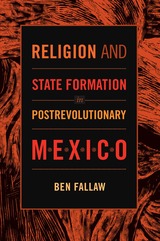 Religion and State Formation in Postrevolutionary Mexico
Ben Fallaw
Duke University Press, 2012 The religion question—the place of the Church in a Catholic country after an anticlerical revolution—profoundly shaped the process of state formation in Mexico. From the end of the Cristero War in 1929 until Manuel Ávila Camacho assumed the presidency in late 1940 and declared his faith, Mexico's unresolved religious conflict roiled regional politics, impeded federal schooling, undermined agrarian reform, and flared into sporadic violence, ultimately frustrating the secular vision shared by Plutarco Elías Calles and Lázaro Cárdenas. Ben Fallaw argues that previous scholarship has not appreciated the pervasive influence of Catholics and Catholicism on postrevolutionary state formation. By delving into the history of four understudied Mexican states, he is able to show that religion swayed regional politics not just in states such as Guanajuato, in Mexico's central-west "Rosary Belt," but even in those considered much less observant, including Campeche, Guerrero, and Hidalgo. Religion and State Formation in Postrevolutionary Mexico reshapes our understanding of agrarian reform, federal schooling, revolutionary anticlericalism, elections, the Segunda (a second Cristero War in the 1930s), and indigenism, the Revolution's valorization of the Mesoamerican past as the font of national identity.
 Religion and State in the American Jewish Experience
Jonathan D. Sarna
University of Notre Dame Press, 1997 For the first time, Religion and State in the American Jewish Experience makes available critical documents which have shaped debate over religion and state issues throughout the course of American Jewish history. Following a comprehensive historical introduction, Professors Sarna and Dalin present a wide range of primary source materials articulating the different positions held within the American Jewish community on numerous past and present church-state issues: including former state Sunday Laws, or "blue laws"; dress code variations for Orthodox Jews in the military; kosher food for Jewish prisoners; school prayer; public displays of religious symbols; and whether all religious symbols should be removed from public arenas.
The chapters proceed chronologically, from the colonial period to the present day, giving readers an understanding of the changes which have occured over several centuries.
This book recovers the divergent voices and opinions of the American Jewish community, revealing that one single voice on these issues has never been capable of accommodating the rich variety of positions within the community. By gathering these divergent outlooks in one sourcebook, Sarna and Dalin offer a unique and well-documented look at a major aspect of being Jewish in America.
Sarna and Dalin present primary source materials articulating different positions held within the American Jewish community on past and present church-state issues. Issues include: Sunday Laws, wearing yarmulkes in the military, Kosher food in prisons, prayer in public schools, and Christmas and Hannukah. Sarna and Dalin offer a unique and well-documented look at a major aspect of the experience of being Jewish in America.
----------
"Religion and State in the American Jewish Experience justifies itself as offering a fresh view on how American Jews have situated themselves on the emotional issues surrounding church-state relations in the United States." --Journal of Church and State
" . . . Sarna and Dalin have created a wonderful compendium of primary sources. With the boom in Jewish studies, a reader on the relationship between church and state is a most welcome addition to the literature and this book is exceptionally well-constructed. Suitable for upper-level courses, this anthology is recommended for students of history and philosophy as well as for those with an interest in political science." --Caryn E. Neumann, Ohio State University
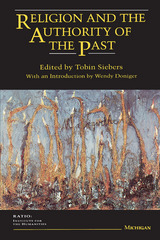 Religion and the Authority of the Past
Tobin Siebers, Editor
University of Michigan Press, 1993 Religion and the Authority of the Past looks at how the past has influenced religious authority, and demonstrates that authority has been, and continues to be, prevalent in all religions and cultures. This book shows, in a fascinating variety of ways, how religious doctrine, interpretation, behavior, and expression are affected by those in power. The contributors—distinguished scholars from the fields of history, religion, classics, art, and Asian studies—find authority not only in places where one might expect it—in Islamic doctrine, Hindu religious texts, and the dogma of the Roman Catholic church, for example—but also in unimagined and intriguing locations: in the first U.S. archaeological expedition to the ancient Near East; in representations of heroic action in the Homeric epics and early Chinese classics; in the transmission of religious stereotypes from the Old World to the New; in the poetry of Paul Celan and Dan Pagis; and in a sculptor's attempts to create art for houses of worship, where architects, bishops, priests, and the laity assert a variety of forms of religious authority of their own.
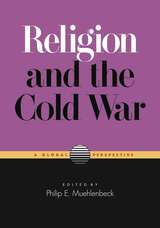 Religion and the Cold War: A Global Perspective
Philip E. Muehlenbeck
Vanderbilt University Press, 2012 The lines of armed conflict, and the catastrophic perils they portended, were shaped with shocking clarity in the immediate aftermath of World War II. Less clear is the role religious ideology played in the conflicts that defined the Cold War era. All too often, beliefs held sacred by some became tools to motivate action or create friction. In Religion and the Cold War, Philip Muehlenbeck assembles an international team of specialists to explore how religion informed the ideological and military clashes across the globe in the second half of the twentieth century.
Students and scholars will find in this volume a level of comprehensiveness rarely achieved in Cold War studies. Each chapter reveals that the power and influence of ideas are just as important as military might in the struggles between superpowersand that few ideas, then as now, carry as much force as religious ideology. As Muehlenbeck and his contributors demonstrate, no area of the world, and no religious tenet, was safe from the manipulations of a powerful set of players focused solely on their own sphere of influence.
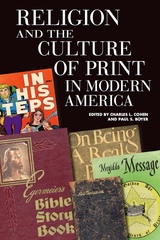 Religion and the Culture of Print in Modern America
Edited by Charles L. Cohen and Paul S. Boyer
University of Wisconsin Press, 2008 Mingling God and Mammon, piety and polemics, and prescriptions for this world and the next, modern Americans have created a culture of print that is vibrantly religious. From America’s beginnings, the printed word has played a central role in articulating, propagating, defending, critiquing, and sometimes attacking religious belief. In the last two centuries the United States has become both the leading producer and consumer of print and one of the most identifiably religious nations on earth. Print in every form has helped religious groups come to grips with modernity as they construct their identities. In turn, publishers have profited by swelling their lists with spiritual advice books and scriptures formatted so as to attract every conceivable niche market. Religion and the Culture of Print in Modern America explores how a variety of print media—religious tracts, newsletters, cartoons, pamphlets, self-help books, mass-market paperbacks, and editions of the Bible from the King James Version to contemporary “Bible-zines”—have shaped and been shaped by experiences of faith since the Civil War. Edited by Charles L. Cohen and Paul S. Boyer, whose comprehensive historical essays provide a broad overview to the topic, this book is the first on the history of religious print culture in modern America and a well-timed entry into the increasingly prominent contemporary debate over the role of religion in American public life. Best Books for General Audiences, selected by the American Association of School Librarians, and Best Books for Regional Special Interests, selected by the Public Library Association
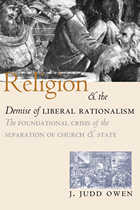 Religion and the Demise of Liberal Rationalism: The Foundational Crisis of the Separation of Church and State
J. Judd Owen
University of Chicago Press, 2001 If liberalism is premised on inclusion, pluralism, and religious neutrality, can the separation of church and state be said to have a unitary and rational foundation? If we accept that there are no self-evident principles of morality or politics, then doesn't any belief in a rational society become a sort of faith? And how can liberalism mediate impartially between various faiths—as it aims to do—if liberalism itself is one of the competing faiths?
J. Judd Owen answers these questions with a remarkable critical analysis of four twentieth-century liberal and postliberal thinkers: John Dewey, John Rawls and, most extensively, Richard Rorty and Stanley Fish. His unique readings of these theorists and their approaches to religion lead him to conclusions that are meticulously constructed and surprising, arguing against the perception of liberalism as simple moral or religious neutrality, calling into question the prevailing justifications for separation of church and state, and challenging the way we think about the very basis of constitutional government.
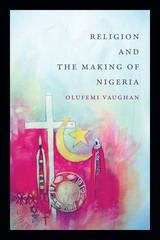 Religion and the Making of Nigeria
Olufemi Vaughan
Duke University Press, 2016 In Religion and the Making of Nigeria, Olufemi Vaughan examines how Christian, Muslim, and indigenous religious structures have provided the essential social and ideological frameworks for the construction of contemporary Nigeria. Using a wealth of archival sources and extensive Africanist scholarship, Vaughan traces Nigeria’s social, religious, and political history from the early nineteenth century to the present. During the nineteenth century, the historic Sokoto Jihad in today’s northern Nigeria and the Christian missionary movement in what is now southwestern Nigeria provided the frameworks for ethno-religious divisions in colonial society. Following Nigeria’s independence from Britain in 1960, Christian-Muslim tensions became manifest in regional and religious conflicts over the expansion of sharia, in fierce competition among political elites for state power, and in the rise of Boko Haram. These tensions are not simply conflicts over religious beliefs, ethnicity, and regionalism; they represent structural imbalances founded on the religious divisions forged under colonial rule.
Religion and the Politics of Time
Noah Shusterman
Catholic University of America Press, 2010 Religion and the Politics of Time is an extensive study of the changes in religious holidays in Old Regime and Revolutionary France.
 Religion and the Public Schools: Constitutional Mandates and Choices. The Historical Present
Paul A. Freund and Robert Ulich
Harvard University Press In “Constitutional Mandates and Choices,” Paul Freund discusses the recent Supreme Court school-prayer decisions and the Constitution. Acknowledging the need for instilling tradition, morality, and reverence—the “religious component” called for by many—Freund still maintains that “the school-prayer decisions are more important for the doors they leave open than for those they shut. The study of religious tradition, training in moral analysis, and the cultivation of sensibilities beyond the intellectual are all left open and beckoning… Today the need is not to reform the First Amendment but to examine and reform our ideas and practices of moral education in the schools.”
After presenting a brief historical description of religious education in our Western Judeo-Christian civilization, and outlining the present situation in our public schools, Robert Ulich, in “The Historical Present,” declares that if by “religion” we do not mean allegiance to a particular creed, then, “whatever is the decision of the Supreme Court, it will never be able to divorce the religious from the educational spheres in our education system.”
 Religion and the Rise of Modern Culture
Louis Dupre
University of Notre Dame Press, 2008
Religion and the Rise of Modern Culture describes and analyzes changing attitudes toward religion during three stages of modern European culture: the Renaissance, the Enlightenment, and the Romantic period. Louis Dupré is an expert guide to the complex historical and intellectual relation between religion and modern culture.
Dupré begins by tracing the weakening of the Christian synthesis. At the end of the Middle Ages intellectual attitudes toward religion began to change. Theology, once the dominant science that had integrated all others, lost its commanding position. After the French Revolution, religion once again played a role in intellectual life, but not as the dominant force. Religion became transformed by intellectual and moral principles conceived independently of faith. Dupré explores this new situation in three areas: the literature of Romanticism (illustrated by Goethe, Schiller, and Hölderlin); idealist philosophy (Schelling); and theology itself (Schleiermacher and Kierkegaard). Dupré argues that contemporary religion has not yet met the challenge presented by Romantic thought.
“This beautifully crafted essay by Louis Dupré makes an original contribution to our understanding of the emergence and development of modernity, which dispensing with religion as a governing discourse and form of life, nonetheless attempts to find a place for it in a world sufficiently depleted of meaning and value as to require reenchantment. It supplements Dupré’s two magisterial texts on the topic of the modernity covering the Renaissance and Enlightenment periods, and whets the appetite for the forthcoming volume on Romanticism. Deep learning is worn lightly in this marvelously readable book.” —Cyril O'Regan, University of Notre Dame
“A stunning synthesis of Dupré's magisterial intellectual history of modernity and his distinctive and important philosophy of religion.” —David Tracy, emeritus, The University of Chicago Divinity School
“Louis Dupre's literate and sweeping review of the fate of religious faith in modern culture will help contemporary readers, who share his closing yearning for ways in which ‘transcendence can be recognized again,’ to appreciate why many of us find a postmodern climate—for better or worse—more conducive to fulfilling that desire. For his dramatic depictions of modernity teach us how different is the culture in which we now live.” —David Burrell, CSC, Hesburgh Professor Emeritus in Philosophy and Theology, University of Notre Dame
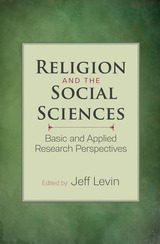 Religion and the Social Sciences: Basic and Applied Research Perspectives
Jeff Levin
Templeton Press, 2018 In recent years, researchers across the social sciences have made important contributions to the study of religion. Thanks to their inquiry, we have greatly improved our understanding of how religion influences the vital dimensions of our lives, communities, and institutions. To give this research the attention it deserves, editor Jeff Levin assembled a panel of preeminent social scientists and gave them a single directive: write the ultimate statement on religion from within their respective social science discipline or field. The result is this single volume, “state-of-the-science” compendium—a first of its kind for the study of religion. Composed of ten essays, this book details the study of religion within nine basic and applied areas of social science. Along with a critical introduction to this subject, these essays include the expert contributions of: - Kenneth I. Pargament & Julie J. Exline on psychology
- Anthony Gill on political science
- Charles M. North on economics
- Barry Hankins on history
- Annette Mahoney on family studies
- Byron R. Johnson on criminology
- Linda K. George on gerontology
- William H. Jeynes on education
- Jeff Levin on epidemiology
Each essay features: - An introduction to the history of the discipline’s or field’s religious research, as well as its most important people and published works.
- A comprehensive overview of key research findings and theories.
- A detailed research agenda to guide future scholars.
- An annotated bibliography of seminal works for the reader’s further consideration.
Broad in scope and essential in focus, Religion and the Social Sciences is a significant addition to the field. It will prove indispensable to both new and established scholars looking for a comprehensive treatment of the subject and seeking promising avenues to pursue in their own research.
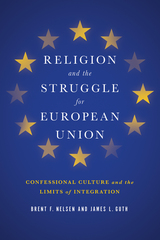 Religion and the Struggle for European Union: Confessional Culture and the Limits of Integration
Brent F. Nelsen and James L. Guth
Georgetown University Press, 2015 In Religion and the Struggle for European Union, Brent F. Nelsen and James L. Guth delve into the powerful role of religion in shaping European attitudes on politics, political integration, and the national and continental identities of its leaders and citizens. Nelsen and Guth contend that for centuries Catholicism promoted the universality of the Church and the essential unity of Christendom. Protestantism, by contrast, esteemed particularity and feared Catholic dominance. These differing visions of Europe have influenced the process of postwar integration in profound ways. Nelsen and Guth compare the Catholic view of Europe as a single cultural entity best governed as a unified polity against traditional Protestant estrangement from continental culture and its preference for pragmatic cooperation over the sacrifice of sovereignty. As the authors show, this deep cultural divide, rooted in the struggles of the Reformation, resists the ongoing secularization of the continent. Unless addressed, it threatens decades of hard-won gains in security and prosperity. Farsighted and rich with data, Religion and the Struggle for European Union offers a pragmatic way forward in the EU's attempts to solve its social, economic, and political crises.
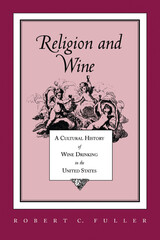 Religion and Wine: A Cultural History of Wine Drinking in the United States
Robert C. Fuller
University of Tennessee Press, 1996 Wine, more than any other food or beverage, is intimately associated with religious experience and celebratory rituals. Nowhere is this seen more clearly than in American cultural history. From the Pilgrims at Plymouth Rock to the Franciscans and Jesuits who pioneered California's Mission Trail, many American religious groups have required wine to perform their sacraments and enliven their evening meals. This book tells the story of how viniculture in America was started and sustained by a broad spectrum of religious denominations. In the process, it offers new insights into the special relationship between wine production and consumption and the spiritual dimension of human experience. Robert Fuller's historical narrative encompasses a fascinating array of groups and individuals, and the author makes some provocative connections between the love of wine and the particularities of religious experience. For example, he speculates on the ways in which Thomas Jefferson's celebrated knowledge of wine related to his cultural sophistication and free-thinking outlook on matters of religion and spirituality. Elsewhere he describes how a number of nineteenth-century communal groups-including the Rappites, the Amana colonies, the Mormons, and the spiritualist colony called the Brotherhood of the New Life helped to spread the religious use of wine across a vast new nation. Fuller describes and analyzes the role of wine drinking in promoting community solidarity and facilitating a variety of religious experiences, ranging from the warm glow of ritualized camaraderie to the ecstasy of immediate contact with otherwise hidden spiritual realms. He also devotes a chapter to the rise of temperance and prohibitionist sentiments among fundamentalist Christians and their subsequent attack on wine drinking. The book's concluding chapter features an insightful analysis of the ritual dimensions of contemporary wine drinking and wine culture. According to Fuller, the aesthetic experiences and communal affirmation that some religious groups have historically associated with the enjoyment of wine have passed into the practice of popular-or "unchurched"-religion in the United States.
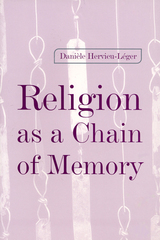 Religion as a Chain of Memory
Daniele Hervieu-Leger
Rutgers University Press, 2000 For most of the last twenty years, sociologists have studied the “decline” of religion in the modern world—a decline they saw as a defining feature of modernity, which promotes materialism over spirituality. The revival and political strength of varying religious traditions around the world, however, has forced sociologists to reconsider. This paradox has led Hervieu-Léger to undertake a sociological redefinition and reexamination of religion. For religion to endure in the modern world, she finds, it must have deep roots in traditions and times in which it was not defined as irrelevant. This reasoning leads her to develop the concept of a “chain of memory”—a process by which individual believers become members of a community that links past, present, and future members. Thus, like cultural tradition, religion may be understood as a shared understanding with a collective memory that enables it to draw upon the deep well of its past for nourishment in the increasingly secular present.
Hervieu-Legér also argues that the modern secular societies of the West have not, as is commonly assumed, outgrown or found secular substitutes for religious traditions; nor are they more “rational” than past societies. Rather, modern societies have become “amnesiacs,” no longer able to maintain the chain of memory that binds them to their religious pasts. Ironically, however, even as the modern world is destroying and losing touch with its traditional religious bases, it is also creating the need for a spiritual life and is thus opening up a space that only religion can fill.
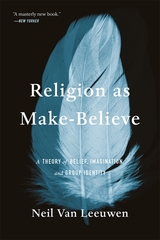 Religion as Make-Believe: A Theory of Belief, Imagination, and Group Identity
Neil Van Leeuwen
Harvard University Press, 2023 To understand the nature of religious belief, we must look at how our minds process the world of imagination and make-believe.
We often assume that religious beliefs are no different in kind from ordinary factual beliefs—that believing in the existence of God or of supernatural entities that hear our prayers is akin to believing that May comes before June. Neil Van Leeuwen shows that, in fact, these two forms of belief are strikingly different. Our brains do not process religious beliefs like they do beliefs concerning mundane reality; instead, empirical findings show that religious beliefs function like the imaginings that guide make-believe play.
Van Leeuwen argues that religious belief—which he terms religious “credence”—is best understood as a form of imagination that people use to define the identity of their group and express the values they hold sacred. When a person pretends, they navigate the world by consulting two maps: the first represents mundane reality, and the second superimposes the features of the imagined world atop the first. Drawing on psychological, linguistic, and anthropological evidence, Van Leeuwen posits that religious communities operate in much the same way, consulting a factual-belief map that represents ordinary objects and events and a religious-credence map that accords these objects and events imagined sacred and supernatural significance.
It is hardly controversial to suggest that religion has a social function, but Religion as Make-Believe breaks new ground by theorizing the underlying cognitive mechanisms. Once we recognize that our minds process factual and religious beliefs in fundamentally different ways, we can gain deeper understanding of the complex individual and group psychology of religious faith.
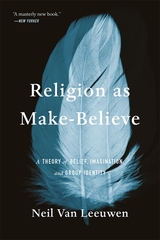 Religion as Make-Believe: A Theory of Belief, Imagination, and Group Identity
Neil Van Leeuwen
Harvard University Press “A masterly new book.” —New Yorker
“A major achievement in the study of religious attitudes.” —Notre Dame Philosophical Reviews
To understand the nature of religious belief, we must look at how our minds process the world of imagination and make-believe.
We often assume that religious beliefs are similar in kind to ordinary factual beliefs—that believing in the existence of supernatural entities that hear our prayers is akin to believing that May comes before June. Neil Van Leeuwen reveals that, in fact, these two forms of belief are strikingly different. Empirical findings show that religious beliefs function not like beliefs concerning mundane reality but like the imaginings that guide make-believe play.
When a person pretends, they navigate the world by consulting two maps: the first represents mundane reality, and the second superimposes features of the imagined world atop the first. Drawing on psychological, linguistic, and anthropological evidence, Van Leeuwen posits that religious communities operate in just this way, consulting a factual belief map that represents ordinary objects and events, as well as a religious credence map. The latter accords everyday objects and events an imagined supernatural significance that defines a community’s identity and expresses its sacred values.
It is hardly controversial to suggest that religion has a social function, but Religion as Make-Believe breaks new ground by theorizing the underlying cognitive mechanisms and deepening our understanding of the individual and group psychology of faith.
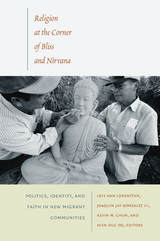 Religion at the Corner of Bliss and Nirvana: Politics, Identity, and Faith in New Migrant Communities
Lois Ann Lorentzen, Joaquin Jay Gonzalez III, Kevin M. Chun and Hien Duc Do, eds.
Duke University Press, 2009 Based on ethnographic research by an interdisciplinary team of scholars and activists, Religion at the Corner of Bliss and Nirvana illuminates the role that religion plays in the civic and political experiences of new migrants in the United States. By bringing innovative questions and theoretical frameworks to bear on the experiences of Chinese, Filipino, Mexican, Salvadoran, and Vietnamese migrants, the contributors demonstrate how groups and individuals negotiate multiple religious, cultural, and national identities, and how religious faiths are transformed through migration. Taken together, their essays show that migrants’ religious lives are much more than replications of home in a new land. They reflect a process of adaptation to new physical and cultural environments, and an ongoing synthesis of cultural elements from the migrants’ countries of origin and the United States. As they conducted research, the contributors not only visited churches and temples but also single-room-occupancy hotels, brothels, tattoo-removal clinics, and the streets of San Francisco, El Salvador, Mexico, and Vietnam. Their essays include an exploration of how faith-based organizations can help LGBT migrants surmount legal and social complexities, an examination of transgendered sex workers’ relationship with the unofficial saint Santisima Muerte, a comparison of how a Presbyterian mission and a Buddhist temple in San Francisco help Chinese immigrants to acculturate, and an analysis of the transformation of baptismal rites performed by Mayan migrants. The voices of gang members, Chinese and Vietnamese Buddhist nuns, members of Pentecostal churches, and many others animate this collection. In the process of giving voice to these communities, the contributors interrogate theories about acculturation, class, political and social capital, gender and sexuality, the sociology of religion, transnationalism, and globalization. The collection includes twenty-one photographs by Jerry Berndt. Contributors. Luis Enrique Bazan, Kevin M. Chun, Hien Duc Do, Patricia Fortuny Loret de Mola, Joaquin Jay Gonzalez III, Sarah Horton, Cymene Howe, Mimi Khúc, Jonathan H. X. Lee, Lois Ann Lorentzen, Andrea Maison, Dennis Marzan, Rosalina Mira, Claudine del Rosario, Susanna Zaraysky
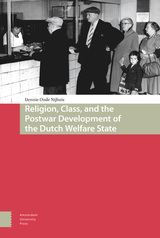 Religion, Class, and the Postwar Development of the Dutch Welfare State
Dennie Oude Nijhuis
Amsterdam University Press, 2018 This book examines how the Netherlands managed to create and maintain one of the world’s most generous and inclusive welfare systems despite having been dominated by Christian-democratic or ŸconservativeŒ, rather than socialist dominated governments, for most of the post-war period. It emphasizes that such systems have strong consequences for the distribution of income and risk among different segments of society and argues that they could consequently only emerge in countries where middle class groups were unable to utilize their key electoral and strong labor market position to mobilize against the adverse consequences of redistribution for them. By illustrating their key role in the coming about of solidaristic welfare reform in the Netherlands, the book also offers a novel view of the roles of Christian-democracy and the labor union movement in the development of modern welfare states. By highlighting how welfare reform contributed to the employment miracle of the 1990s, the book sheds new light on how countries are able to combine high levels of welfare generosity and solidarity with successful macro-economic performance.
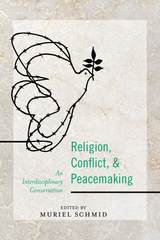 Religion, Conflict, and Peacemaking: An Interdisciplinary Conversation
Muriel Schmid
University of Utah Press, 2017 Discussions of the relationship between religion and violence have been on the rise since 9/11. Conversations have also focused on how religion can mediate conflict and help build peace. This volume offers a diversity of approaches to the subject, gathering essays from a cross-section of prominent scholars studying the role of religion in peacemaking.
Contributors from varied backgrounds share perspectives and insights gleaned from history, theory, practice, and case studies. While the authors acknowledge the role of religion in generating conflict, they emphasize the part religion can play in conflict resolution. Addressing the centrality of conflict to the human condition, they recognize the consequent difficulty in teasing out the exact role of religion. Overall, the authors assert the necessity of frank, knowledgeable dialogue to understanding sources of, finding grounds for resolving, and managing conflict. Many of the essayists offer creative solutions for building peace. Employing examples and viewpoints drawn from diverse faith traditions, academic traditions, and cultural backgrounds, contributors seek to foster respectful dialogue and debate by exploring the complex dynamic that interconnects religion, violence, and peace.
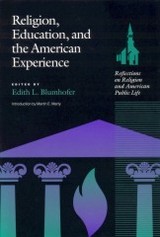 Religion, Education and the American Experience: Reflections on Religion and the American Public Life
Edith L. Blumhofer
University of Alabama Press, 2002 This collection of provocative and timely essays addresses the ways in which religious and educational institutions have come to define one another and American culture and identity. Education in America-public and private, from the elementary to the university level-is the subject of urgent, ongoing debates. School vouchers, home schooling, prayer in the classrooms, sex education in the schools, and evolution versus creationism are just a few of the touchstones and flashpoints that have ignited a national dialogue concerning the role of religion in U.S. educational institutions. The ten major essays assembled here emerged from a series of conferences conducted by the Public Religion Project at the University of Chicago Divinity School, funded by a grant from The Pew Charitable Trust. Written by recognized leaders in the fields of education and religion, the essays address such issues as the role of religious studies programs in tax-supported public universities; the evolving role of the university chaplain; the impact of religious doctrine on literary scholarship and the natural sciences; the college president as a spiritual leader; the secularization of private colleges whose foundations rest in the spiritual mission of a specific church or denomination and, conversely, the obligations, if any, of colleges that have maintained distinct denominational identities toward pluralistic outreach and openness; and an examination of the home schooling movement. A true "dialogue" designed to inspire readers to rethink, argue, act, and continually converse on the subject, Religion, Education, and the American Experience will appeal to educators, college and university administrators, and boards of trustees, as well as academic libraries and scholars of education and religious studies.
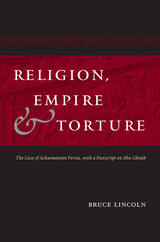 Religion, Empire, and Torture: The Case of Achaemenian Persia, with a Postscript on Abu Ghraib
Bruce Lincoln
University of Chicago Press, 2007 How does religion stimulate and feed imperial ambitions and violence? Recently this question has acquired new urgency, and in Religion, Empire, and Torture, Bruce Lincoln approaches the problem via a classic but little-studied case: Achaemenian Persia.
Lincoln identifies three core components of an imperial theology that have transhistorical and contemporary relevance: dualistic ethics, a theory of divine election, and a sense of salvific mission. Beyond this, he asks, how did the Achaemenians understand their place in the cosmos and their moral status in relation to others? Why did they feel called to intervene in the struggle between good and evil? What was their sense of historic purpose, especially their desire to restore paradise lost? And how did this lead them to deal with enemies and critics as imperial power ran its course? Lincoln shows how these religious ideas shaped Achaemenian practice and brought the Persians unprecedented wealth, power, and territory, but also produced unmanageable contradictions, as in a gruesome case of torture discussed in the book’s final chapter. Close study of that episode leads Lincoln back to the present with a postscript that provides a searing and utterly novel perspective on the photographs from Abu Ghraib.
Religion, Families, and Health: Population-Based Research in the United States
Ellison, Christopher G
Rutgers University Press, 2010 Religion is a major social institution in the United States. While the scientific community has experienced a resurgence in the idea that there are important linkages between religion and family life and religion and health outcomes, this area of study is still in its early stages of development, scattered across multiple disciplines, and of uneven quality. To date, no book has featured both reviews of the literature and new empirical findings that define this area for the present and set the agenda for the twenty-first century. Religion, Families, and Health fills this void by bringing together leading social scientists who provide a theoretically rich, methodologically rigorous, and exciting glimpse into a fascinating social institution that continues to be extremely important in the lives of Americans.
Religion, Fundamentalism, and Violence: An Interdisciplinary Dialogue
Edited by Andrew L. Gluck
University of Scranton Press, 2010 In Religion, Fundamentalism, and Violence, Andrew Gluck brings together distinguished scholars to address a fiercely debated topic: the intersection of religion and violence. Among the contributions is an anthropological analysis of the violence associated with the Abrahamic monotheistic religions of the Middle East, a compelling essay accounting for the violence in Hindu religious traditions, an informative look at the Israeli-Palestinian tensions of more recent times, and an essay on the Catholic just war theory. Each chapter is followed by a commentary and reply, making this volume indispensable for students and scholars of the history of religions.
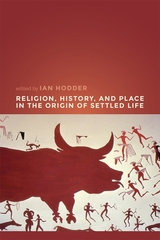 Religion, History, and Place in the Origin of Settled Life
Ian Hodder
University Press of Colorado, 2018 This volume explores the role of religion and ritual in the origin of settled life in the Middle East, focusing on the repetitive construction of houses or cult buildings in the same place. Prominent archaeologists, anthropologists, and scholars of religion working at several of the region’s most important sites—such as Çatalhöyük, Göbekli Tepe, Körtik Tepe, and Aşıklı Höyük—contend that religious factors significantly affected the timing and stability of settled economic structures.
Contributors argue that the long-term social relationships characteristic of delayed-return agricultural systems must be based on historical ties to place and to ancestors. They define different forms of history-making, including nondiscursive routinized practices as well as commemorative memorialization. They consider the timing in the Neolithic of an emerging concern with history-making in place in relation to the adoption of farming and settled life in regional sequences. They explore whether such correlations indicate the causal processes in which history-making, ritual practices, agricultural intensification, population increase, and social competition all played a role.
Religion, History, and Place in the Origin of Settled Life takes a major step forward in understanding the adoption of farming and a settled way of life in the Middle East by foregrounding the roles of history-making and religious ritual. This work is relevant to students and scholars of Near Eastern archaeology, as well as those interested in the origins of agriculture and social complexity or the social role of religion in the past.
Contributors: Kurt W. Alt, Mark R. Anspach, Marion Benz, Lee Clare, Anna Belfer-Cohen, Morris Cohen, Oliver Dietrich, Güneş Duru, Yilmaz S. Erdal, Nigel Goring-Morris, Ian Hodder, Rosemary A. Joyce, Nicola Lercari, Wendy Matthews, Jens Notroff, Vecihi Özkaya, Feridun S. Şahin, F. Leron Shults, Devrim Sönmez, Christina Tsoraki, Wesley Wildman
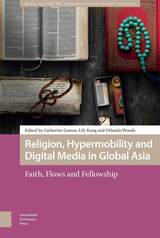 Religion, Hypermobility and Digital Media in Global Asia: Faith, Flows and Fellowship
Catherine Gomes
Amsterdam University Press, 2020 Digital media is changing the ways in which religion is practiced, understood, proselytised and countered. Religious institutions and leaders use digital media to engage with their congregations who now are not confined to single locations and physical structures. The faithful are part of online communities which allow them a space to worship and to find fellowship. Migrant and mobile subjects thus are able to be connected to their faith -- whether home grown or emerging -- wherever they may be, providing them with an anchor in unfamiliar physical and cultural surroundings. As Asia rises, mobilities associated with Asian populations have escalated. The notion of ‘Global Asia’ is a reflection of this increased mobility, where Asia includes not only Asian countries as sites of political independence, but also the transnational networks of Asian trans/migrants, and the diasporic settlements of Asian peoples all over the world. This collection features cutting edge research by scholars across disciplines seeking to understand the role and significance of religion among transnational mobile subjects in this age of digital media, and in particular, as experienced in Global Asia.
 Religion in a Technical Age
Samuel H. Miller
Harvard University Press “A technical age is a new thing in history. Inevitably it will change the shape and dimension of faith.” Taken together the twelve essays in this volume present a provocative and refreshingly humane approach to the problem of incorporating a vital religion in a technical culture and to the equally pressing need for training men in the kind of ministry that will help people find their spiritual balance in a world where many of the old supporting certainties have been undermined.
Samuel H. Miller begins with the assumption that a radical revolution in Western culture has altered both the habits of thought and the patterns of action for modern man. He then discusses the significance of the tremendous gap between the satisfactions and motivations of traditional religion and the present dynamics of life that seems quite suddenly to have rendered obsolete the entire religious institution and its ministry. The reaffirmation of religious values, the author believes, can only be accomplished by developing large and bold new syntheses of truth, new symbolic structures, which will encompass science, art, and religion without compromising their distinctive roles.
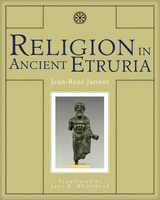 Religion in Ancient Etruria
Jean-René Jannot, Translated by Jane K. Whitehead
University of Wisconsin Press, 2005 This lively translation of Devins, Dieux et Démons is the first English-language edition of Jean-René Jannot’s highly informative examination of Etruscan religion. Jannot tackles this elusive subject within three major constructs—death, ritual, and the nature of the gods—and presents recent discoveries in an accessible format. Jane K. Whitehead’s translation updates Jannot’s innovative text and introduces readers of all types—students, scholars, and the general audience—to this thorough overview of ancient Etruscan beliefs, including the afterlife, funerary customs, and mythology.
Provocative insights and thoughtful discussions contribute to an understanding of the prophetic nature of Etruscan culture. Jannot investigates the elaborate systems of defining space and time that so distinctly characterize this ancient society. Religion in Ancient Etruria offers a unique perspective that illuminates the origins of some of our own "modern" religious beliefs.
This updated edition includes more than 100 illustrations that demonstrate early temples, statues, mirrors, tablets, and sculptures.
1998 French edition, Picard
Religion in Ancient Mesopotamia
Jean Bottéro
University of Chicago Press, 2001 One of the world's foremost experts on Assyriology, Jean Bottéro has studied the religion of ancient Mesopotamia for more than fifty years. Building on these many years of research, Bottéro here presents the definitive account of one of the world's oldest known religions. He shows how ancient Mesopotamian religion was practiced both in the public and private spheres, how it developed over the three millennia of its active existence, and how it profoundly influenced Western civilization, including the Hebrew Bible.
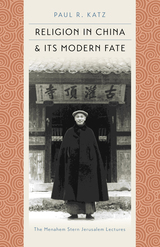 Religion in China and Its Modern Fate
Paul R. Katz
Brandeis University Press, 2014 Paul R. Katz has composed a fascinating account of the fate of Chinese religions during the modern era by assessing mutations of communal religious life, innovative forms of religious publishing, and the religious practices of modern Chinese elites traditionally considered models of secular modernity. The author offers a rare look at the monumental changes that have affected modern Chinese religions, from the first all-out assault on them during the 1898 reforms to the eve of the Communist takeover of the mainland. Tracing the ways in which the vast religious resources (texts, expertise, symbolic capital, material wealth, etc.) that circulated throughout Chinese society during the late imperial period were reconfigured during this later era, Katz sheds new light on modern Chinese religious life and the understudied nexus between religion and modern political culture. Religion in China and Its Modern Fate will appeal to a broad audience of religionists and historians of modern China.
Religion in Dutch Society 2005: Documentation of a National Survey on Religious and Secular Attitudes and Behaviour
Edited by R. Eisinga, et al.
Amsterdam University Press, 2014 This data guide exhaustively documents the results of a 2005 survey of religious and secular attitudes and behavior in the Netherlands. The data files and additional documentation can be downloaded from EASY, the online archiving system of the Institute of the Royal Netherlands Academy of Arts and Sciences Data Archiving and Networked Services (DANS). DANS promotes sustained access to digital research results and encourages scientific researchers to systematically archive and reuse data.
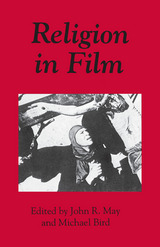 Religion in Film
John R. May
University of Tennessee Press, 1982 This carefully edited collection of essays explores, in greater diversity and depth than has been attempted before, the relationship between film and religion. Combining perspectives from traditional film criticism and from religious studies, Religion in Film asserts that it is no longer possible to view films simply in terms of their moral impact, nor is it reasonable to limit religious meaning only to those films that make an explicit appeal to religious elements.
The essays offer a variety of theoretical reflections on the religious interpretation of film, explore particular cinematic variations on the archetypal images of savior and demon, analyze significant cultural trends of a religious nature related to film, and assess thirteen sensibilities—Altman, Bergman, Bunuel, Chaplin, Coppola, Fellini, Hitchcock, Jutra, Kubrick, Peckinpah, Russell, Truffaut, and Wertmuller. The contributors provide a firm basis for analysis while respecting a variety in interpretation.
As the overall structure of the book leads from the universal to the particular, from theory to individual directors and films, so its concern with religious interpretation flows naturally from the universally religious to particular religious worldviews. Among world religions, Christianity claims attention in proportion to its dominant cultural influence in the West where film has more obviously flourished.
The insights and interpretations presented in these essays will be of importance to cinema scholars, film critics, and students of religion and of interest to film buffs, particularly those who are sensible of the religious dimension of films.
 Religion in Human Evolution: From the Paleolithic to the Axial Age
Robert N. Bellah
Harvard University Press, 2011 A New York Times Book Review Editors’ Choice
An ABC Australia Best Book on Religion and Ethics of the Year
Distinguished Book Award, Sociology of Religion Section of the American Sociological Association
Religion in Human Evolution is a work of extraordinary ambition—a wide-ranging, nuanced probing of our biological past to discover the kinds of lives that human beings have most often imagined were worth living. It offers what is frequently seen as a forbidden theory of the origin of religion that goes deep into evolution, especially but not exclusively cultural evolution.
“Of Bellah’s brilliance there can be no doubt. The sheer amount this man knows about religion is otherworldly…Bellah stands in the tradition of such stalwarts of the sociological imagination as Emile Durkheim and Max Weber. Only one word is appropriate to characterize this book’s subject as well as its substance, and that is ‘magisterial.’”
—Alan Wolfe, New York Times Book Review
“Religion in Human Evolution is a magnum opus founded on careful research and immersed in the ‘reflective judgment’ of one of our best thinkers and writers.”
—Richard L. Wood, Commonweal
 Religion in Ohio: Profiles of Faith Communities
Tarunjit Singh Butalia
Ohio University Press, 2004 Religion in Ohio tells the story of Ohio’s religious and spiritual heritage going back to the state’s ancient and historic native populations, and including the westward migration of settlers to this region, the development of a wide variety of faith traditions in the years preceding the mid-twentieth century, and the arrival of newer immigrants in the last fifty years, each group bringing with it cherished traditions. Documenting religious pluralism in Ohio and the impact faith communities have had on the state, Religion in Ohio encompasses the historical experiences of many groups. Each chapter is the story of one of those communities written by a member of that faith or denomination. Operating under the auspices of the Ohio Bicentennial Commission and the Interfaith Association of Central Ohio, the editors of Religion in Ohio have created a unique collection of the experiences of faith groups during the two hundred years of Ohio’s statehood and the years leading up to it. The largely untold stories of religious experience in Ohio are gathered here in one volume so they may be appreciated in all their breadth and diversity. The Religious Experience Advisory Council of the Ohio Bicentennial Commission is one among twenty-two advisory councils established by the commission to commemorate Ohio’s bicentennial celebration. The council consists of more than twenty volunteers representing various faith traditions that have chosen Ohio to be their home. Tarunjit Singh Butalia and Dianne P. Small present the profiles of faith communities in a highly readable and accessible format. Religion in Ohio will be a lasting legacy of the Ohio Bicentennial and a valuable tool for understanding and appreciating the breadth of the religious pluralism in the state for years to come.
Religion in Plain View: Public Aesthetics of American Display
Sally M. Promey
University of Chicago Press, 2024 A revelatory critique of public display in the United States.
In Religion in Plain View, Sally M. Promey analyzes religion’s visible saturation of American public space and the histories that shaped this exhibitionary aesthetics. In street art, vehicle décor, signs, monuments, architecture, zoning policy, and more, Promey exposes American display’s merger of evangelicalism, capitalism, and imperialism. From this convergence, display materializes a distinctly American drive to advertise, claim territory, invalidate competitors, and fabricate a tractable national heritage. Charting this aesthetics’ strategic work as a Protestant technology of White nation formation, Religion in Plain View offers a dynamic critique of the ways public display perpetuates deeply ingrained assumptions about the proper shape of life and land in the United States.
 Religion in Public Life: A Dilemma for Democracy
Ronald F. Thiemann
Georgetown University Press, 1996 Prayer in public schools, abortion, gay and lesbian rights—these bitterly divisive issues dominate American politics today, revealing deep disagreements over basic moral values. In a highly readable account that draws on legal arguments, political theory, and philosophy, Ronald F. Thiemann explores the proper role of religious convictions in American public life. He proposes that religion can and should play an active, positive part in our society even as it maintains a fundamental commitment to pluralist, democratic values. Arguing that both increased secularism and growing religious diversity since the 1960s have fragmented commonly held values, Thiemann observes that there has been an historical ambivalence in American attitudes towards religion in public life. He proposes abandoning the idea of an absolute wall between church and state and all the conceptual framework built around that concept in interpreting the first amendment. He returns instead to James Madison's views and the Constitutional principles of liberty, equality, and toleration. Refuting both political liberalism (as too secular) and communitarianism (as failing to meet the challenge of pluralism), Thiemann offers a new definition of liberalism that gives religions a voice in the public sphere as long as they heed the Constitutional principles of liberty, equality, and toleration or mutual respect. The American republic, Thiemann notes, is a constantly evolving experiment in constructing a pluralistic society from its many particular communities. Religion can act as a positive force in its moral renewal, by helping to shape common cultural values. All those interested in finding solutions to today's divisive political discord, in finding ways to disagree civilly in a democracy, and in exploring the extent to which religious convictions should shape the development of public policies will find that this book offers an important new direction for religion and the nation.
|
|
